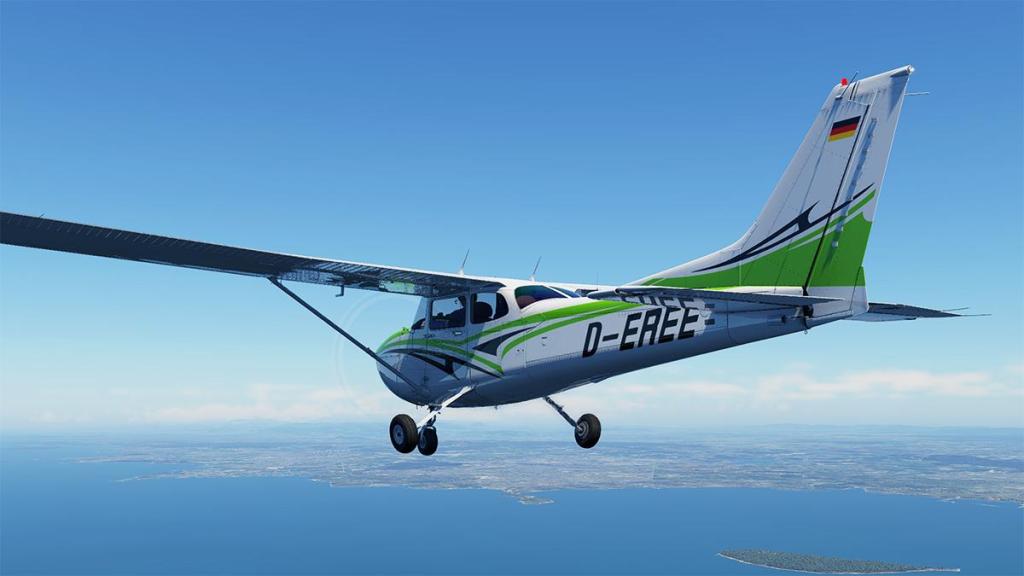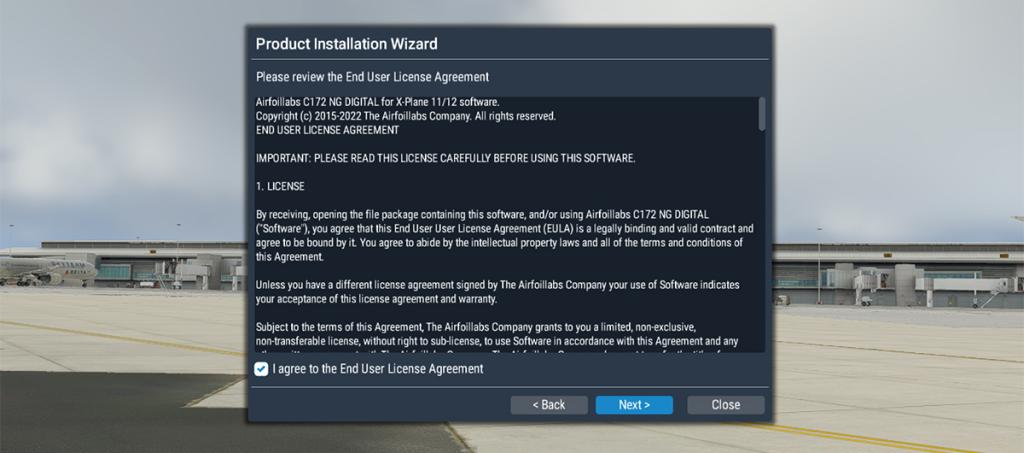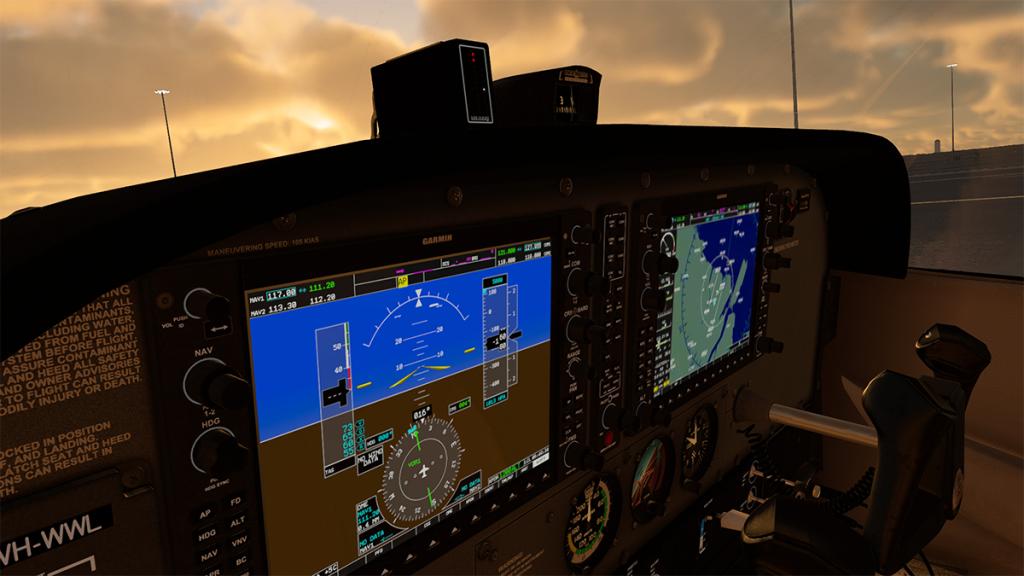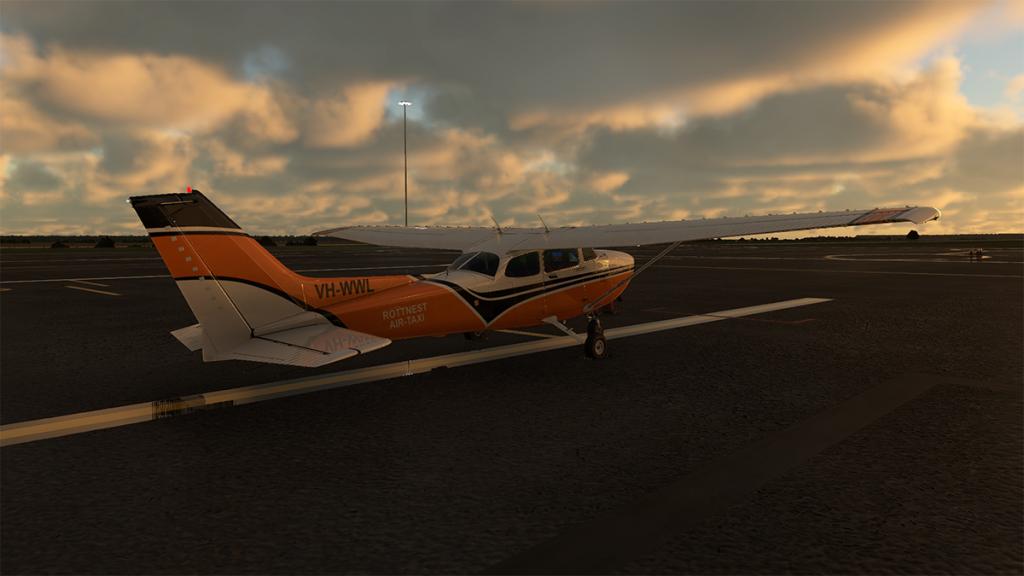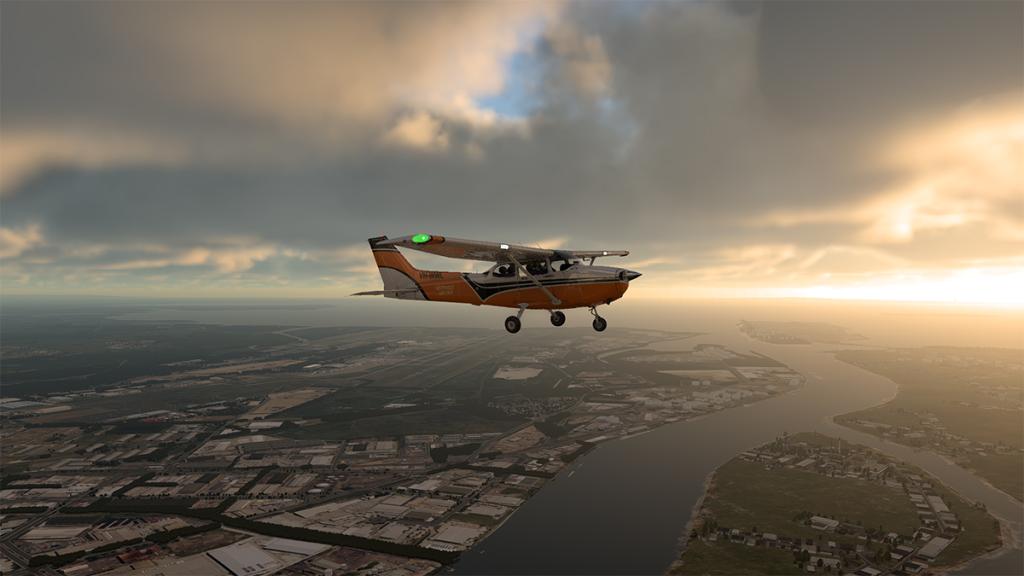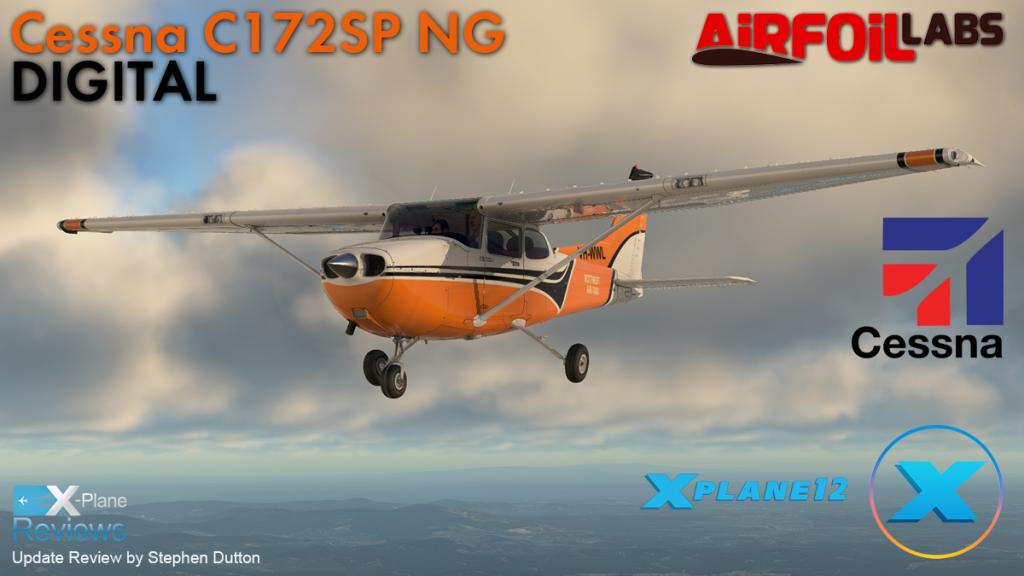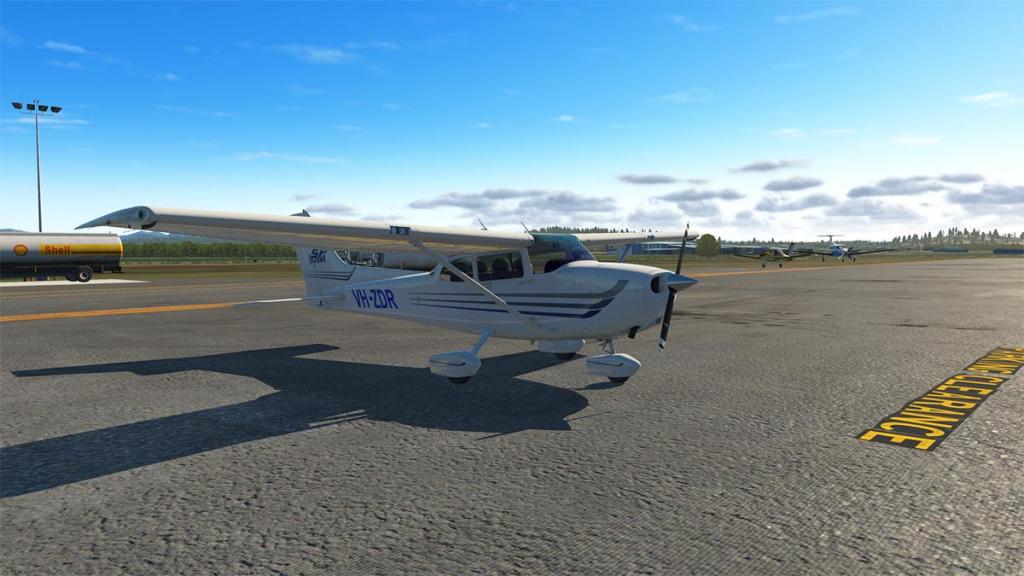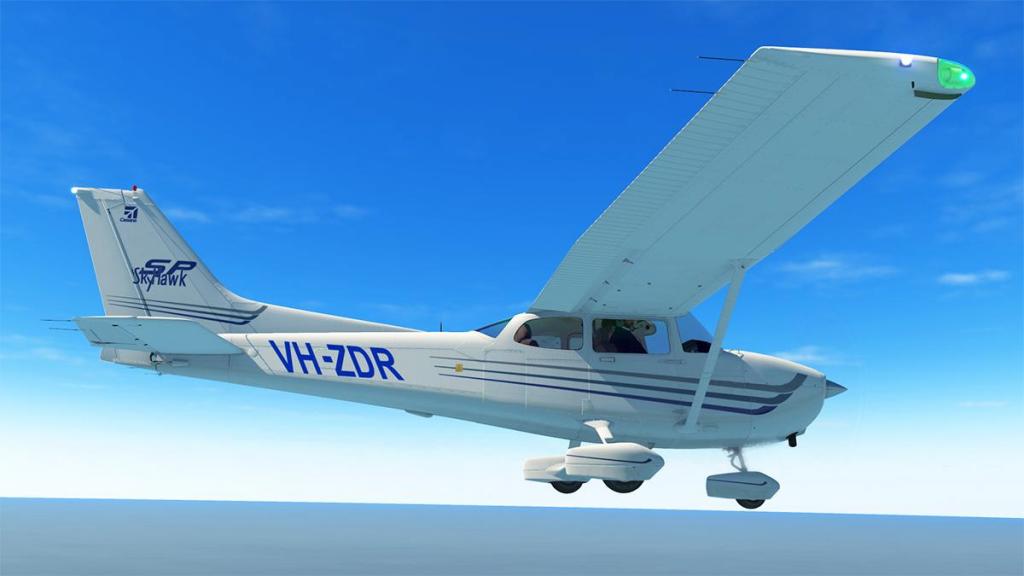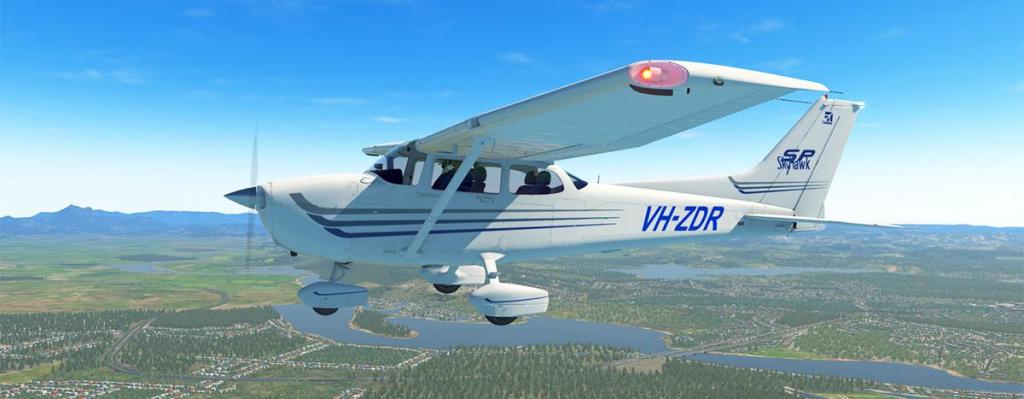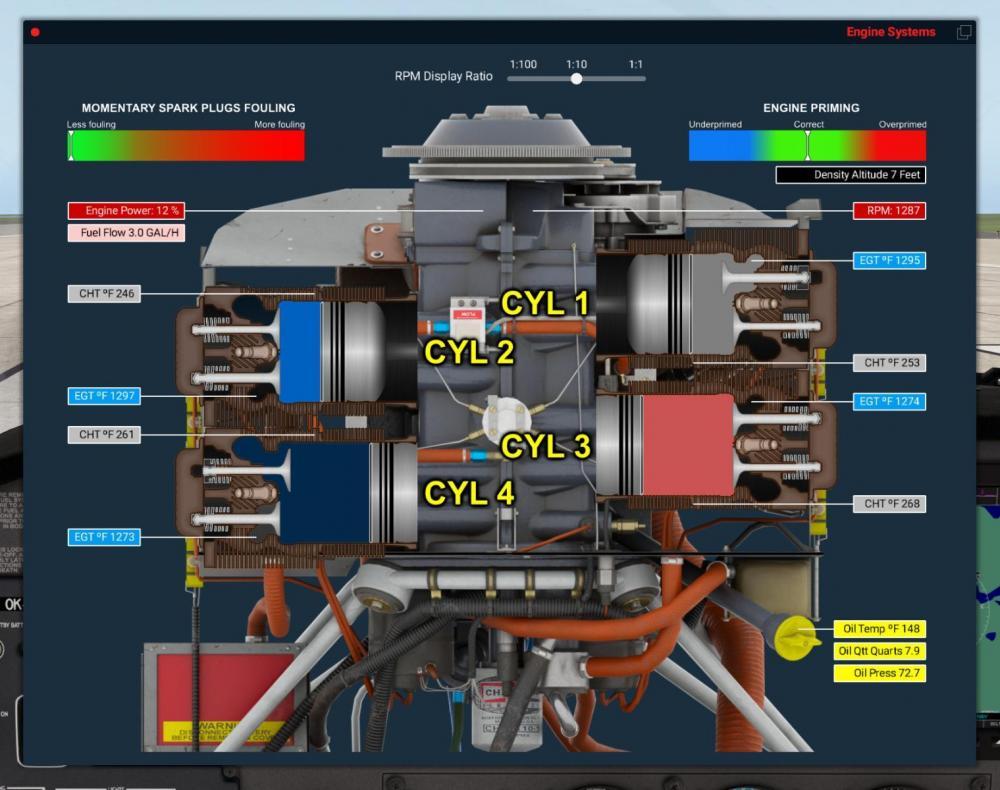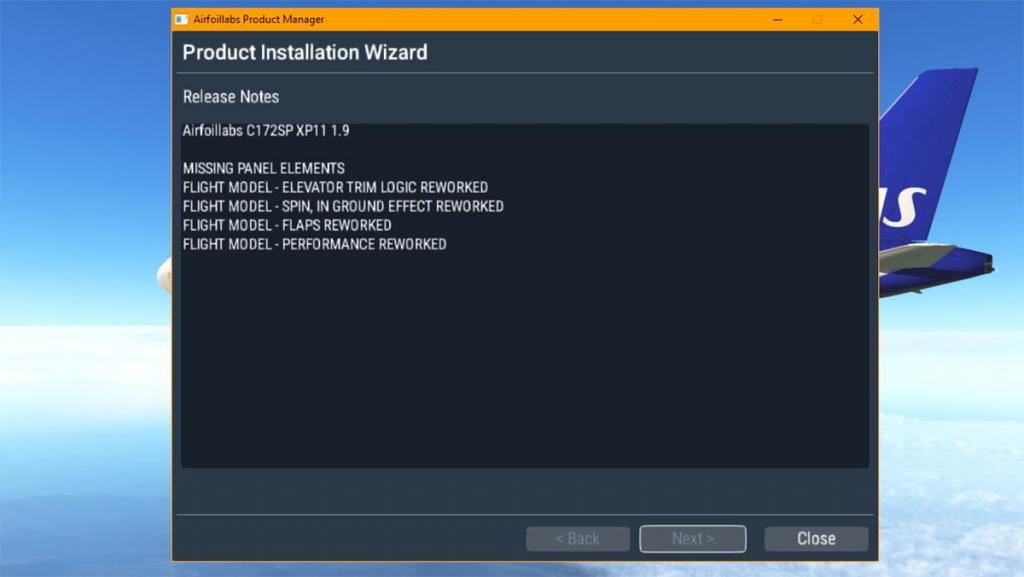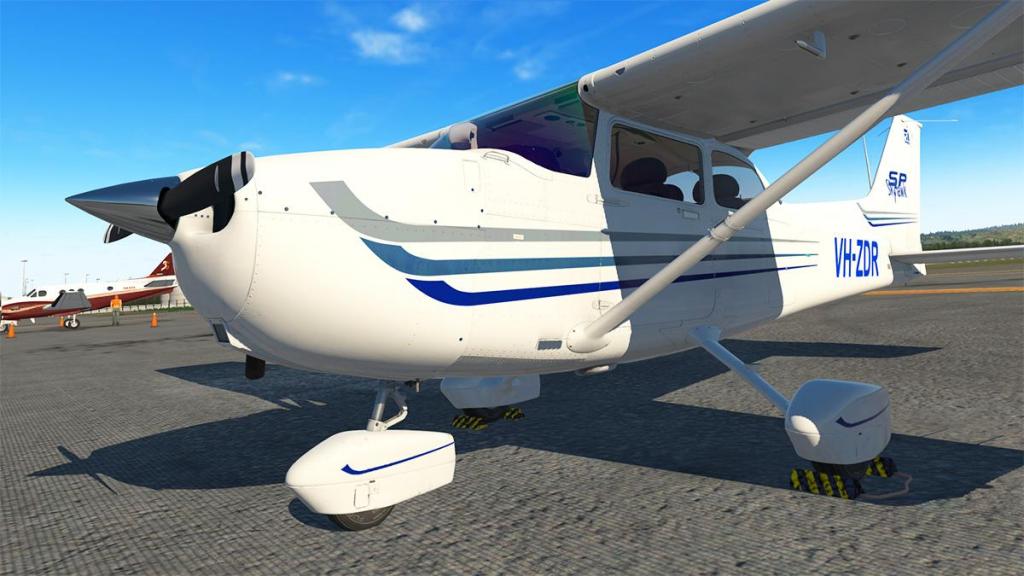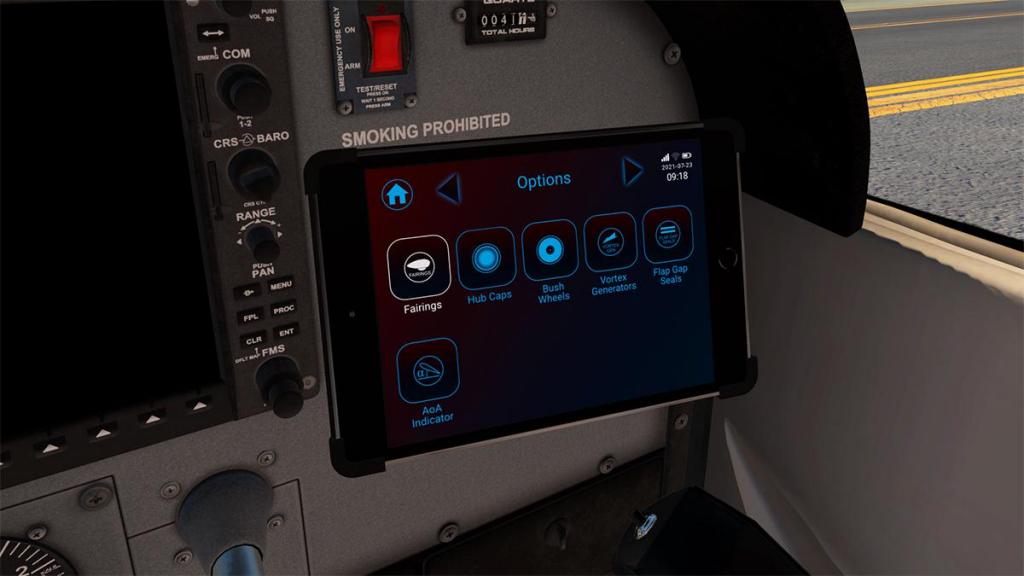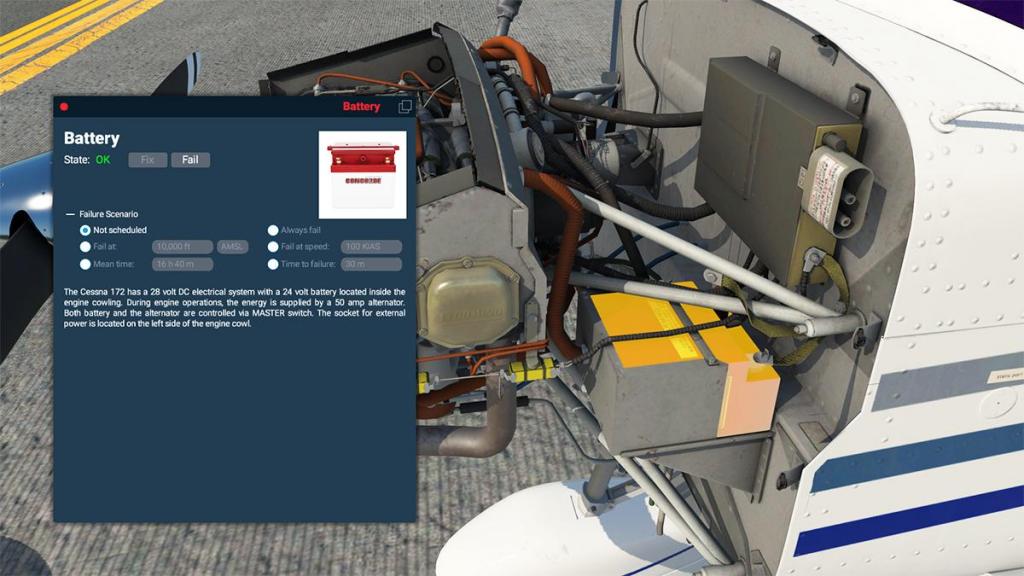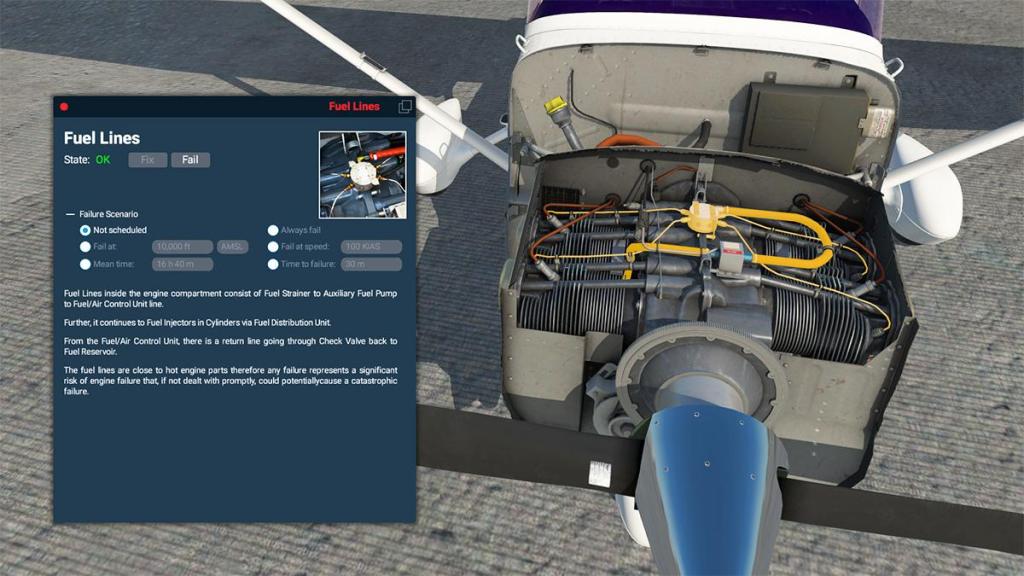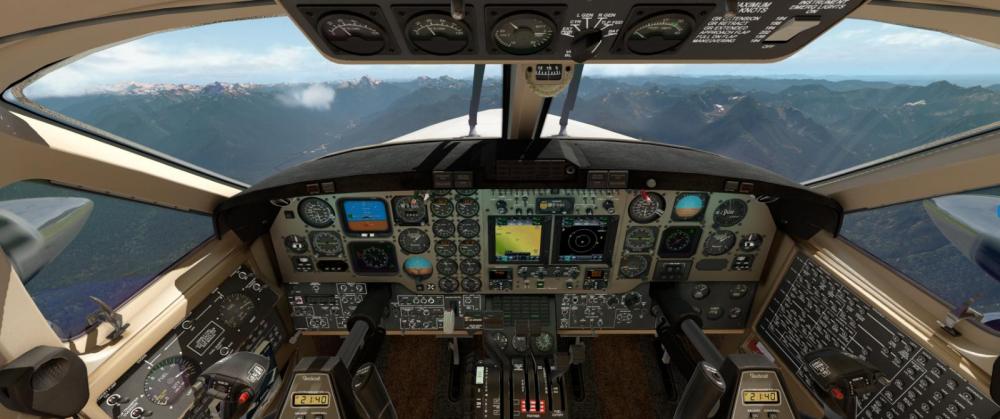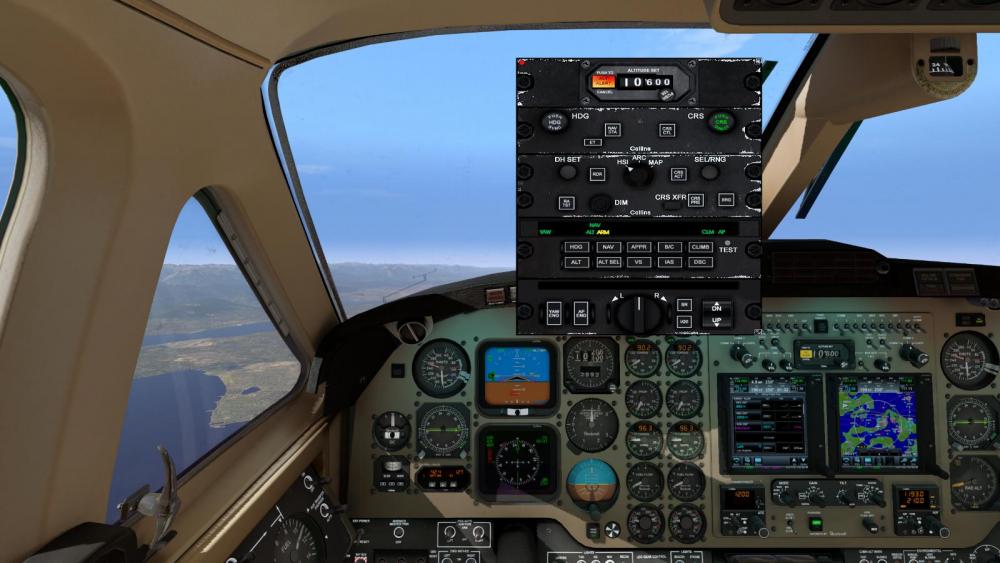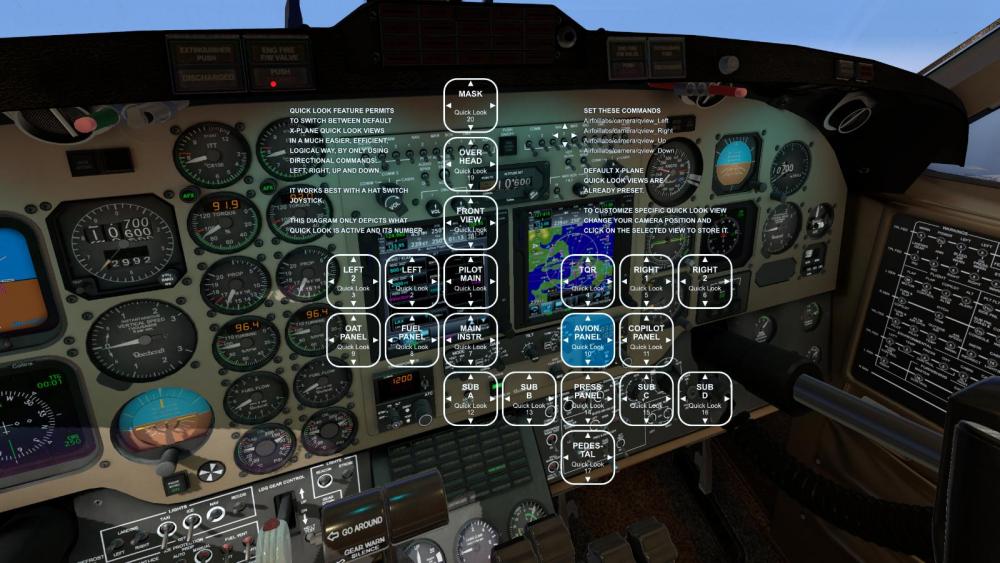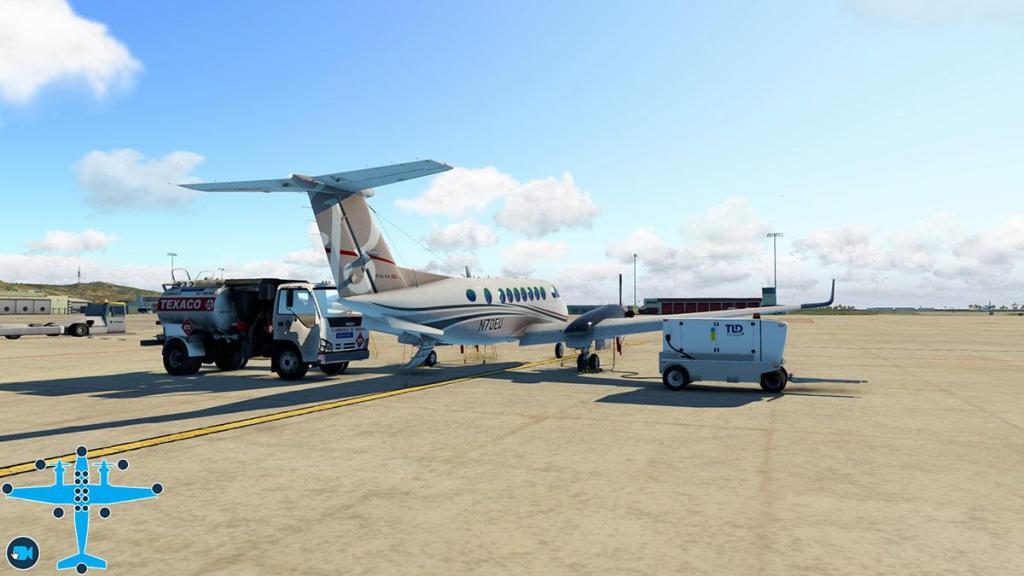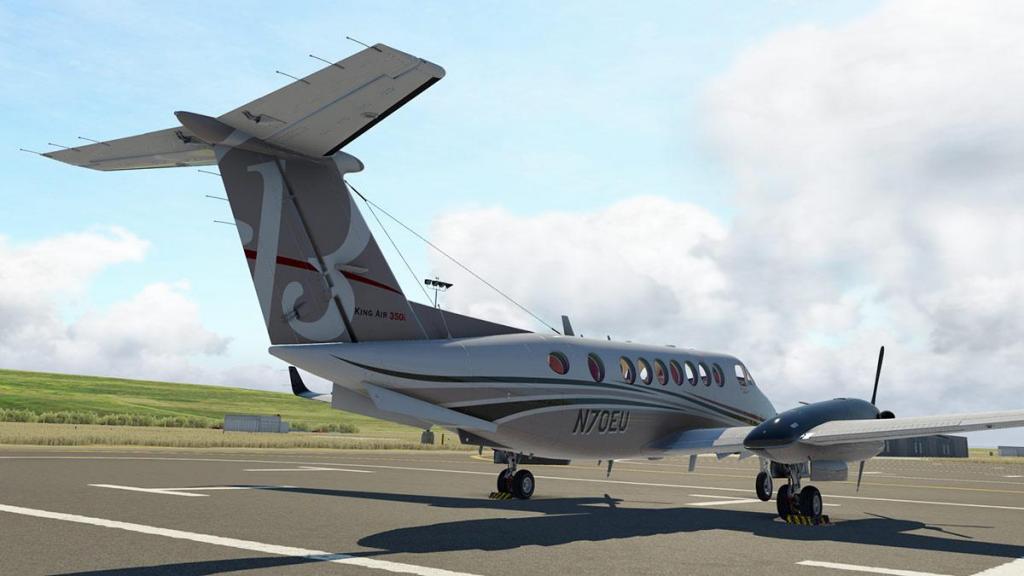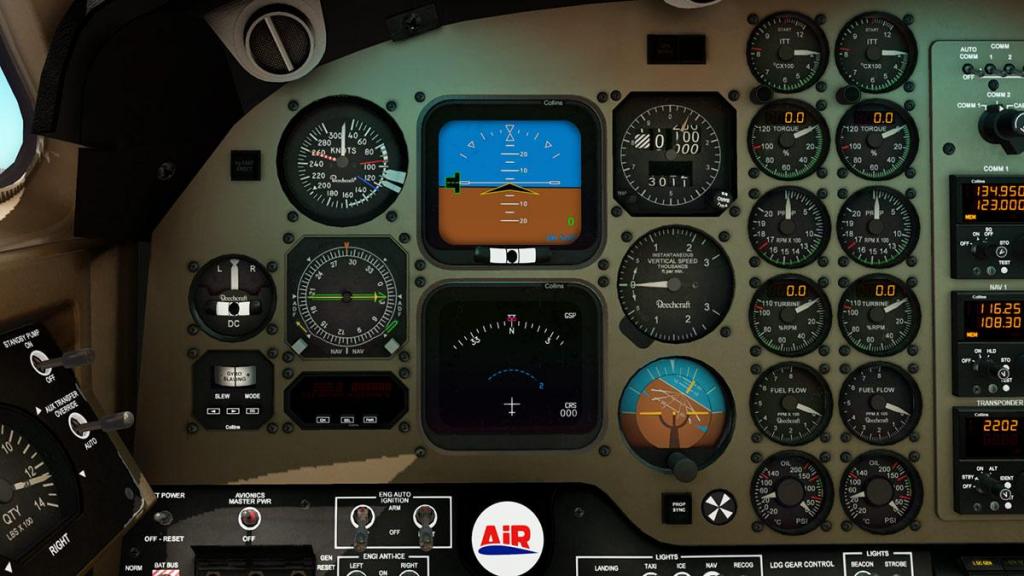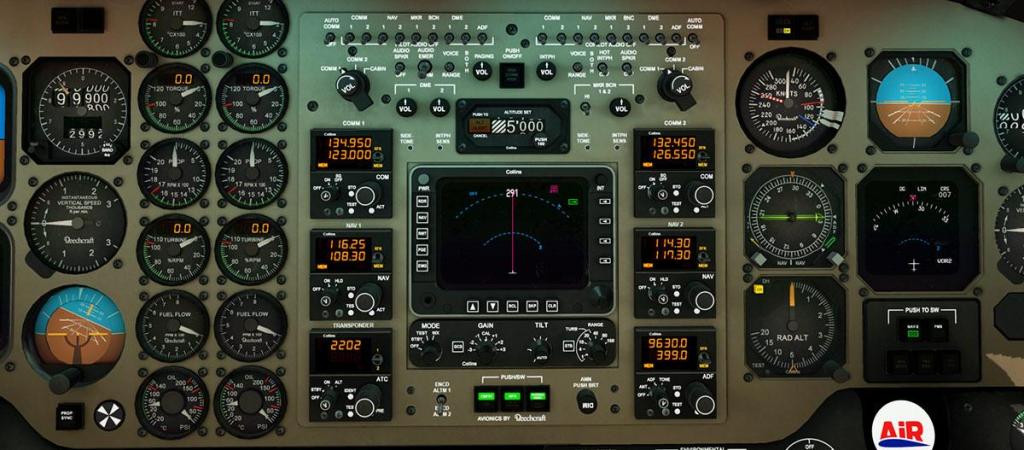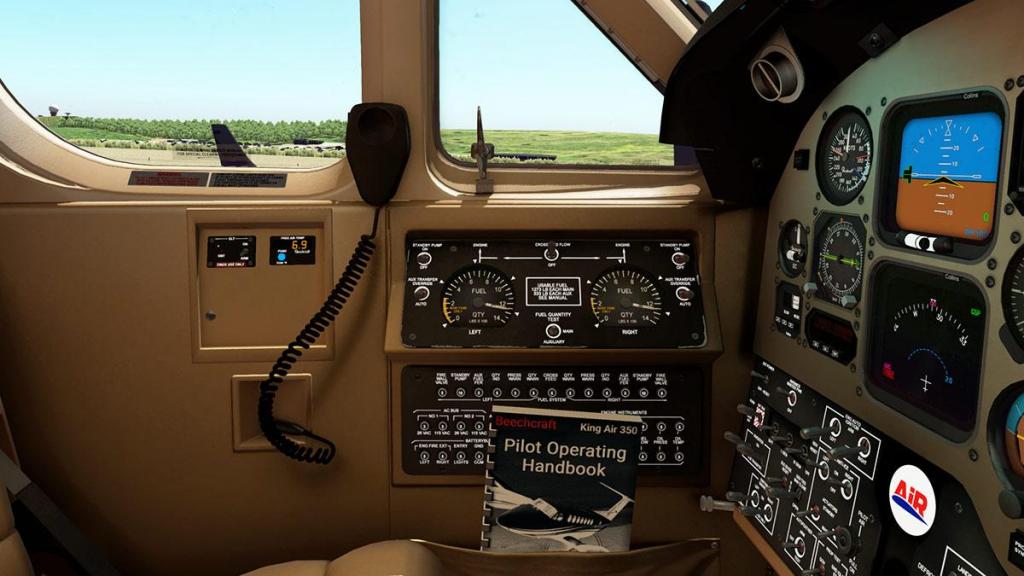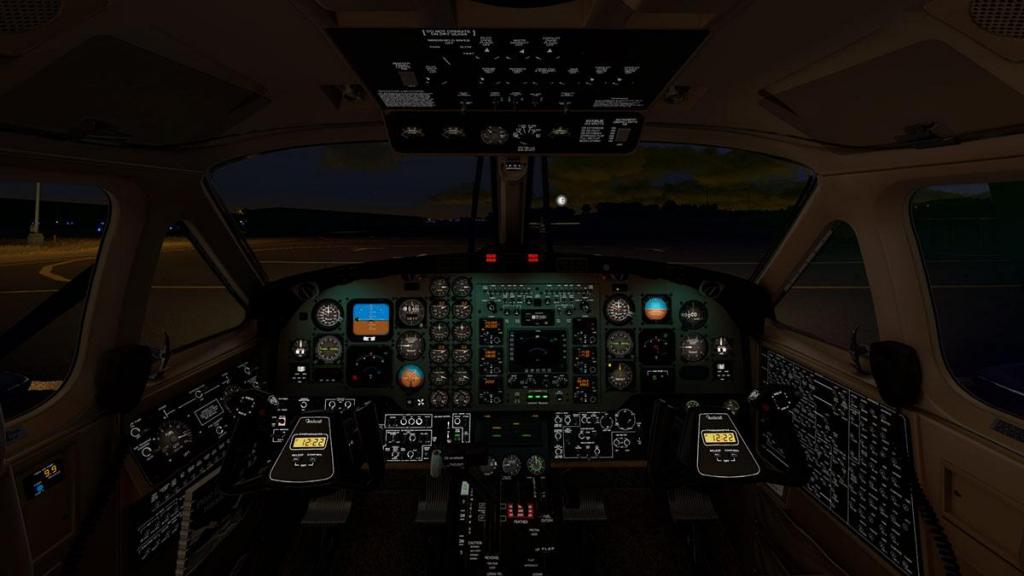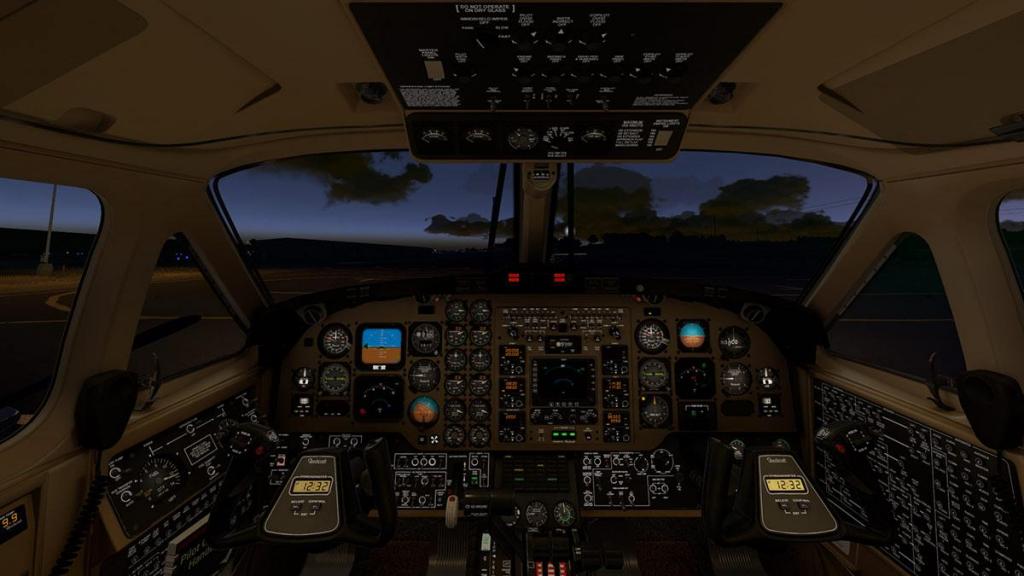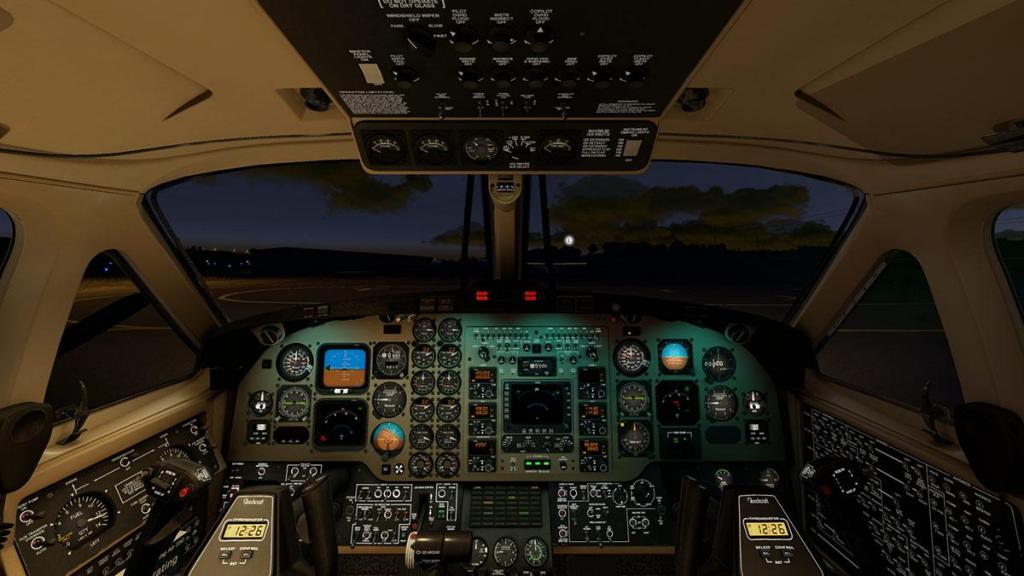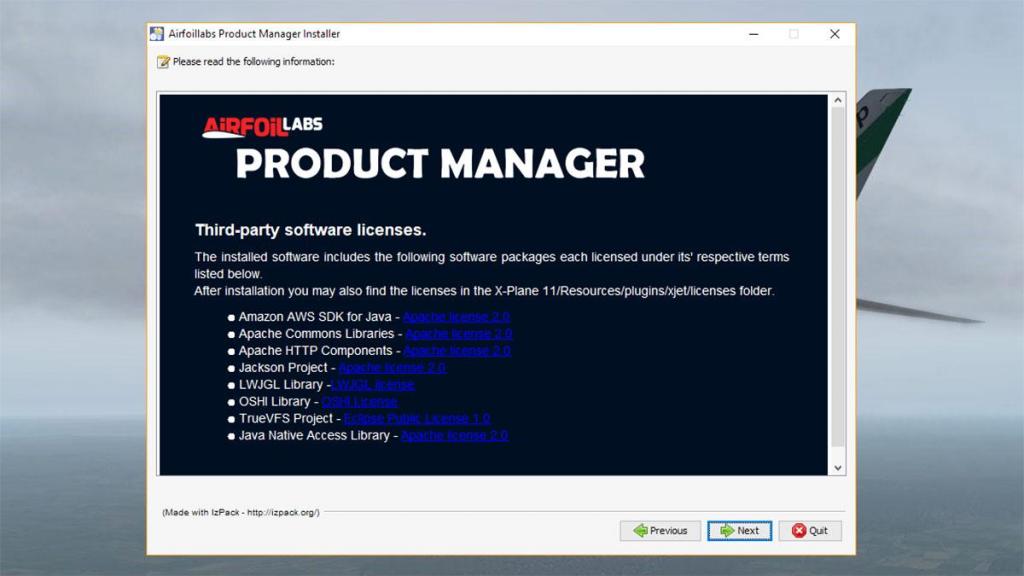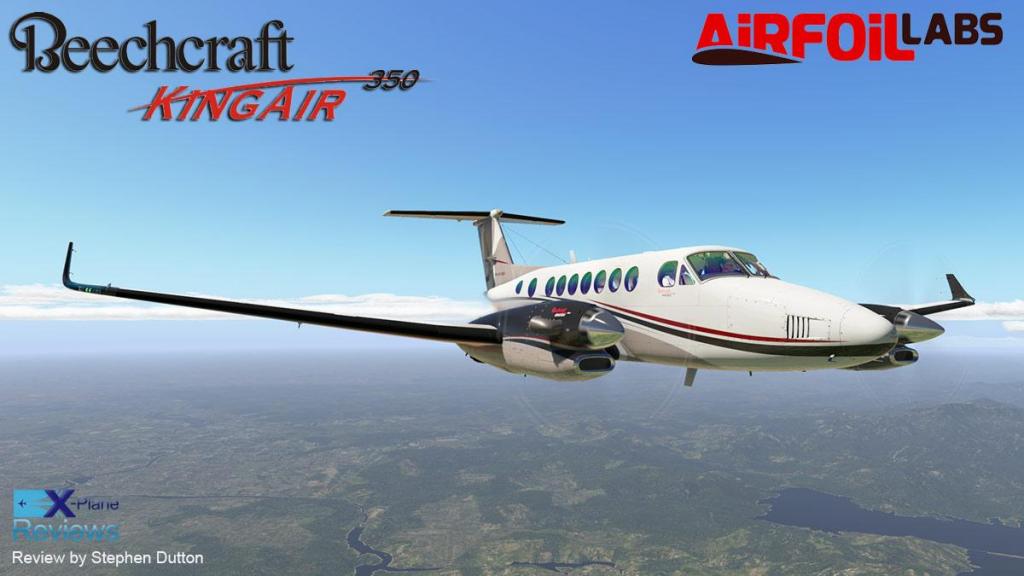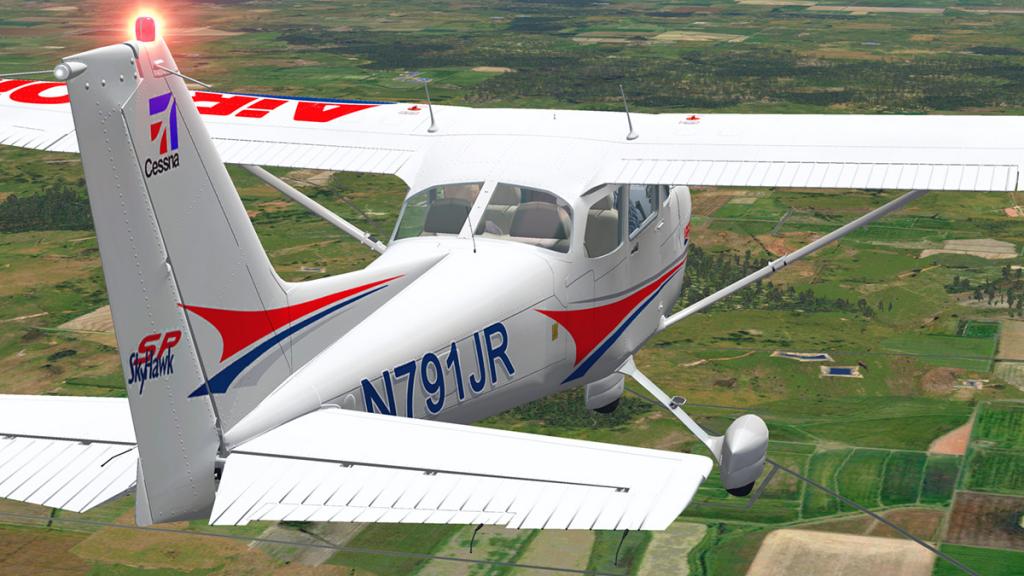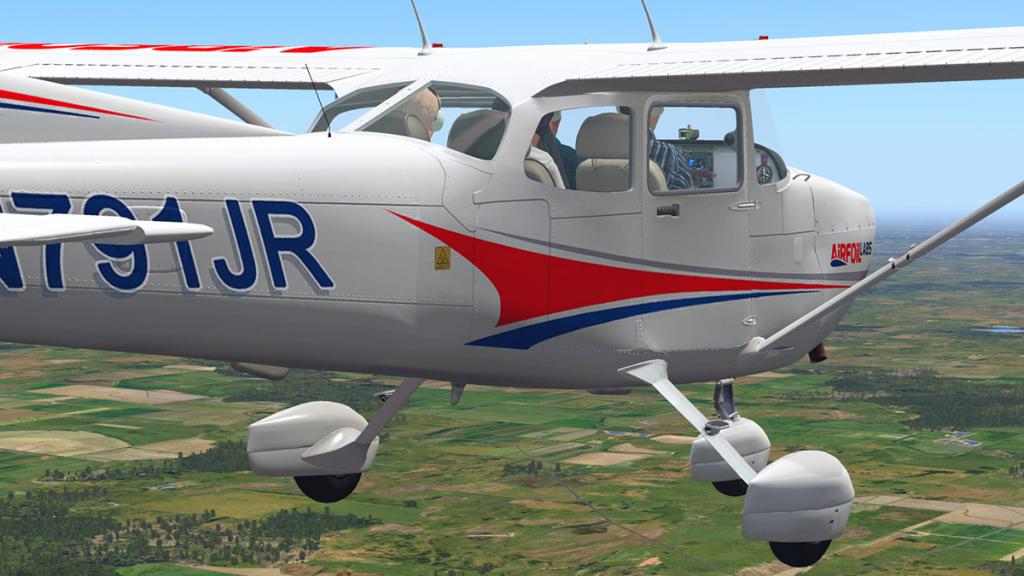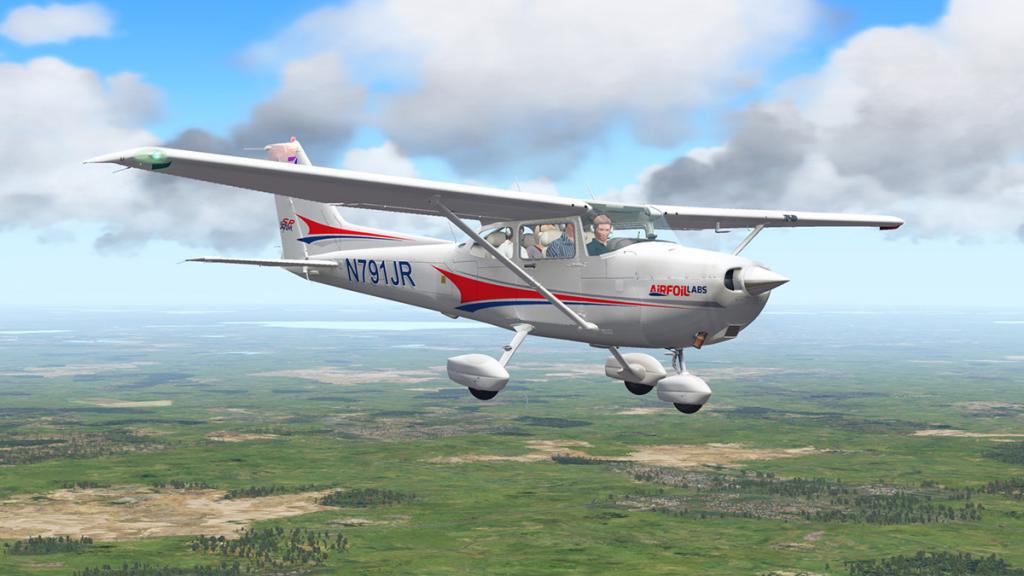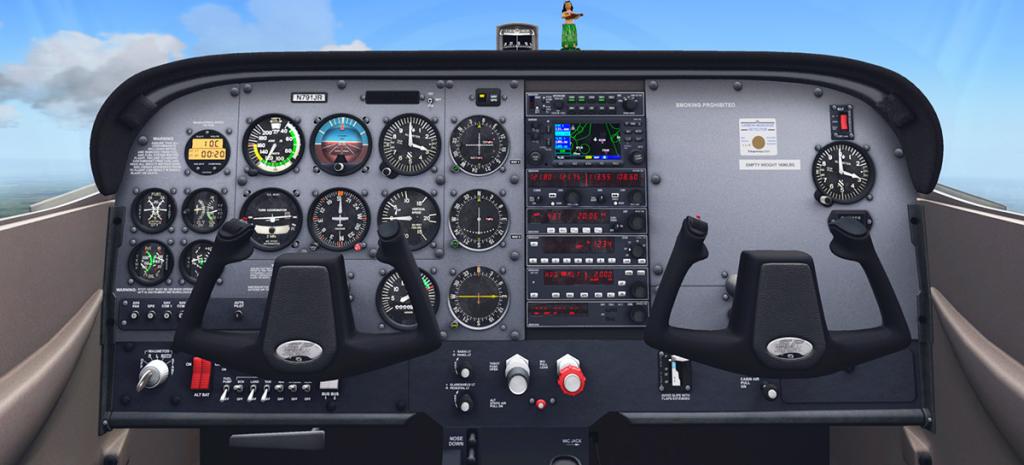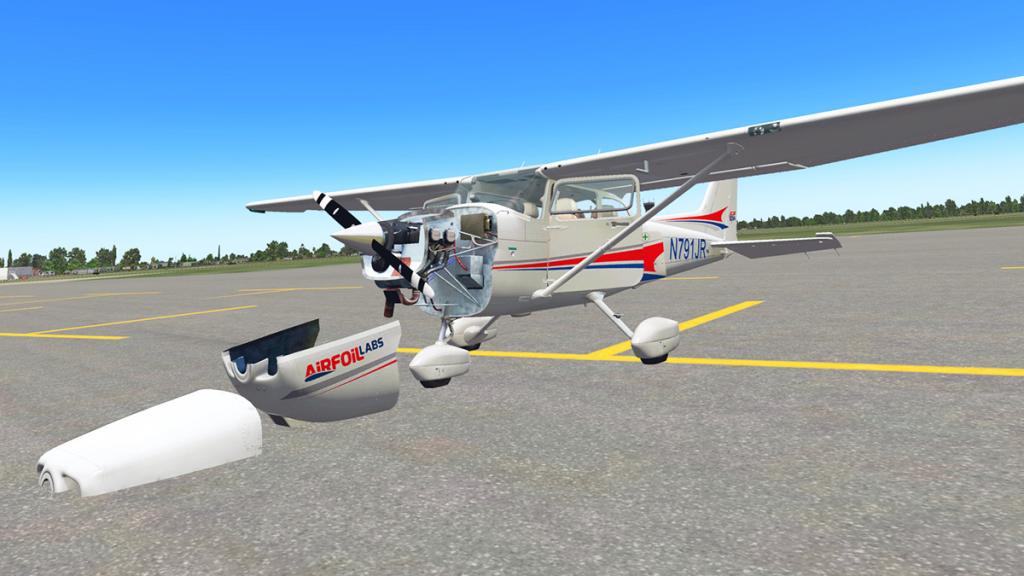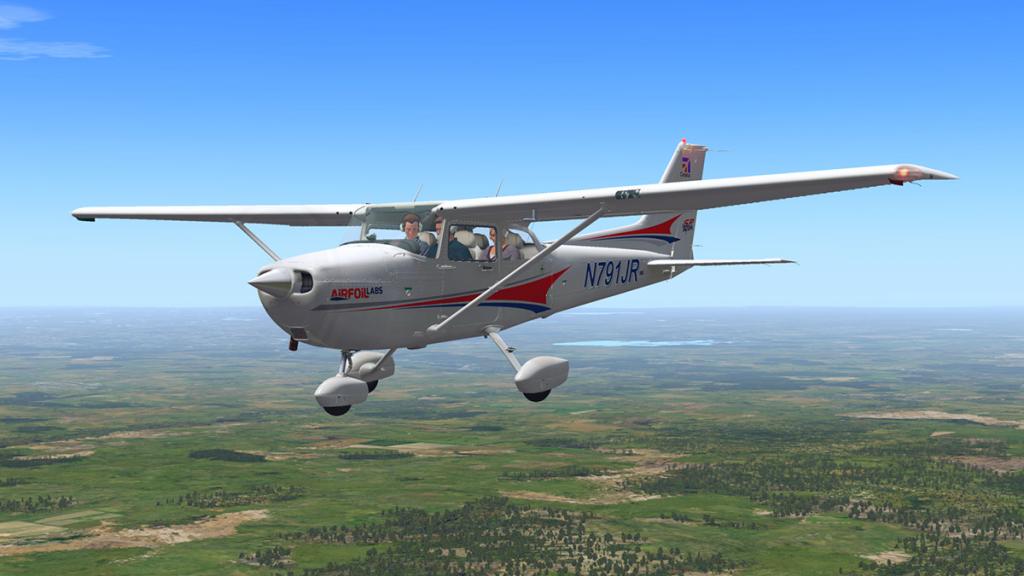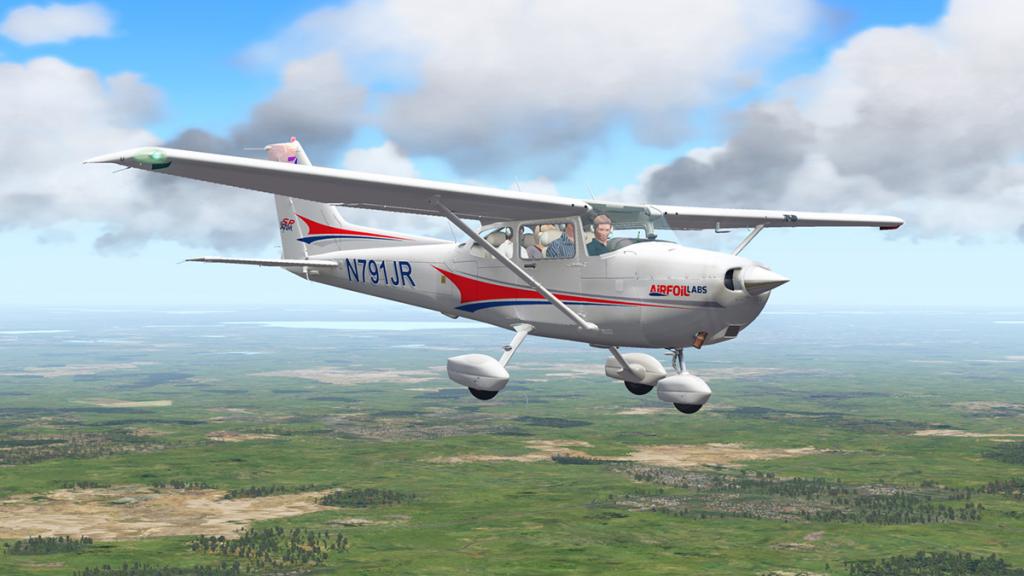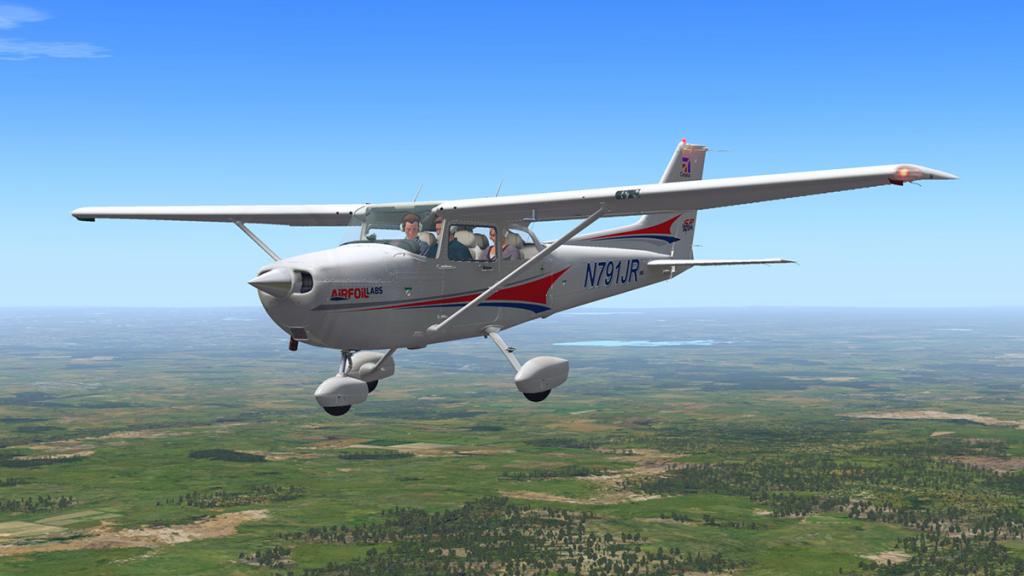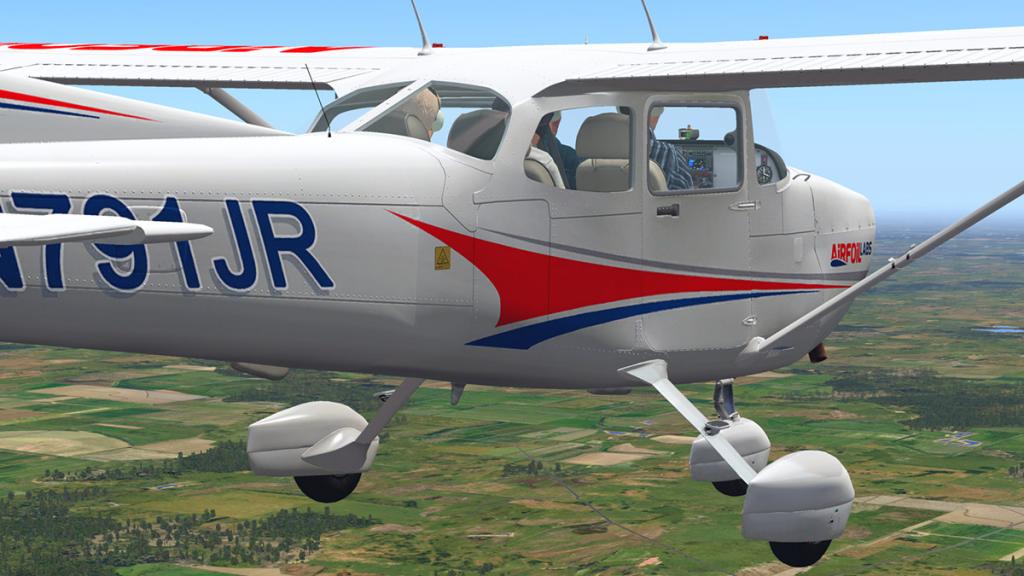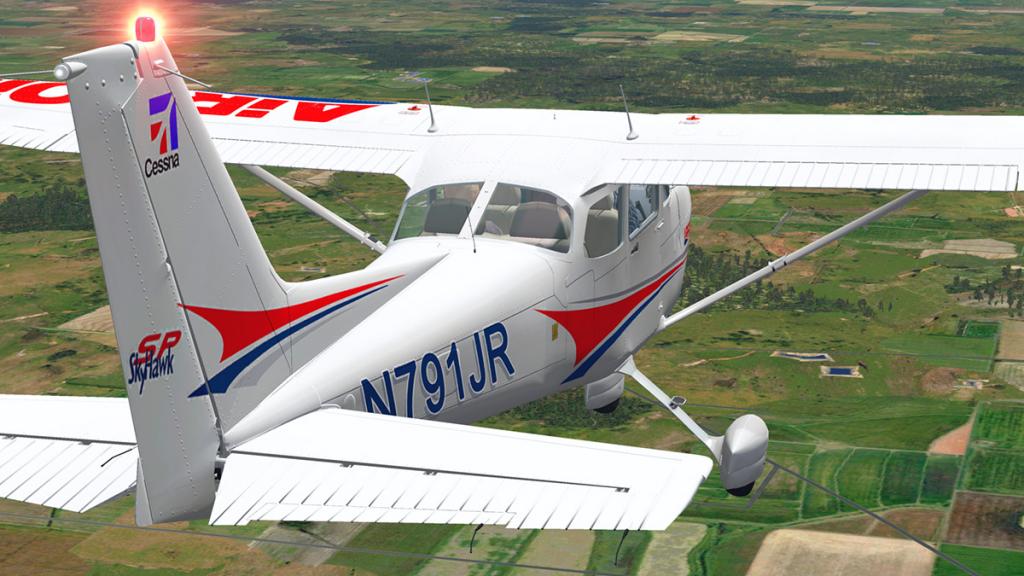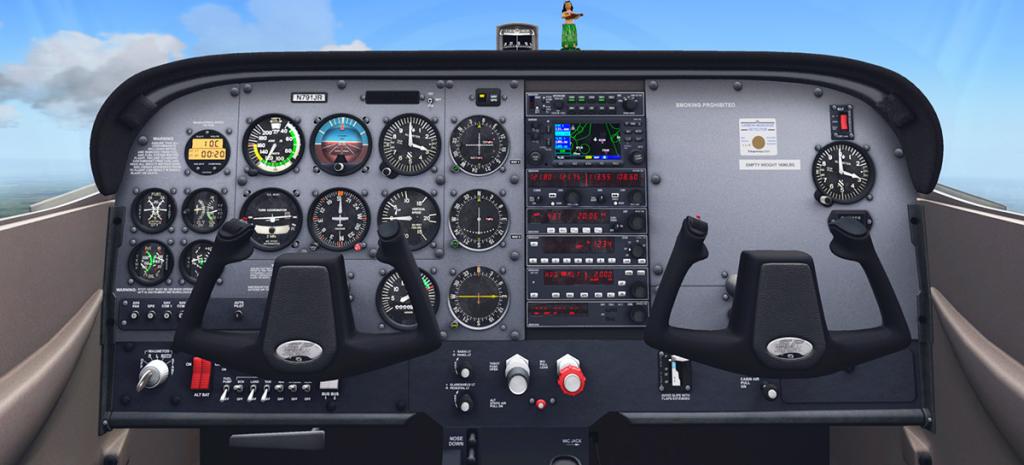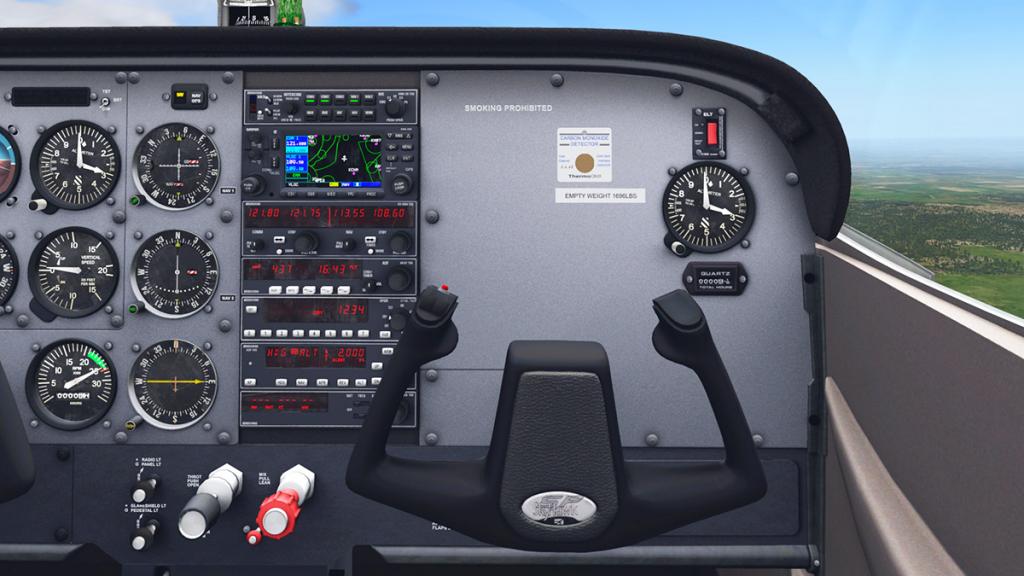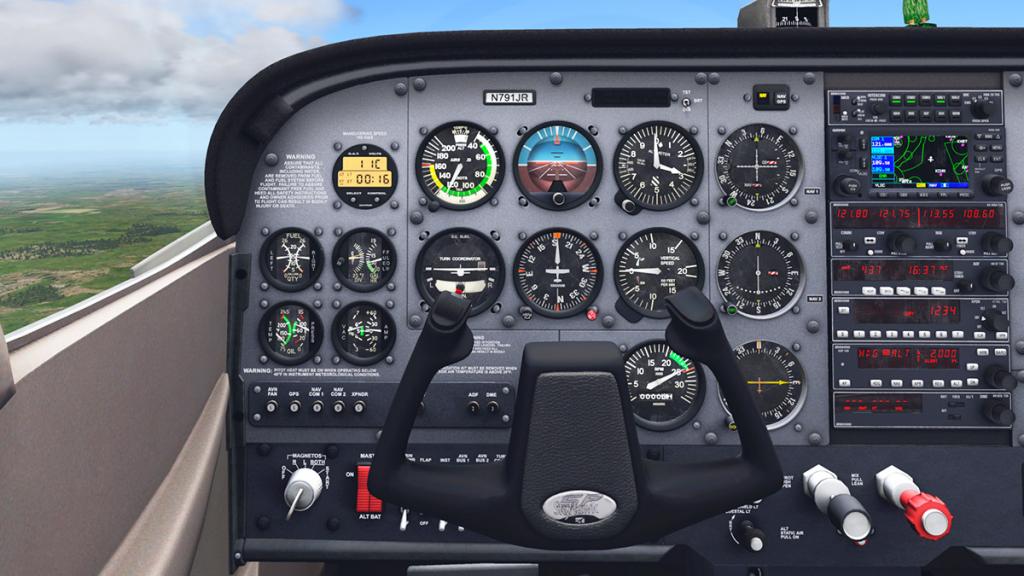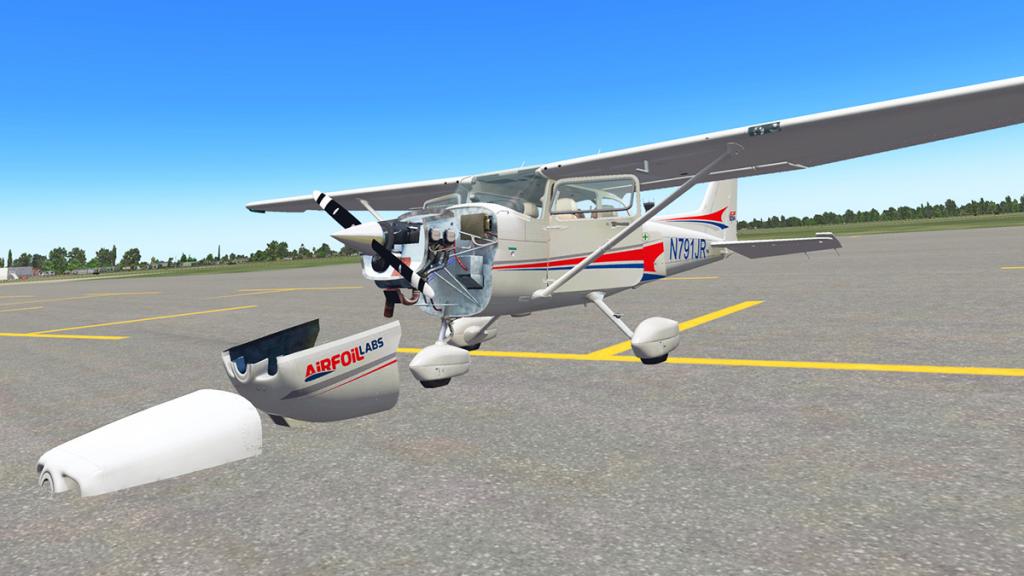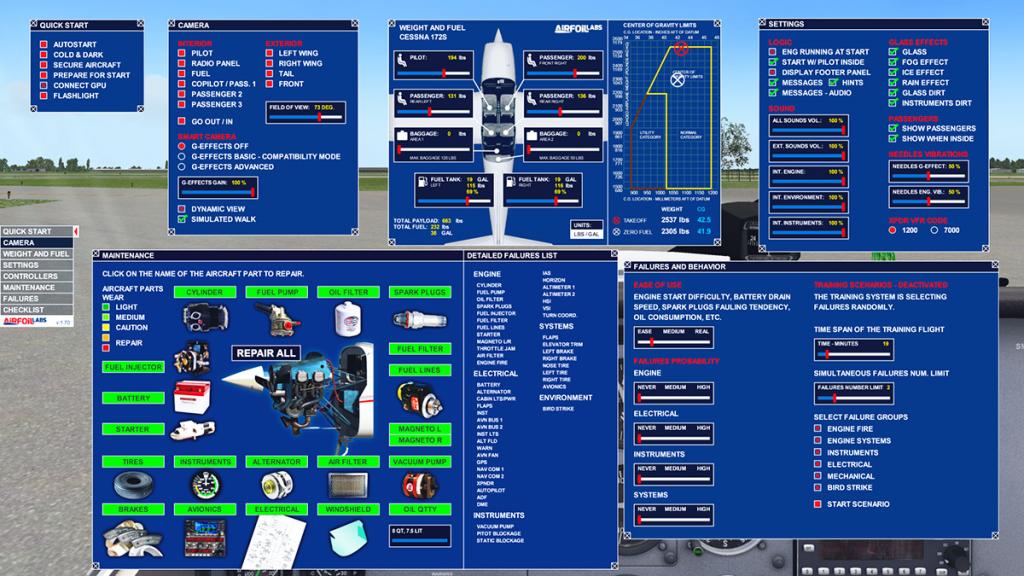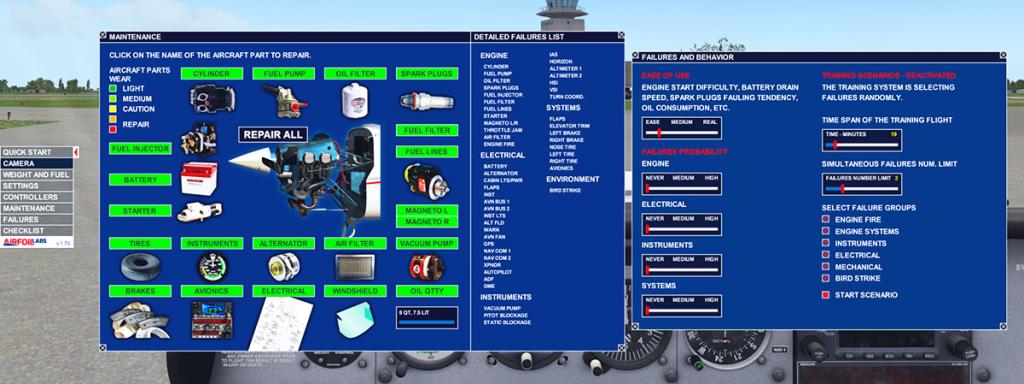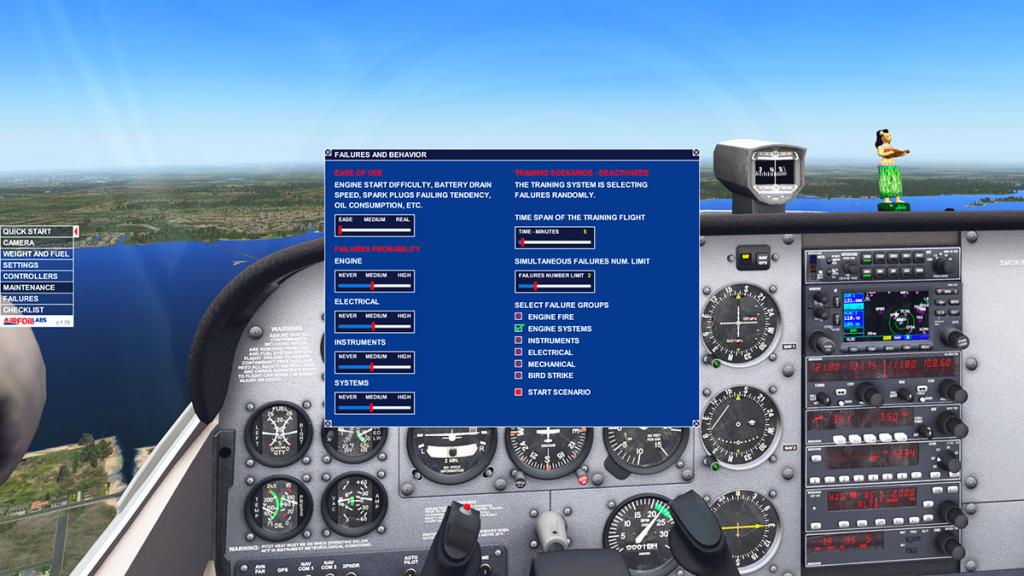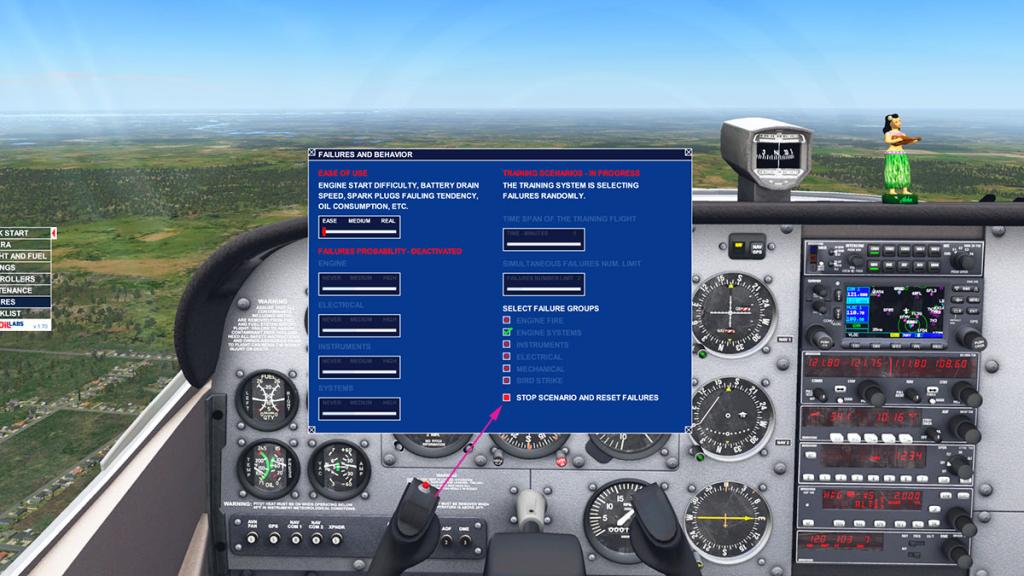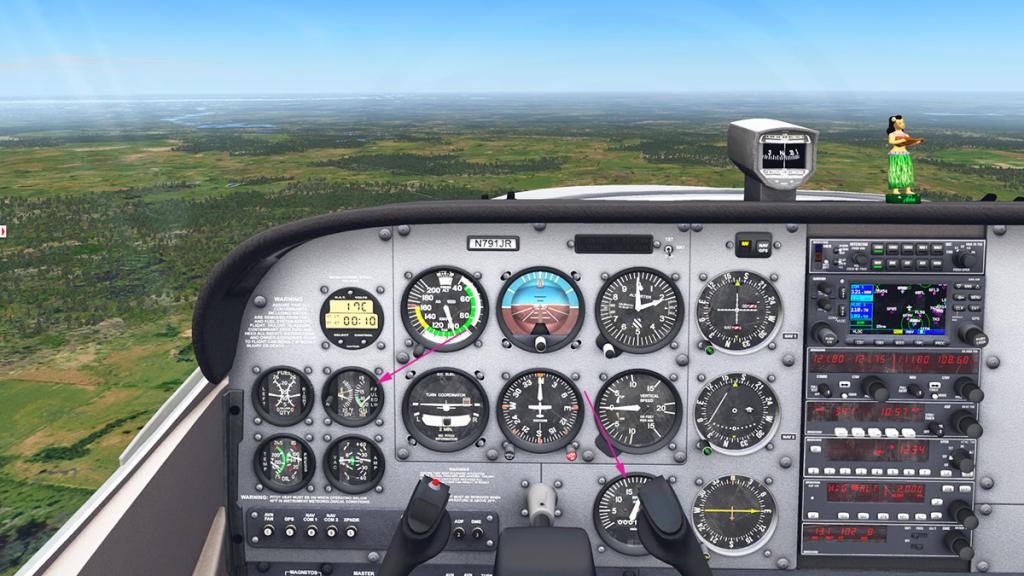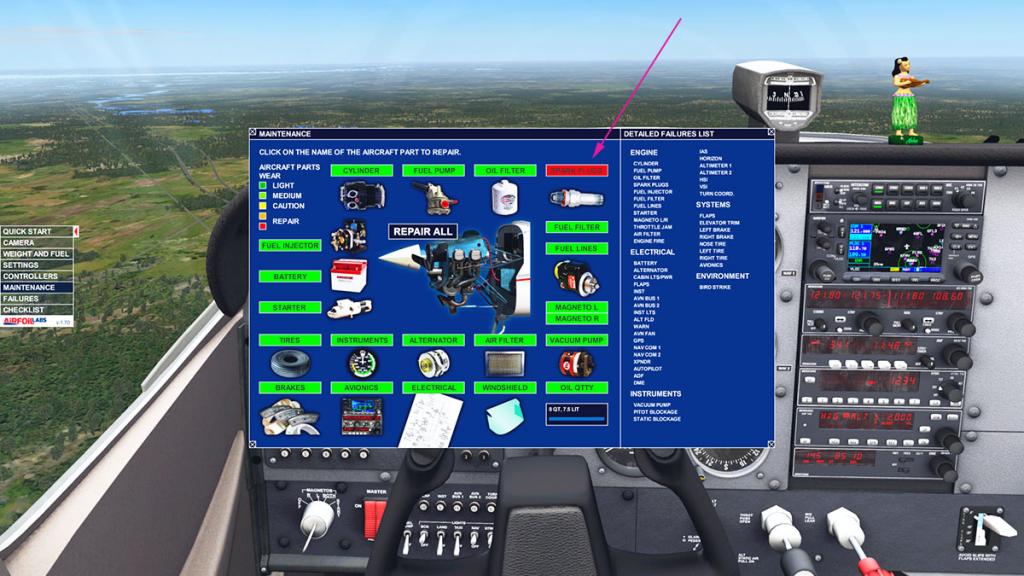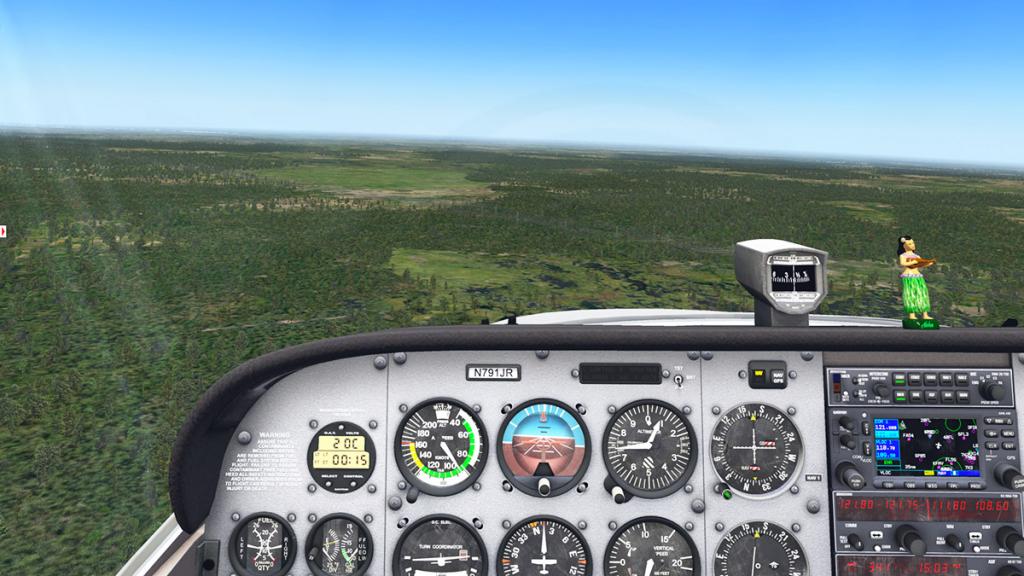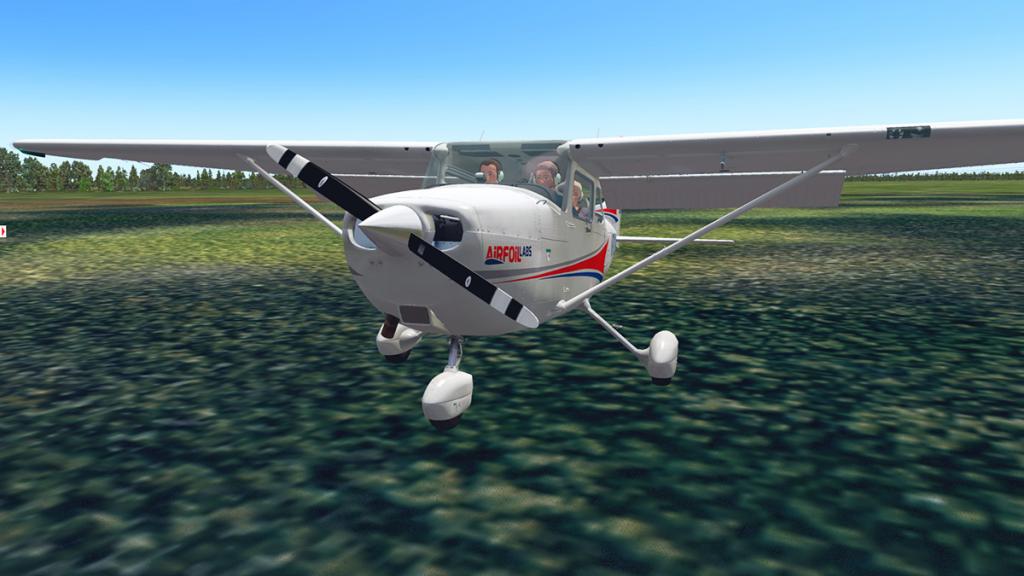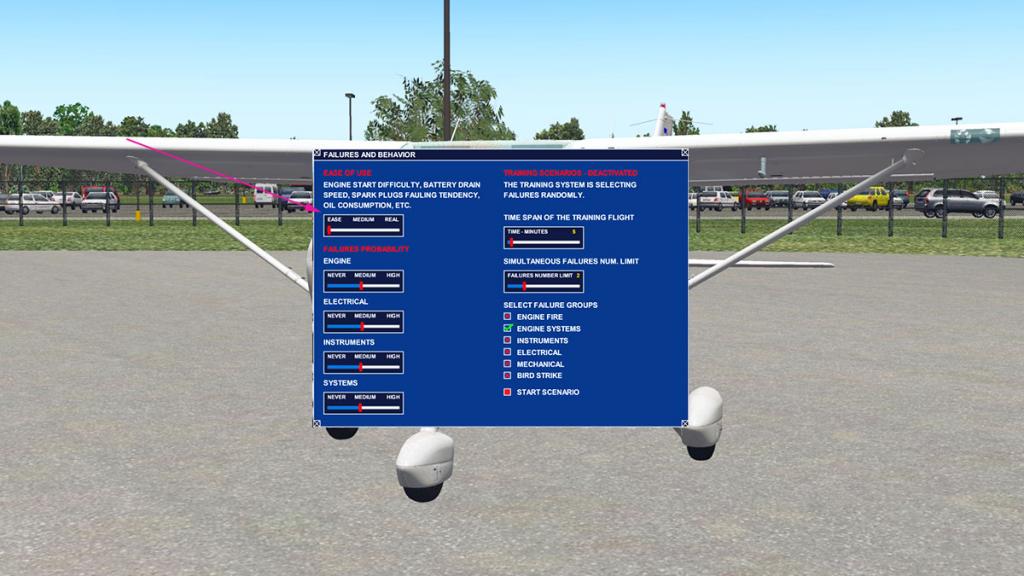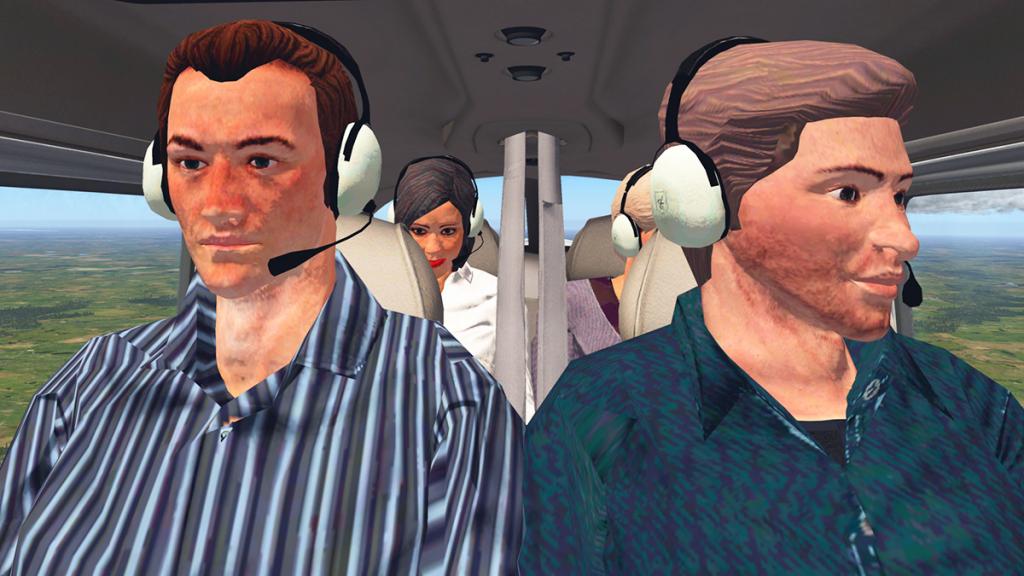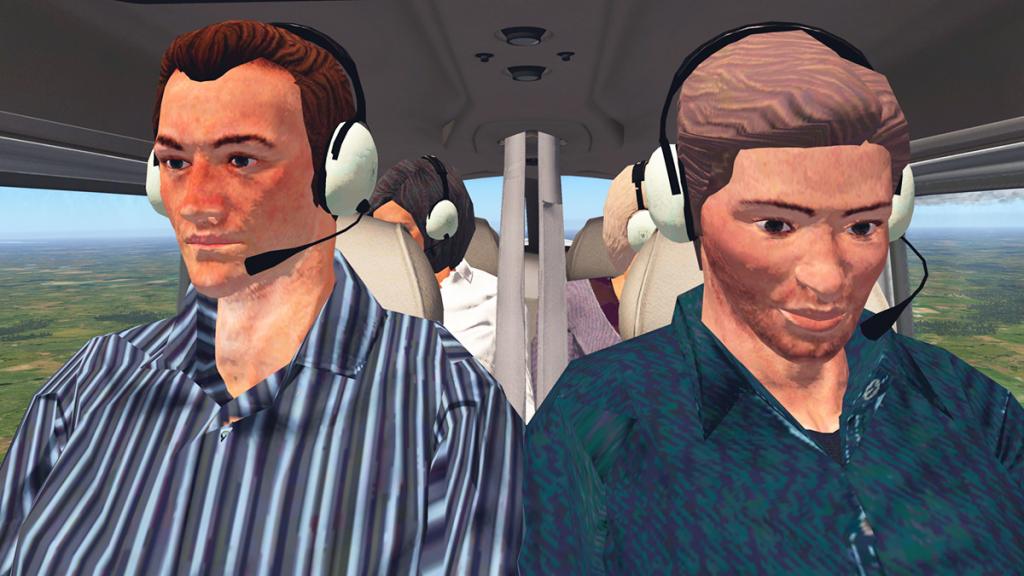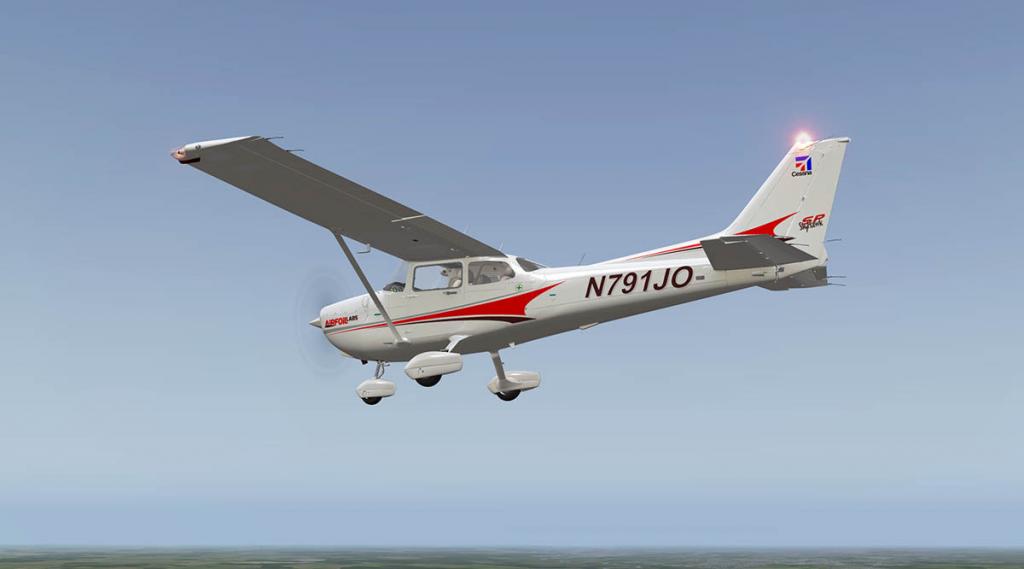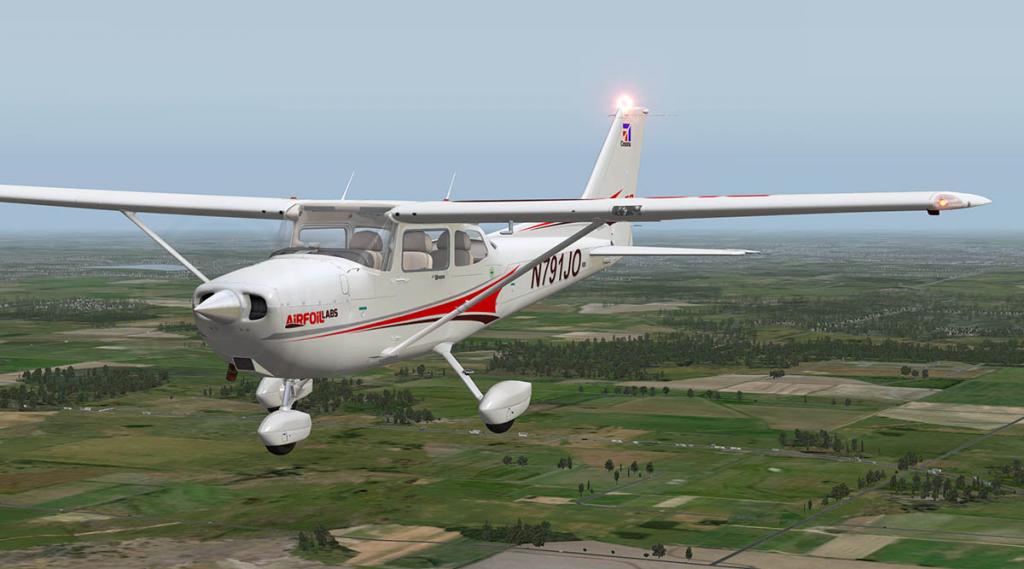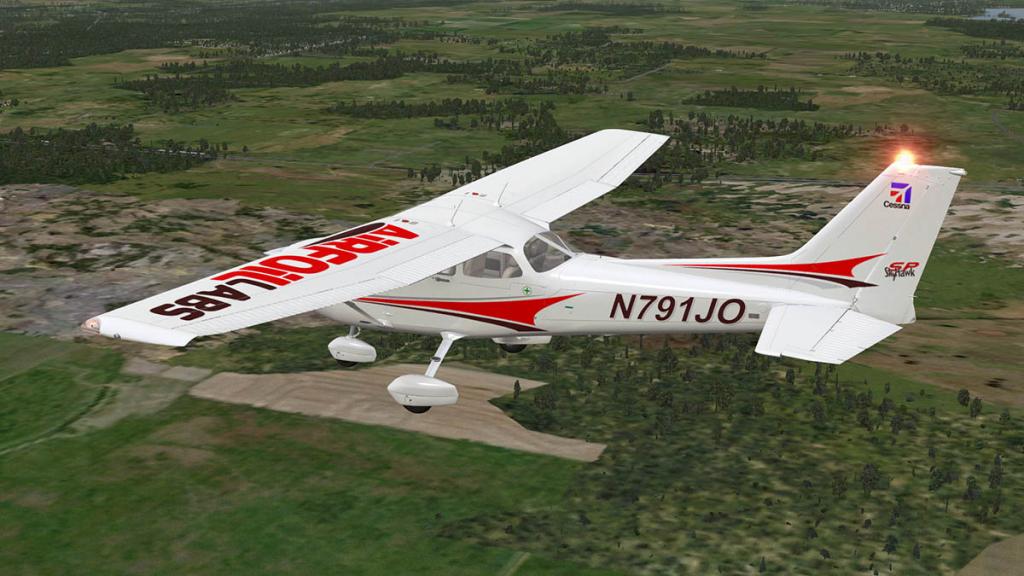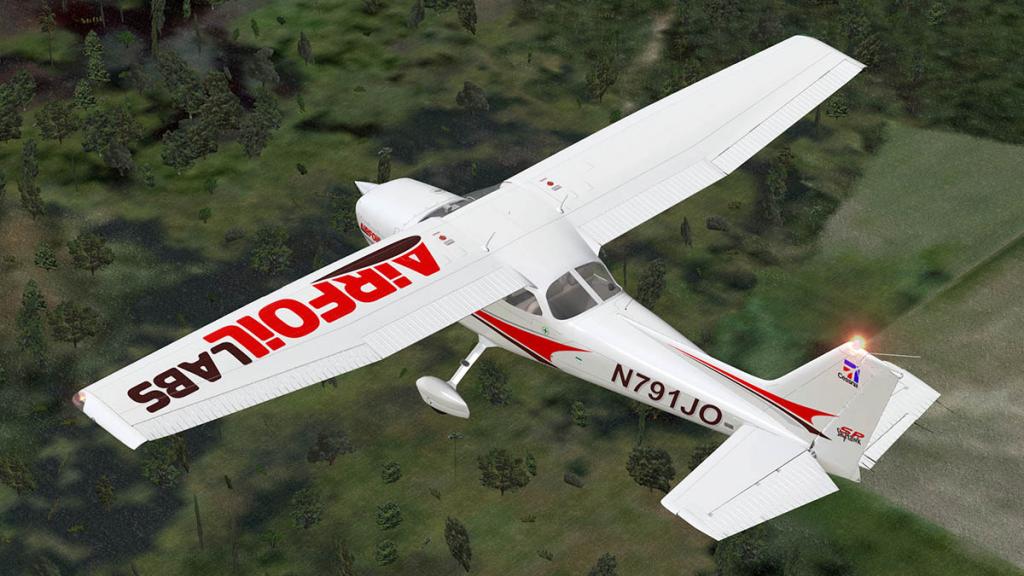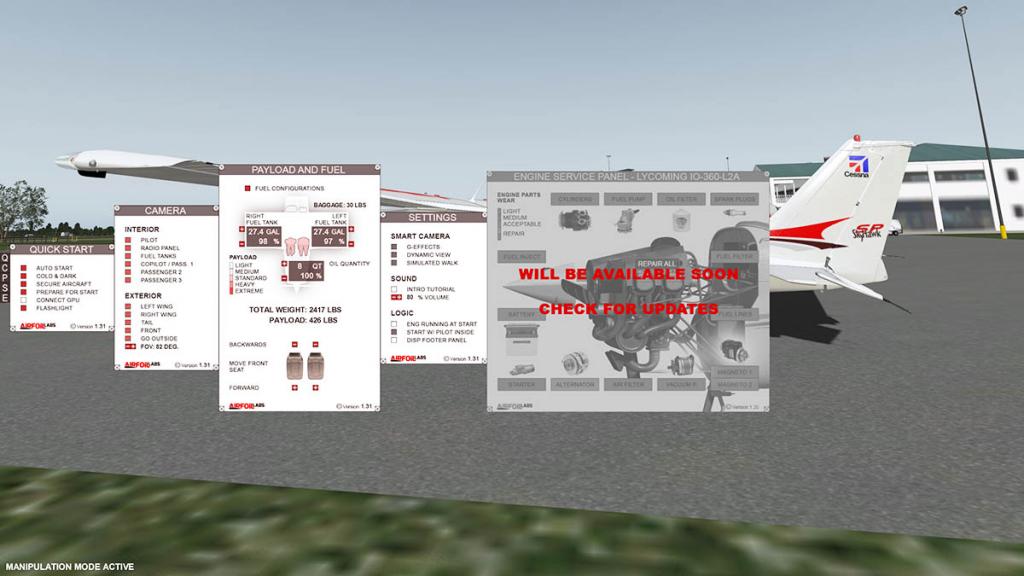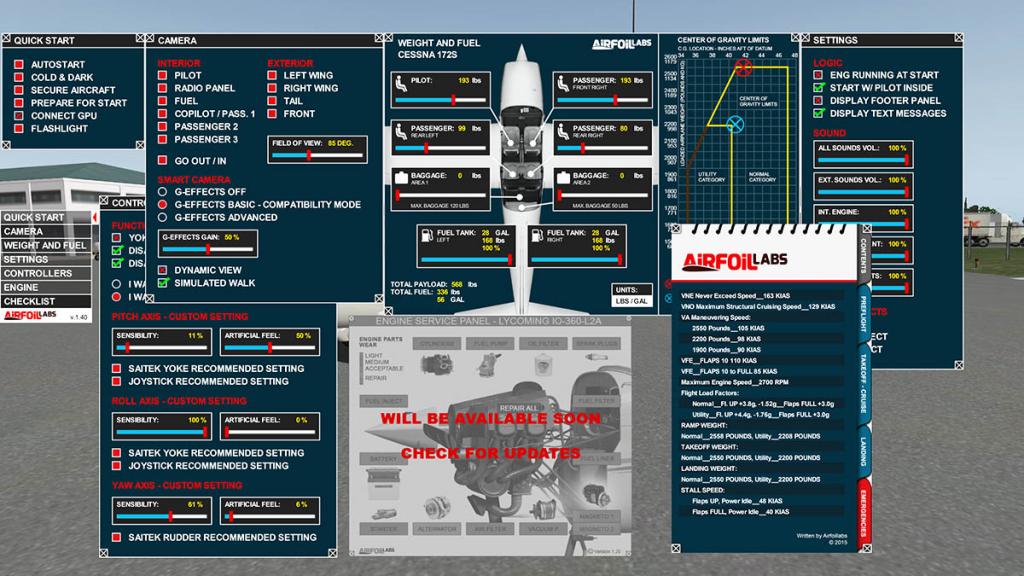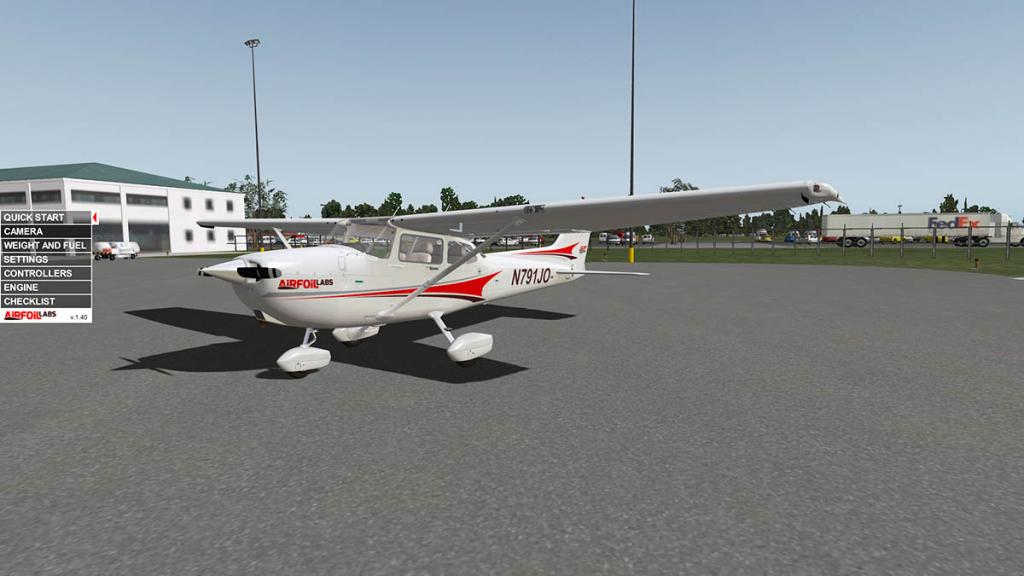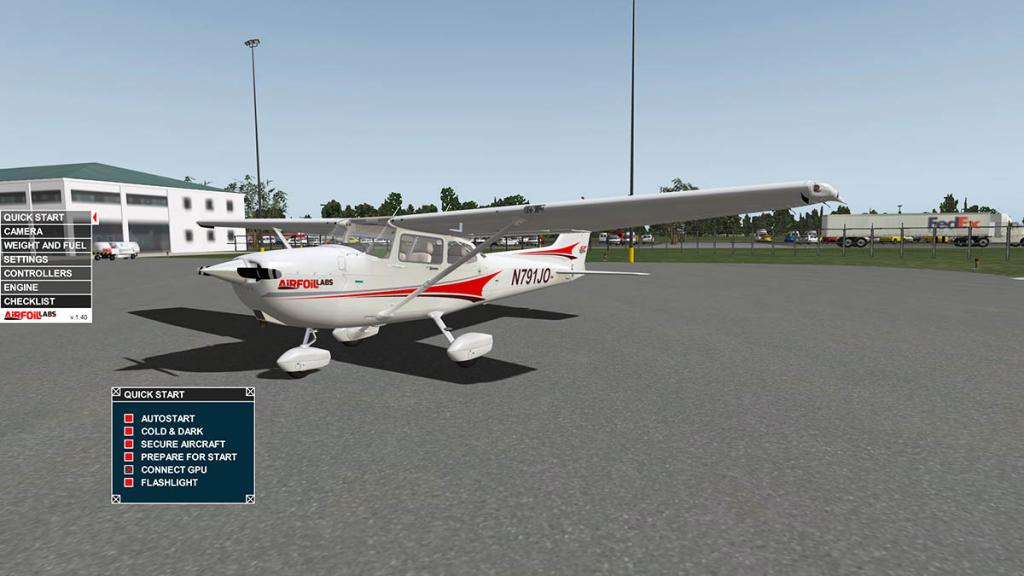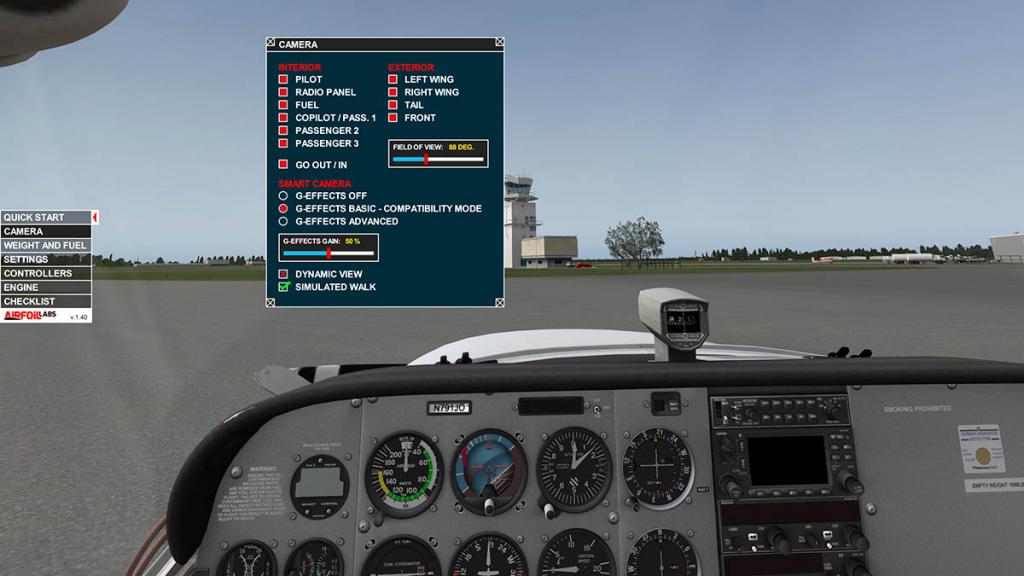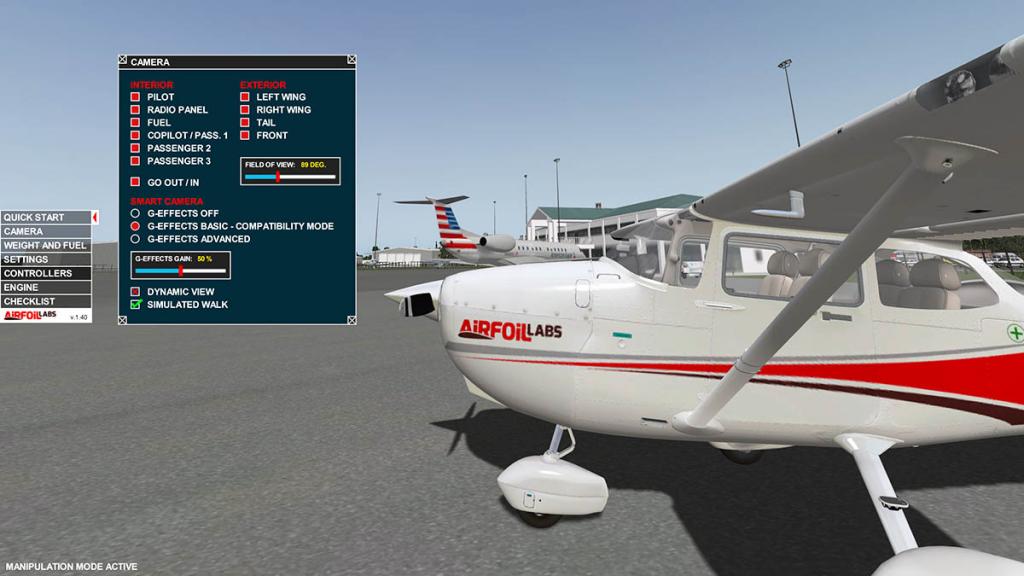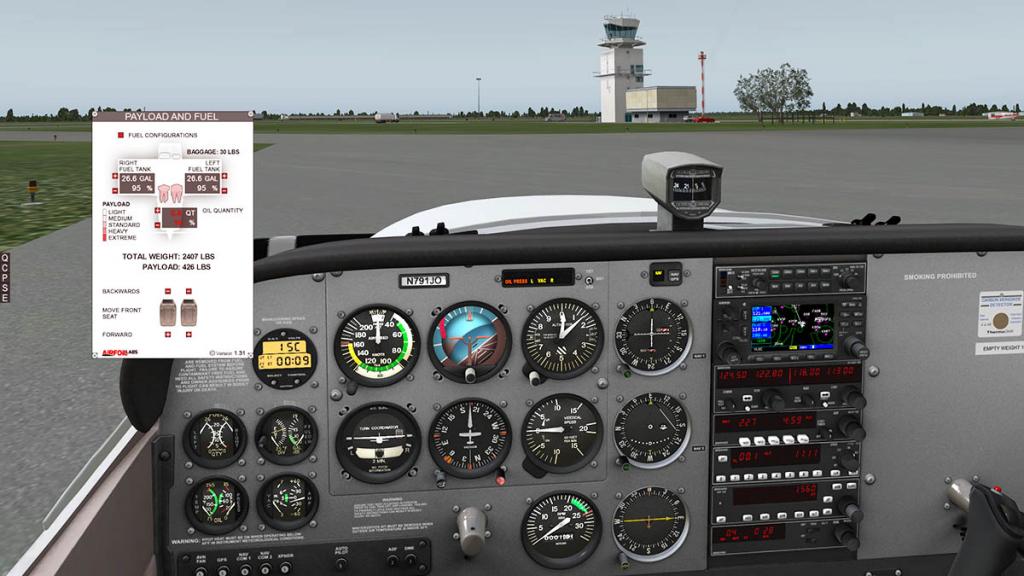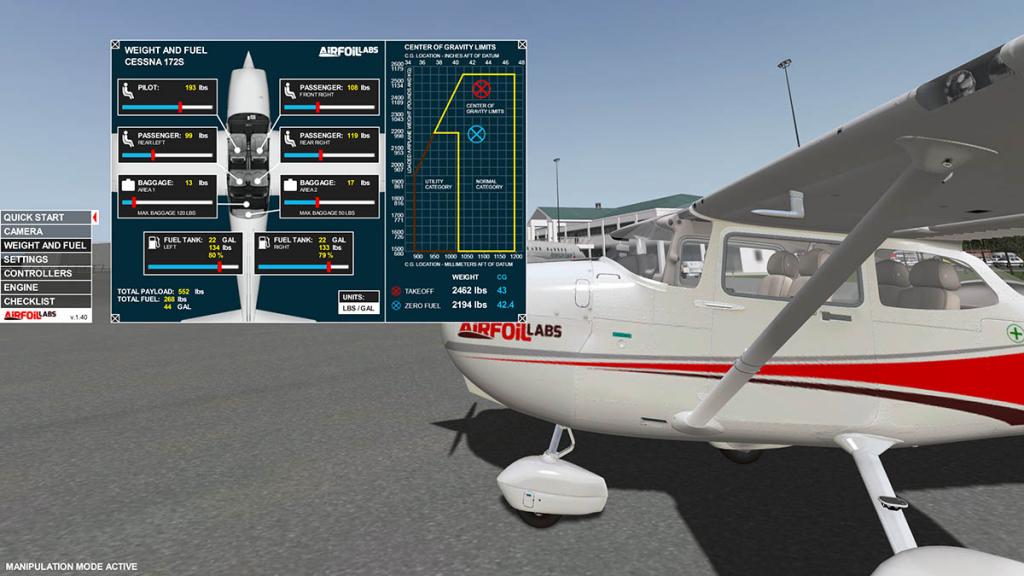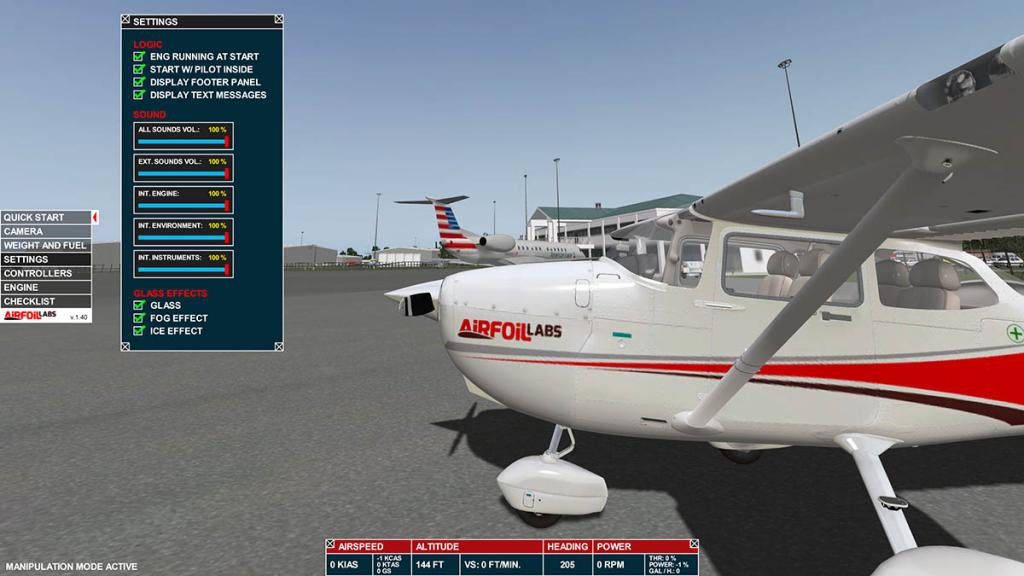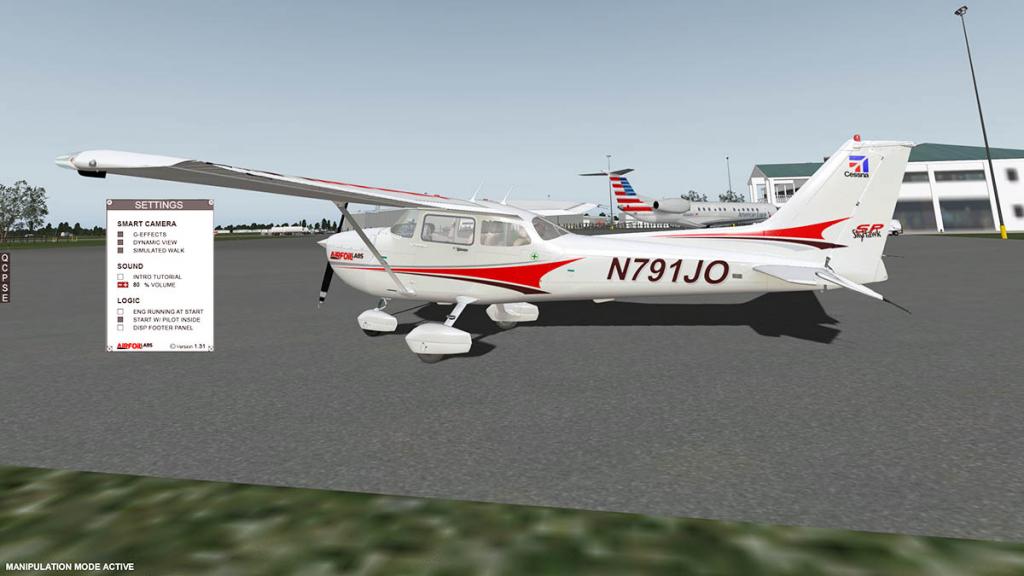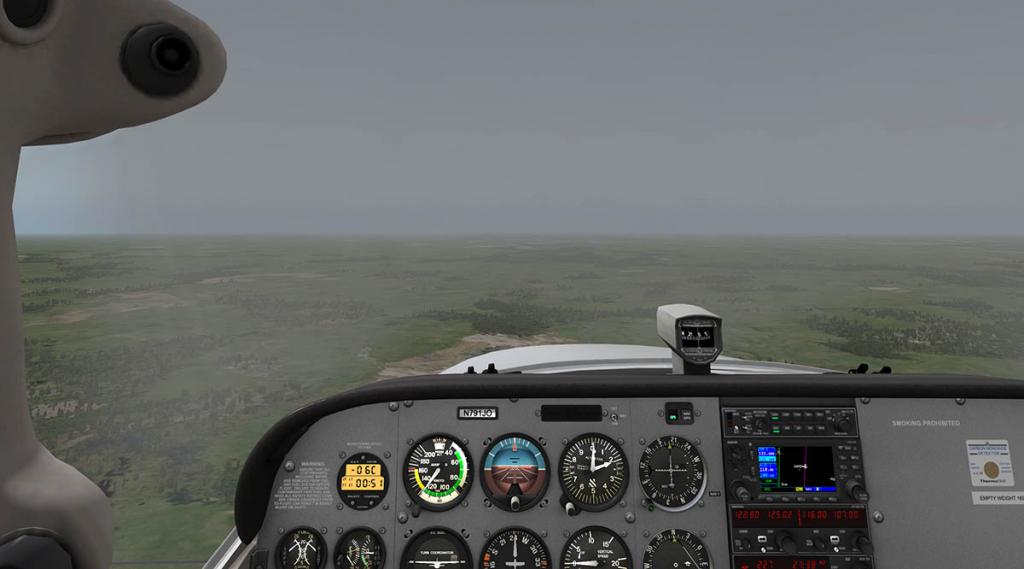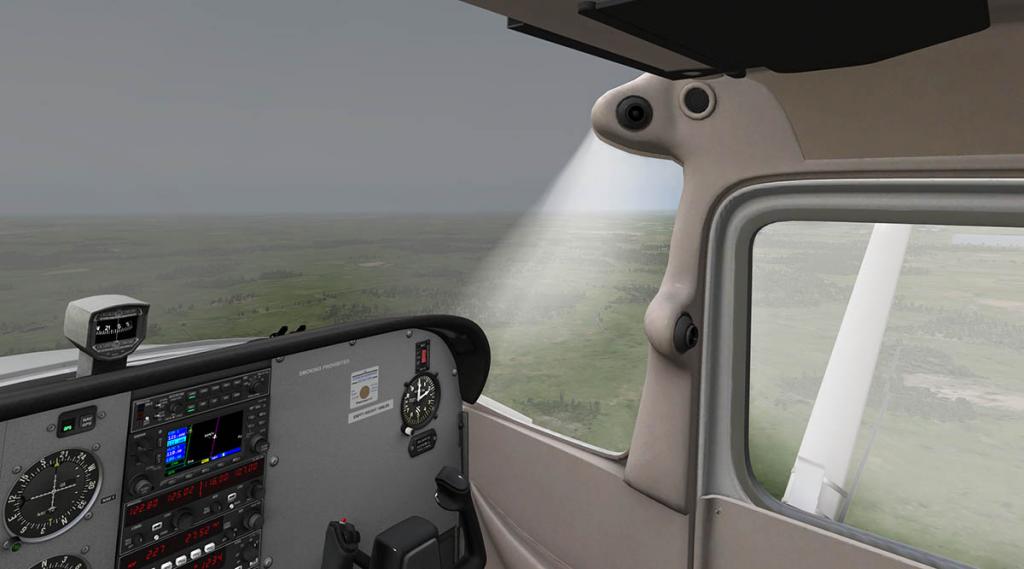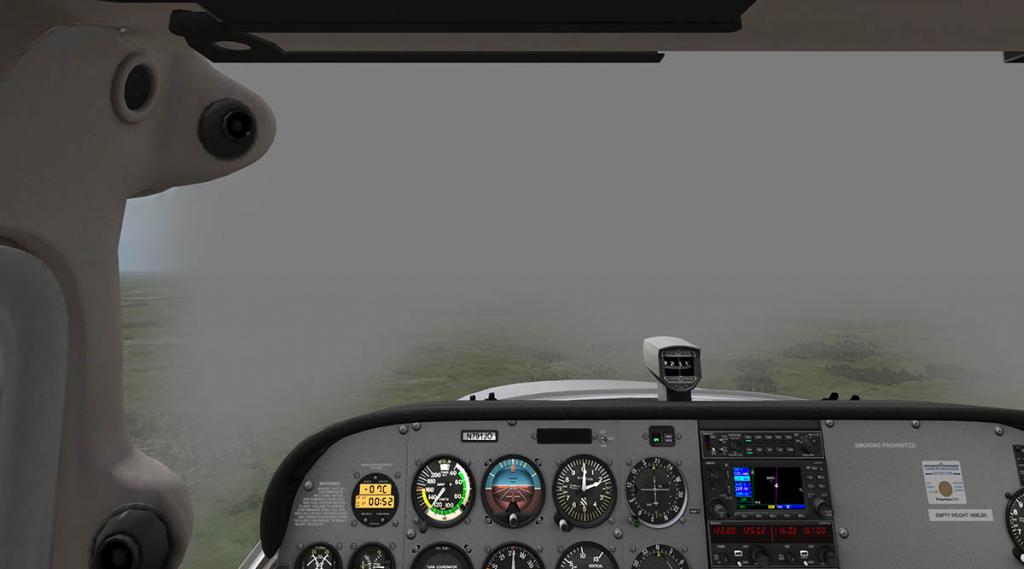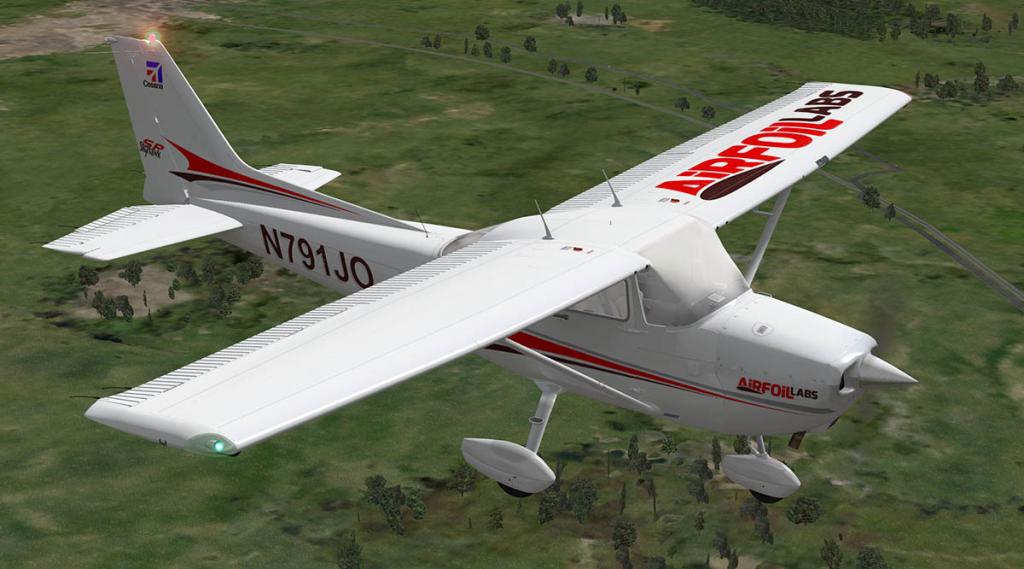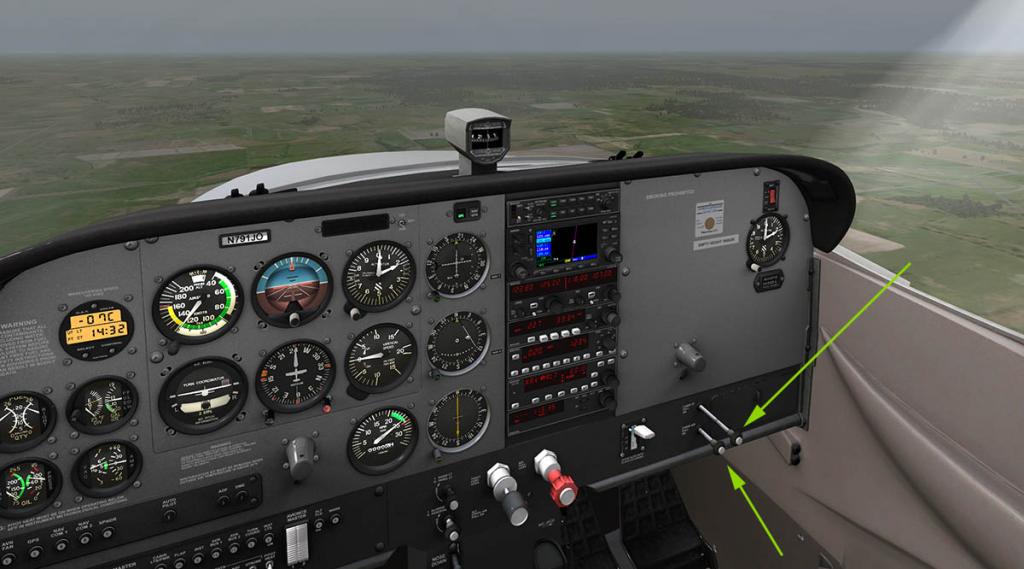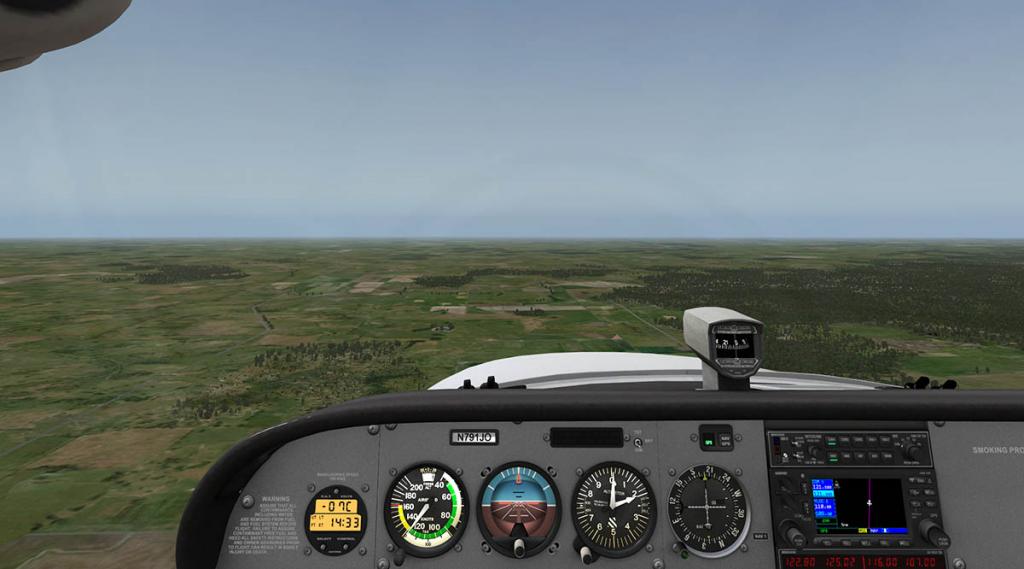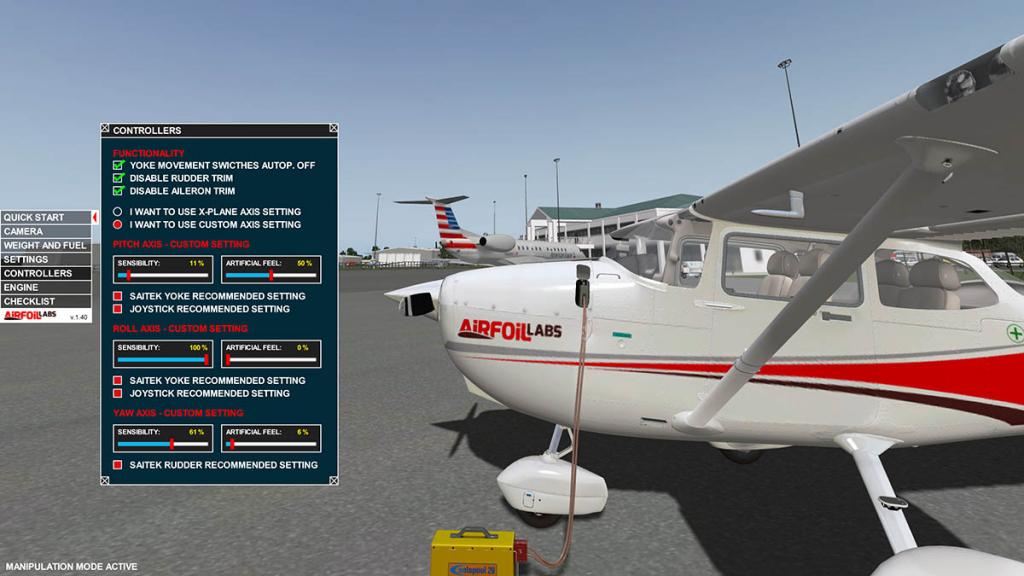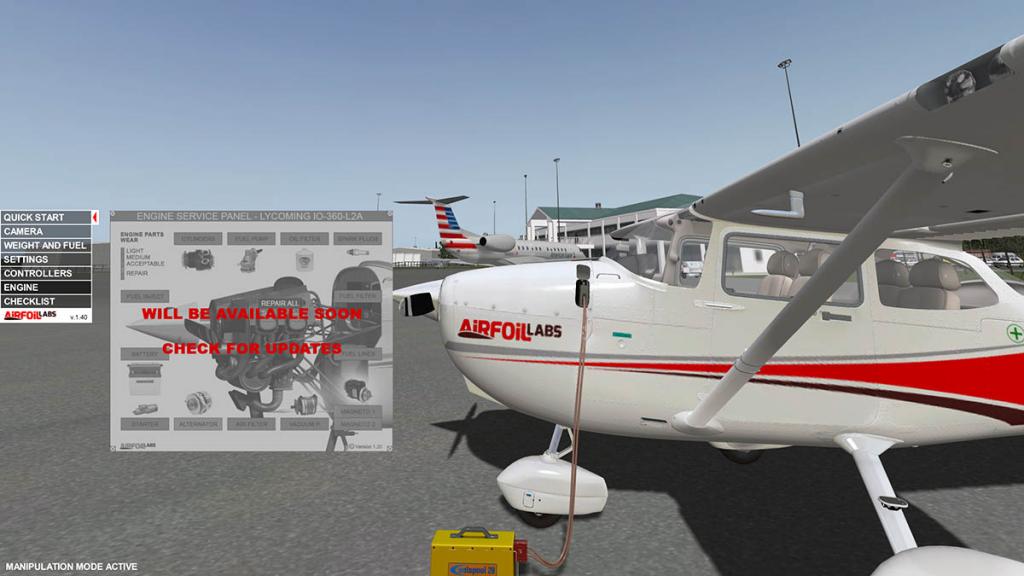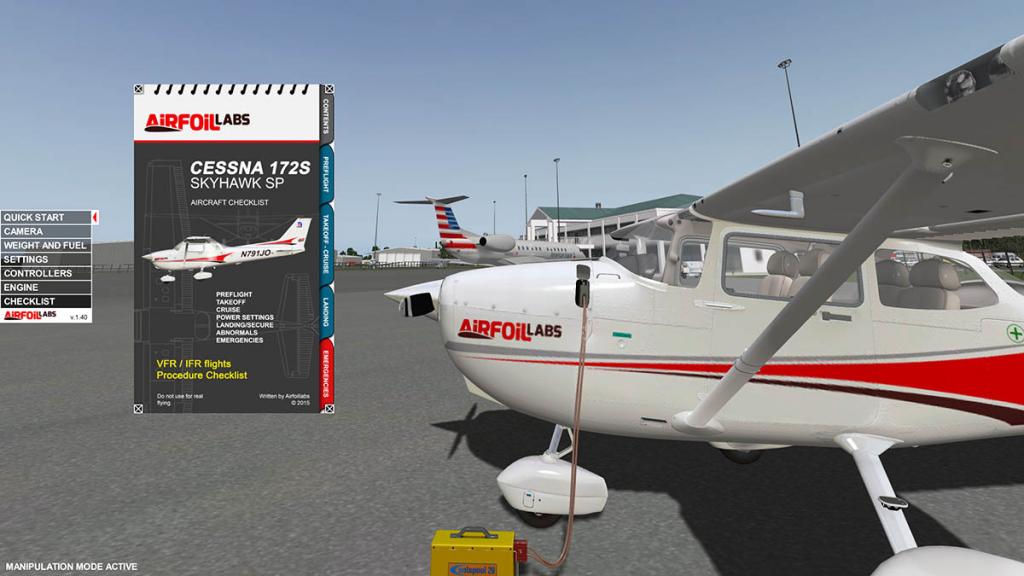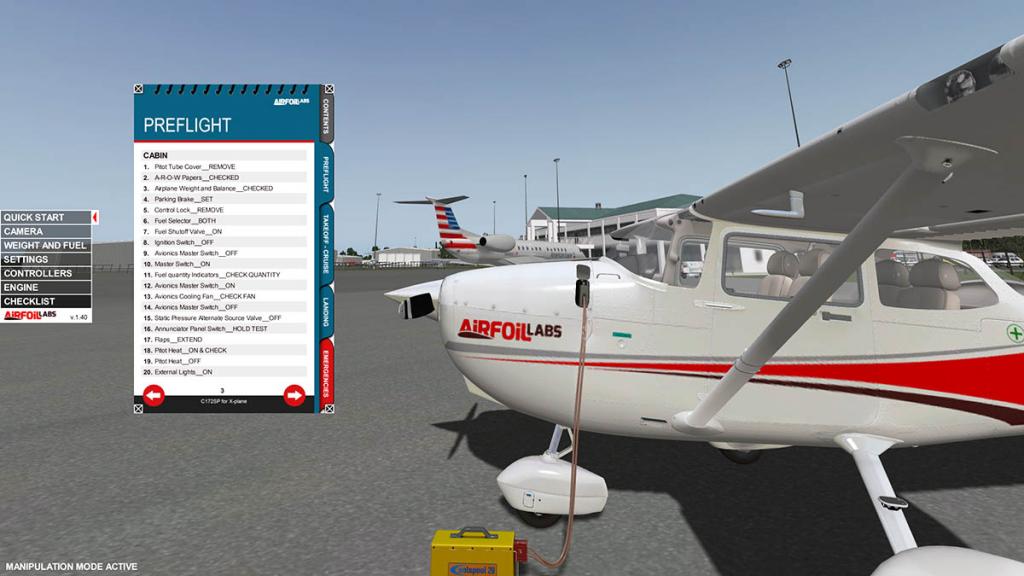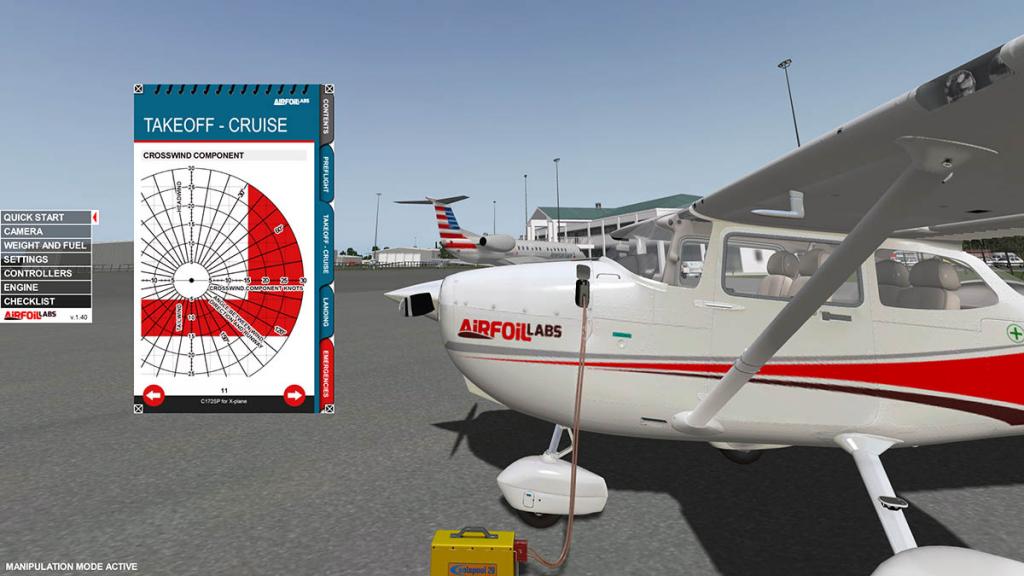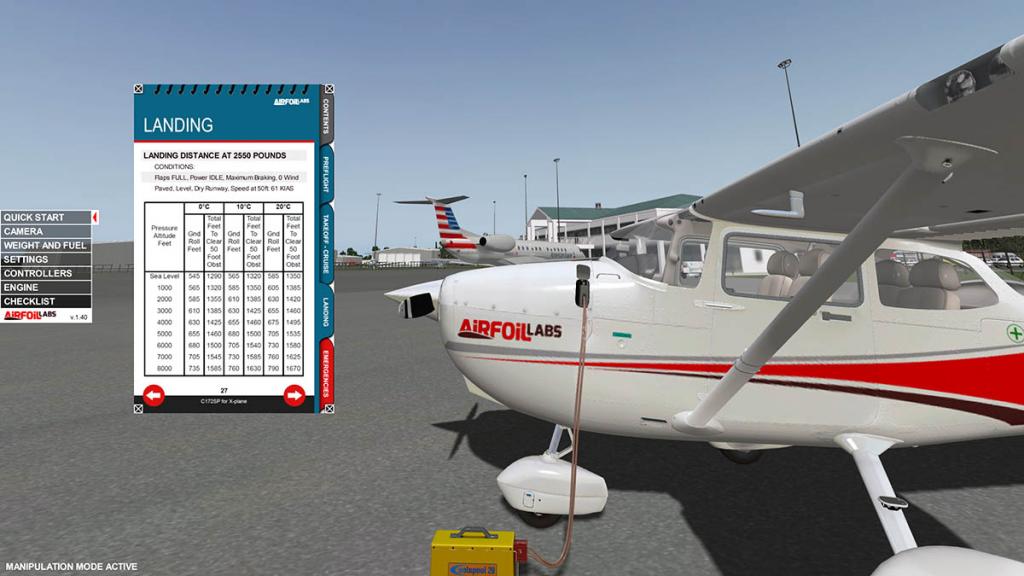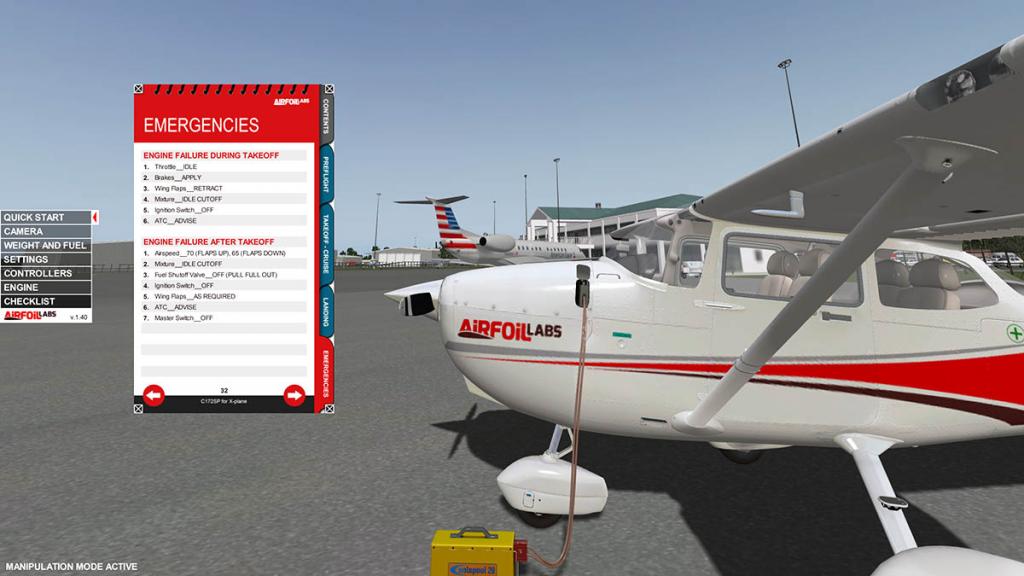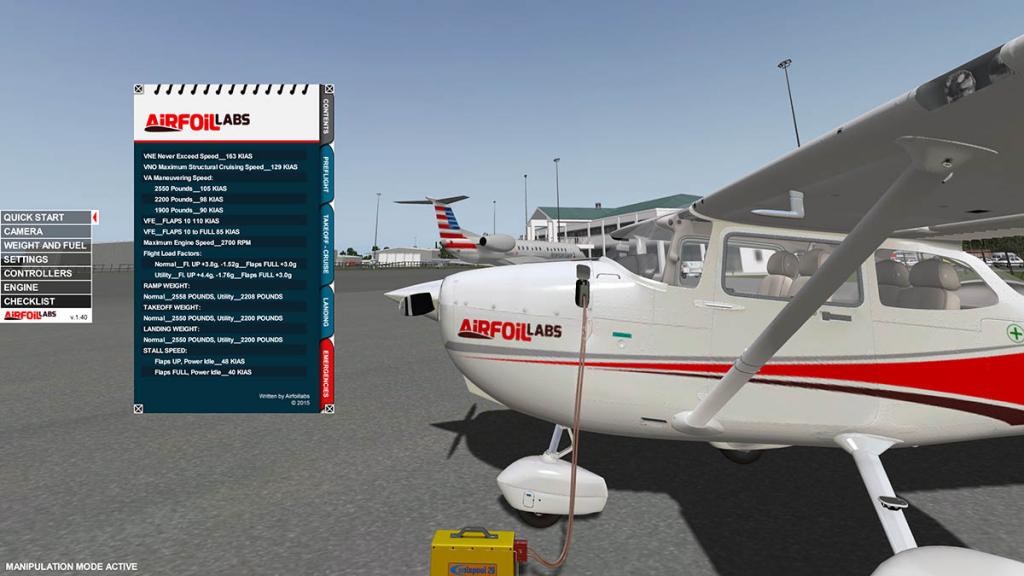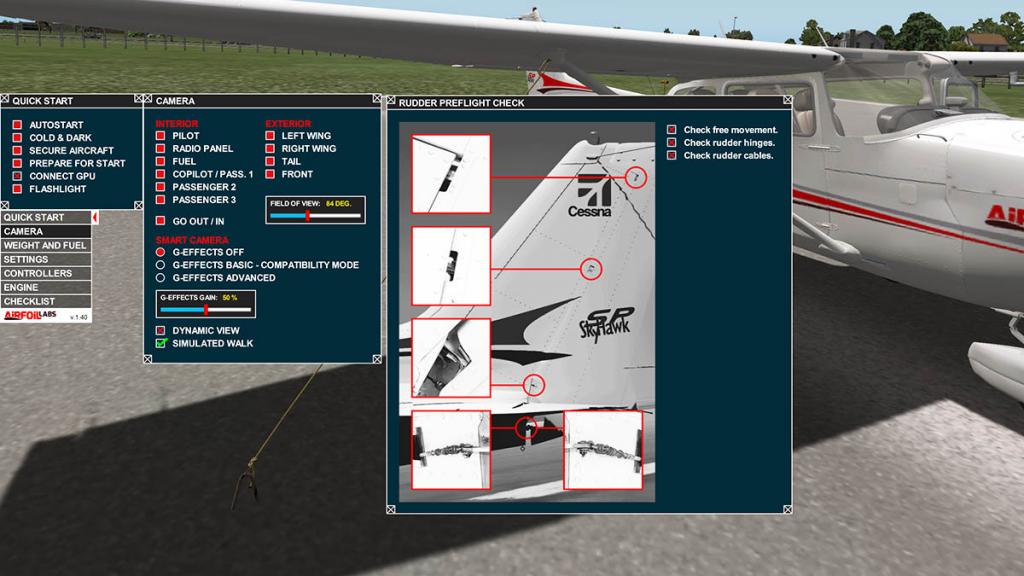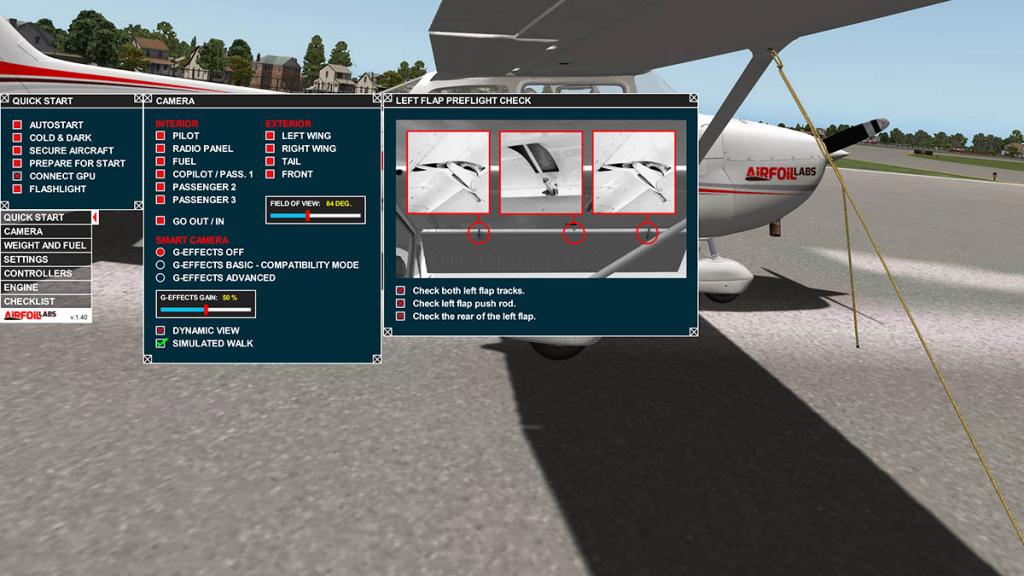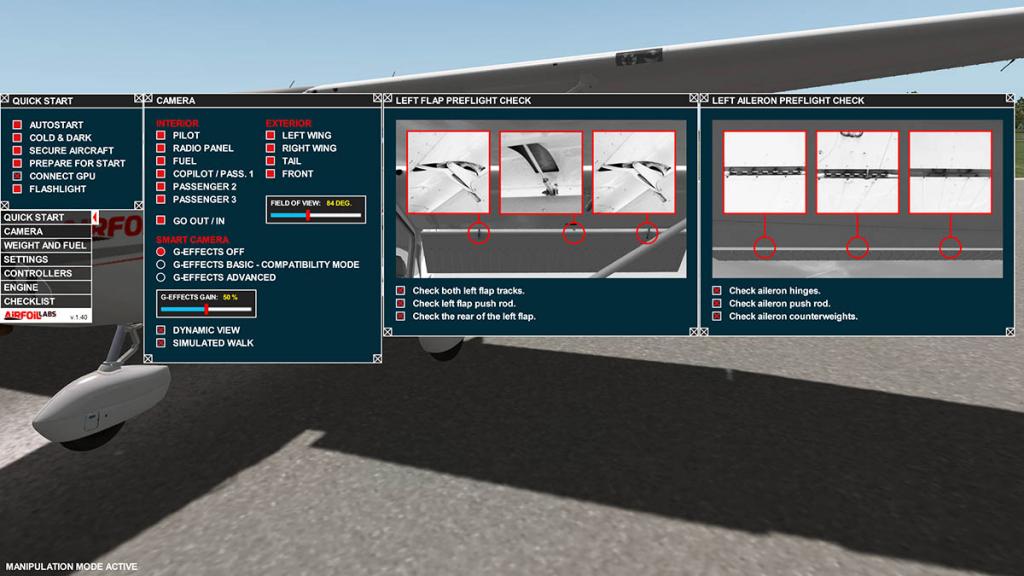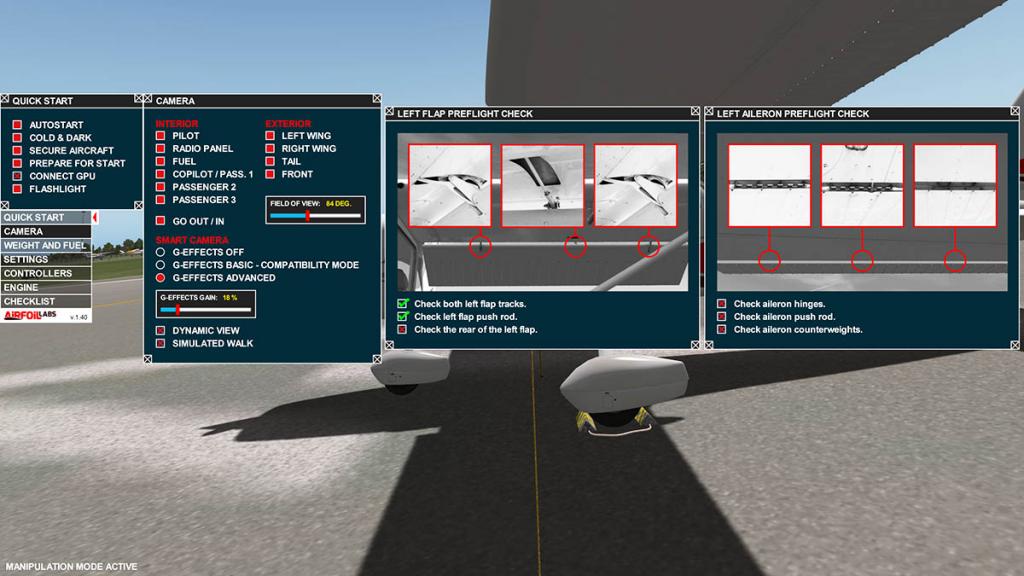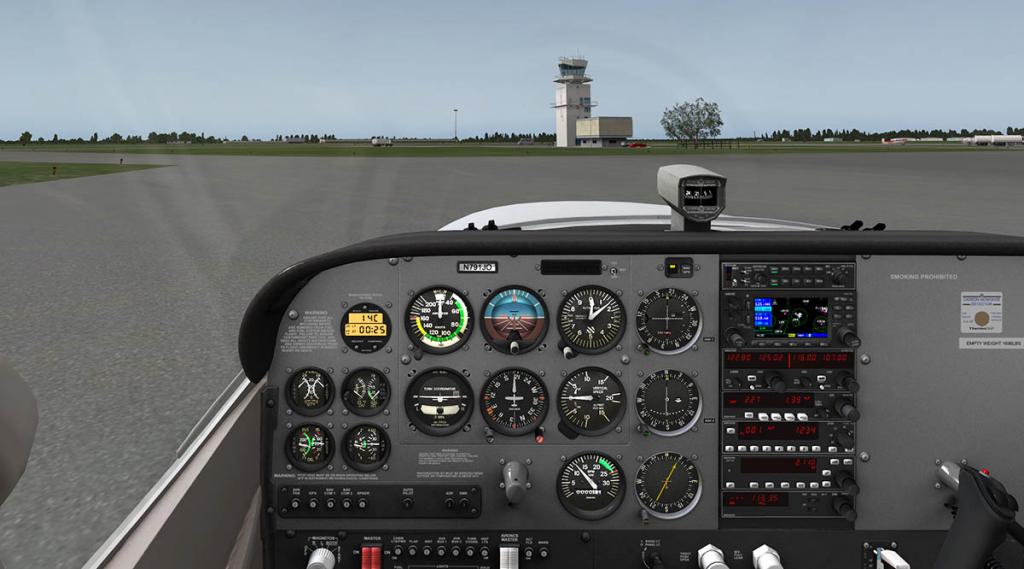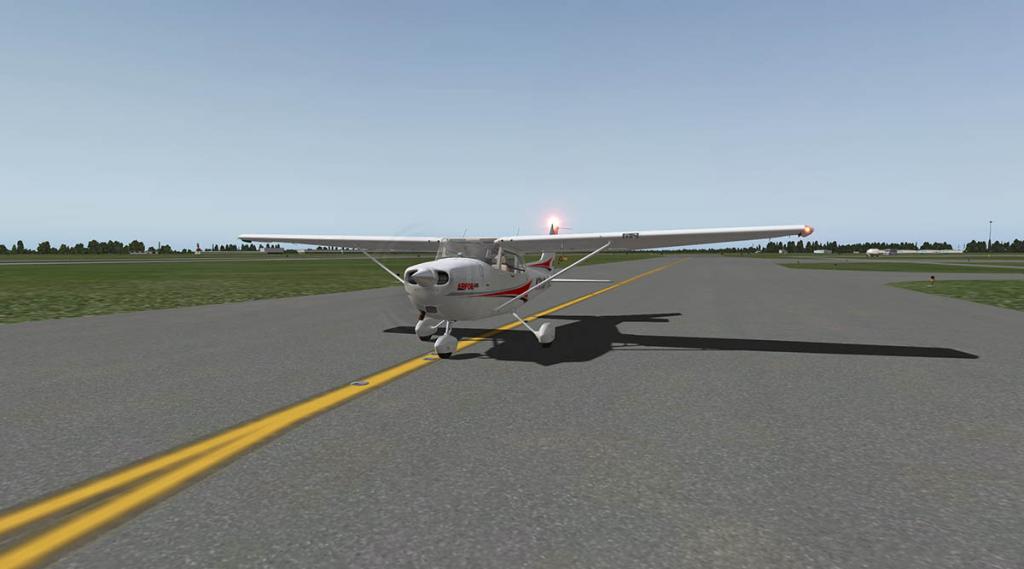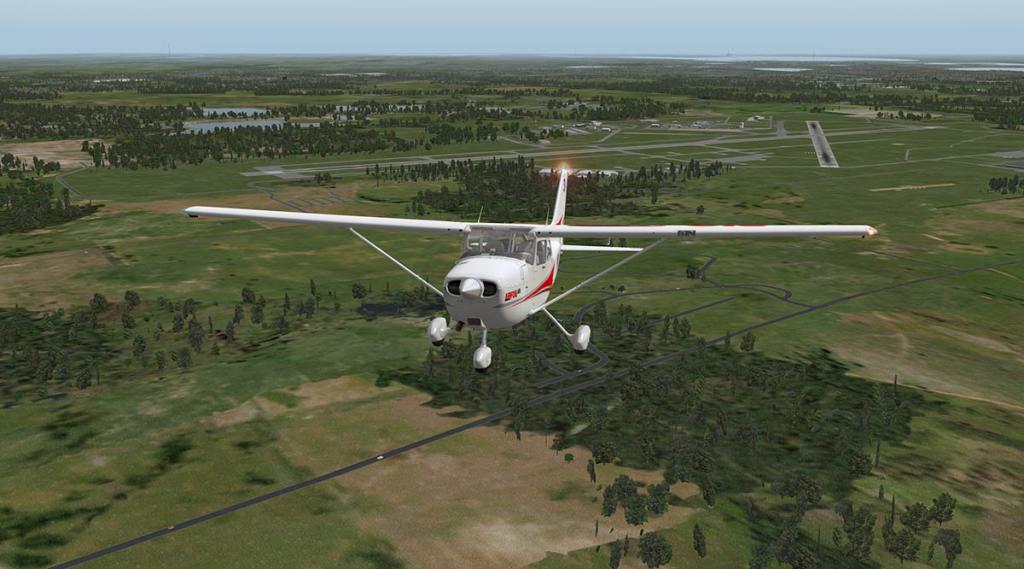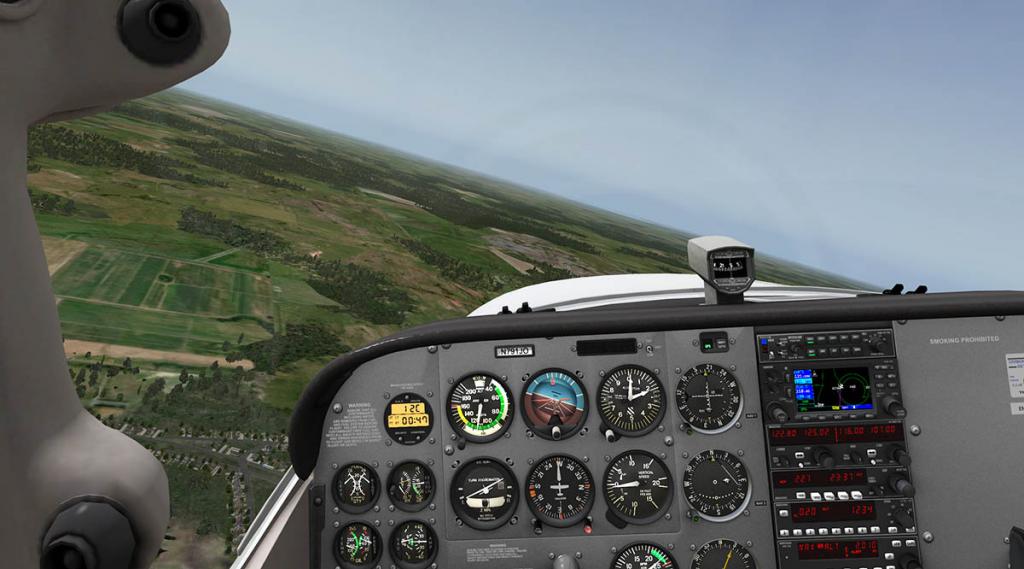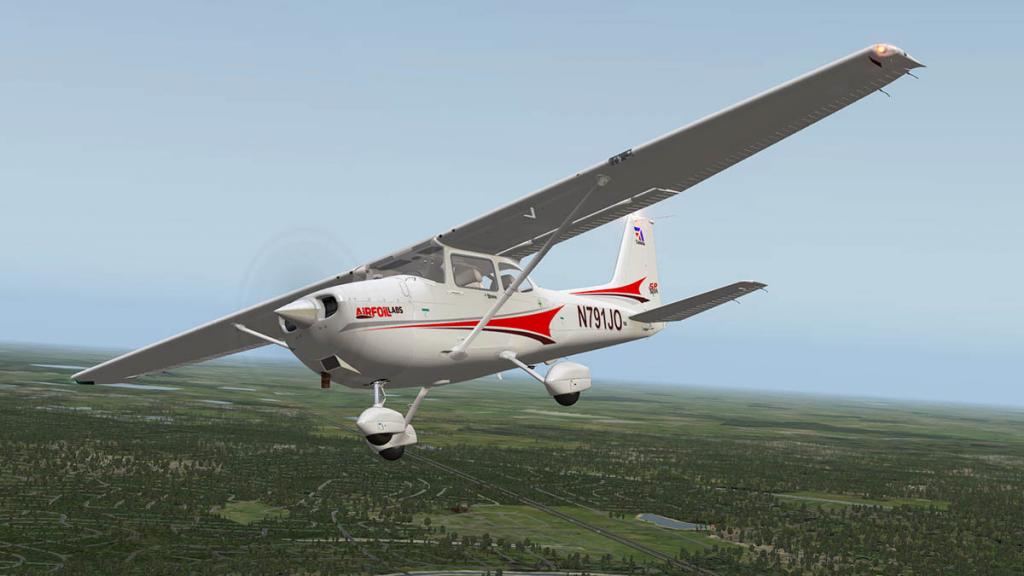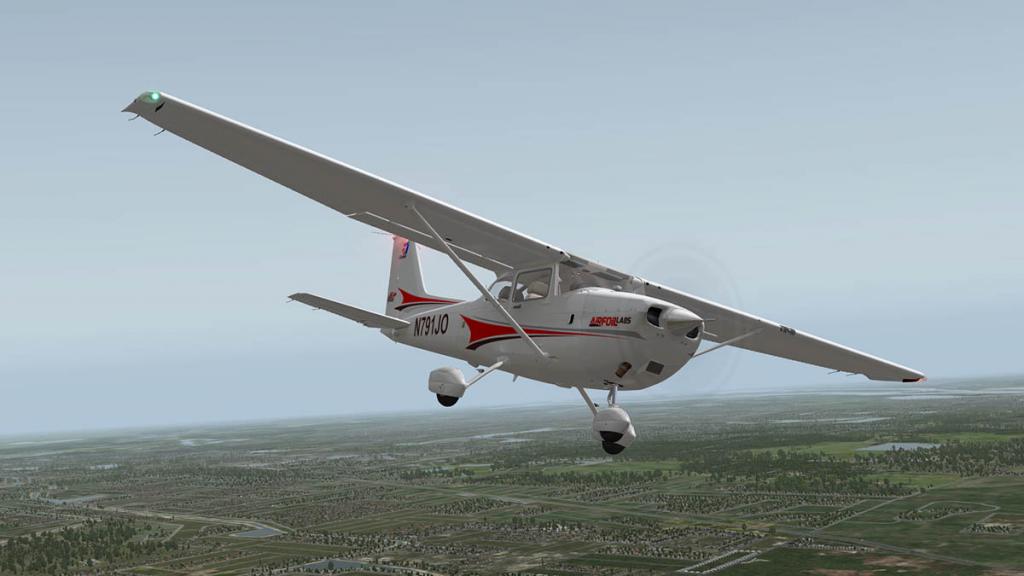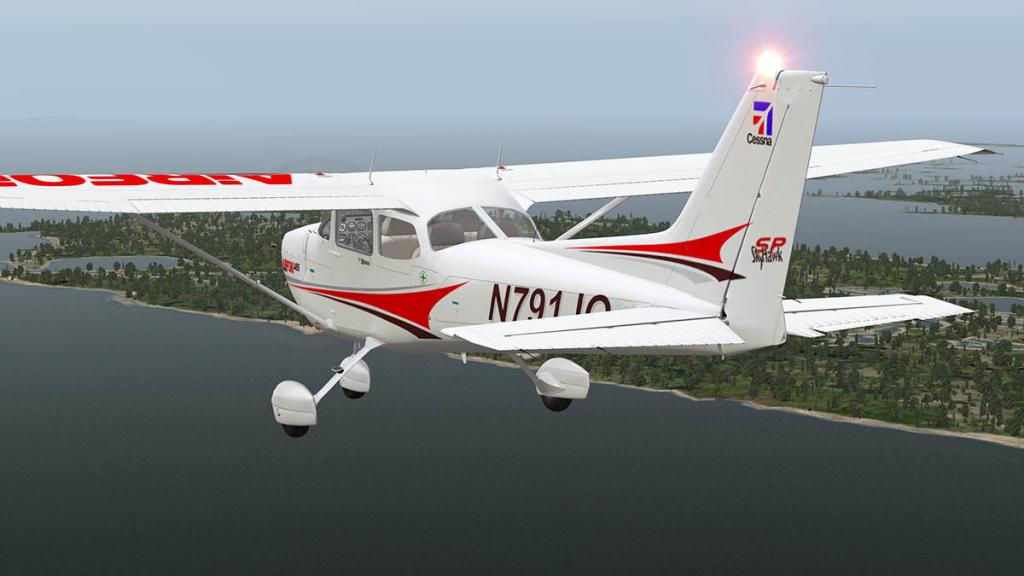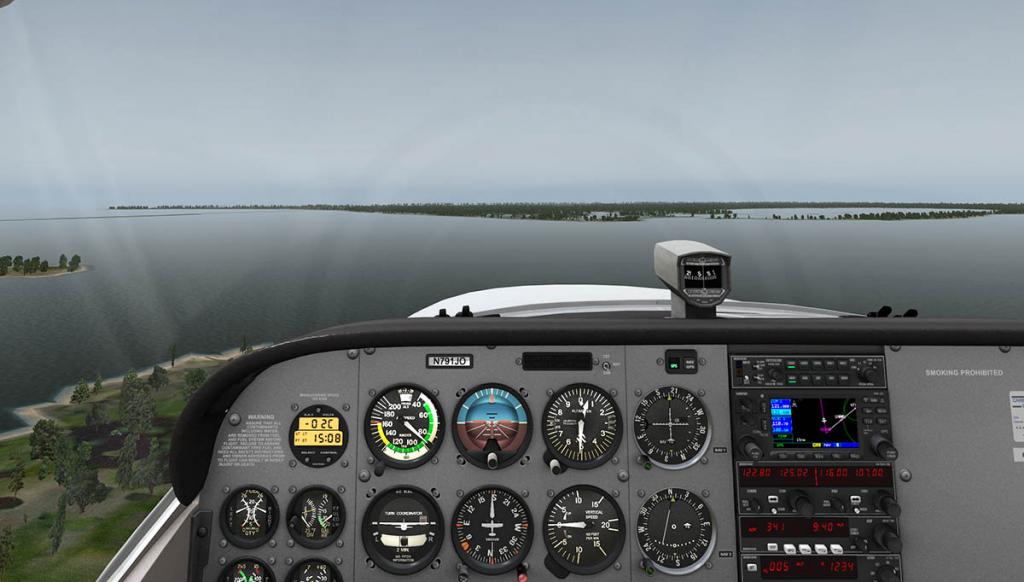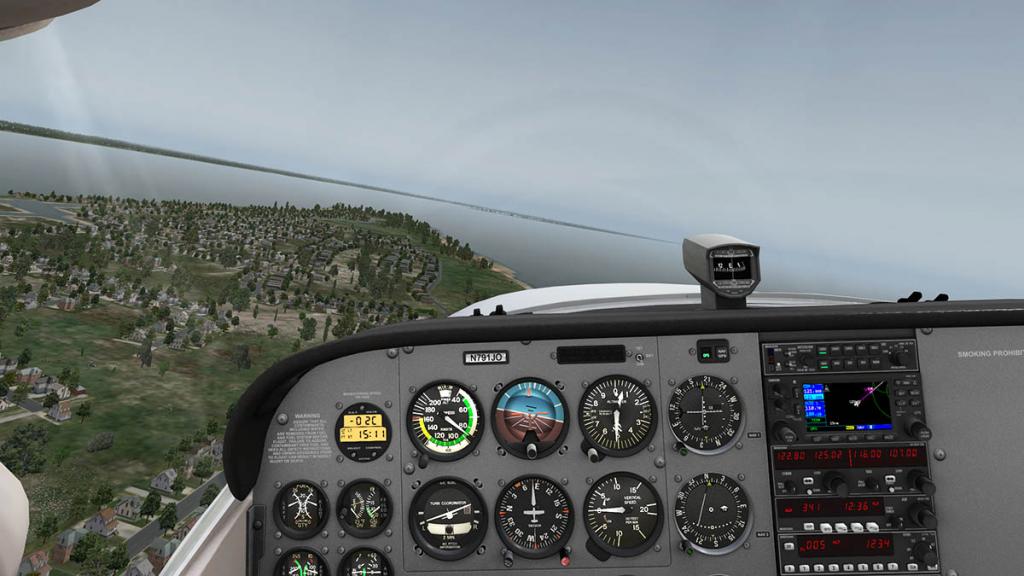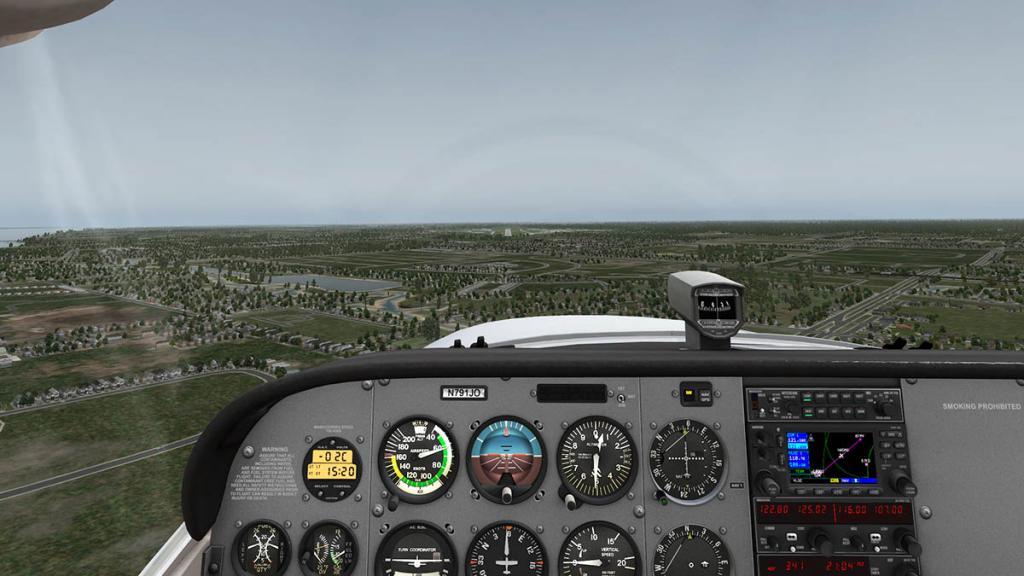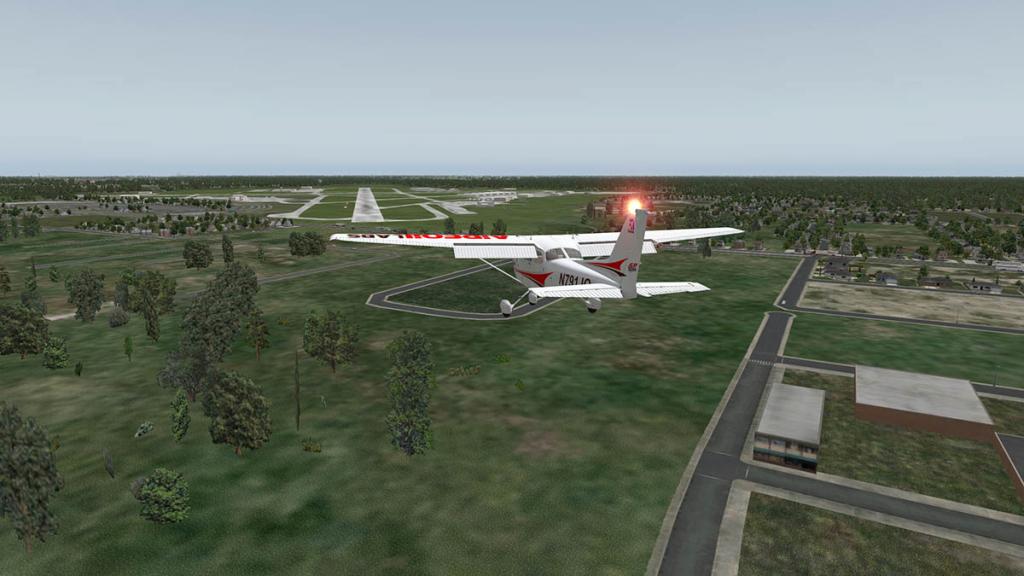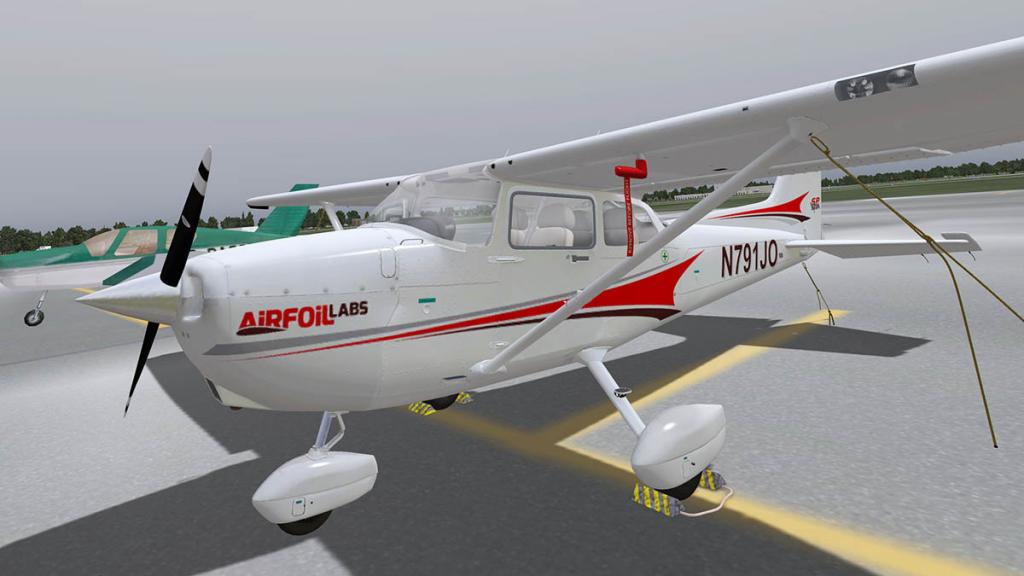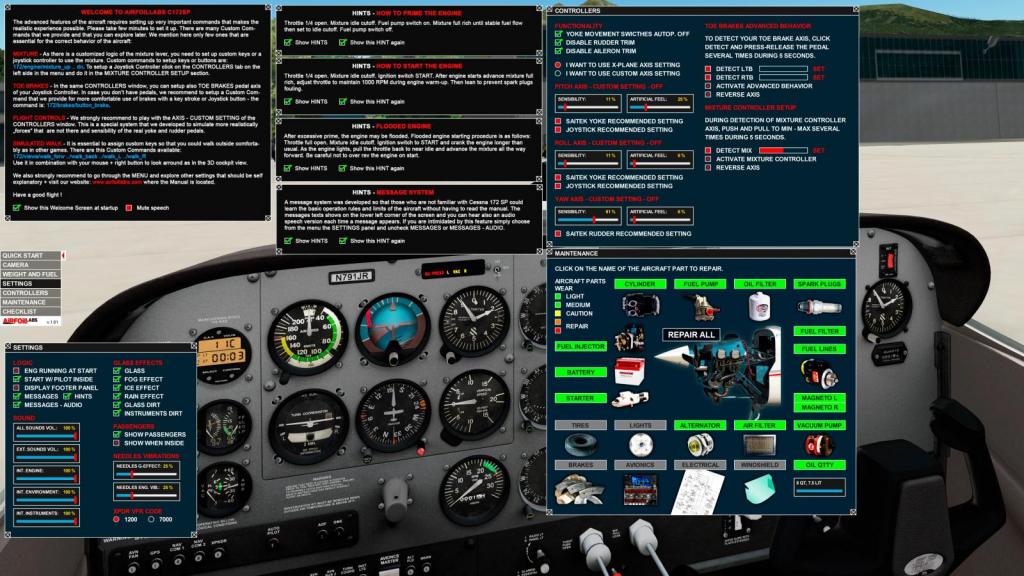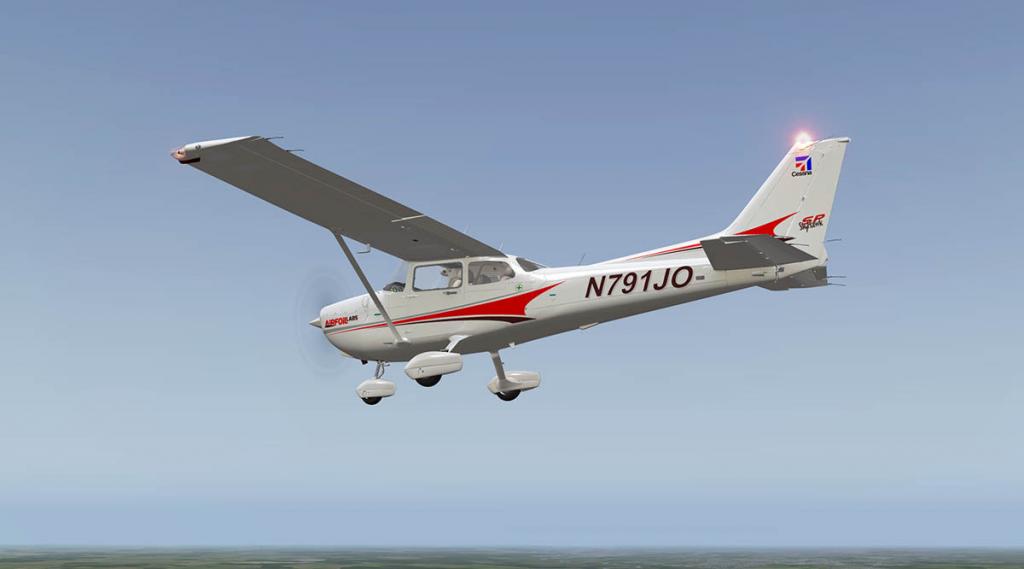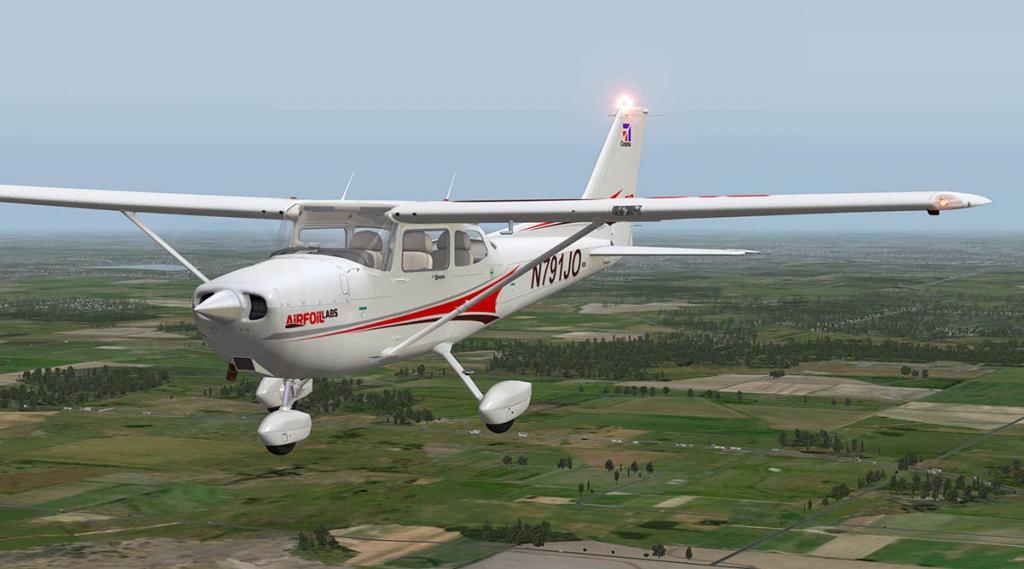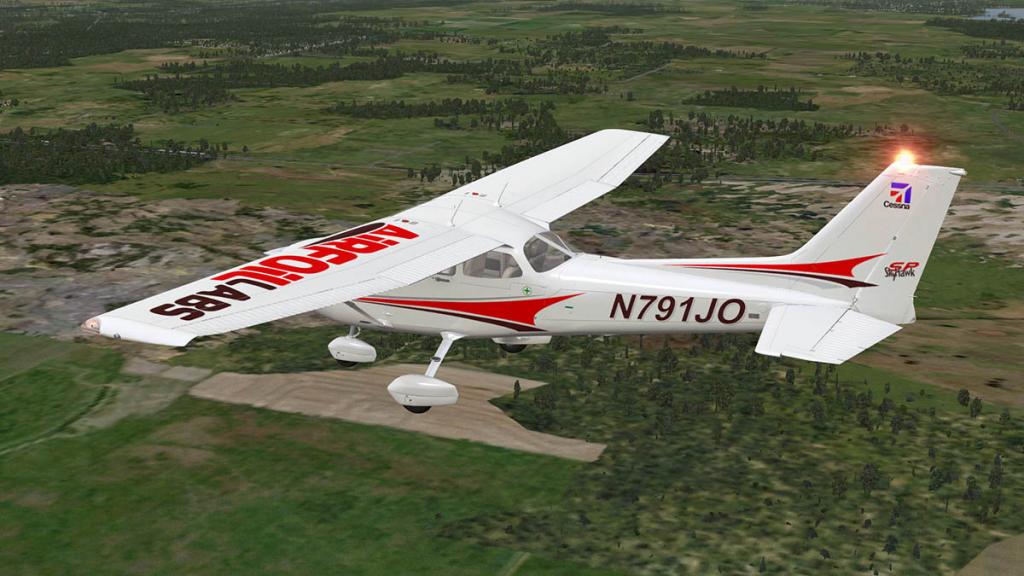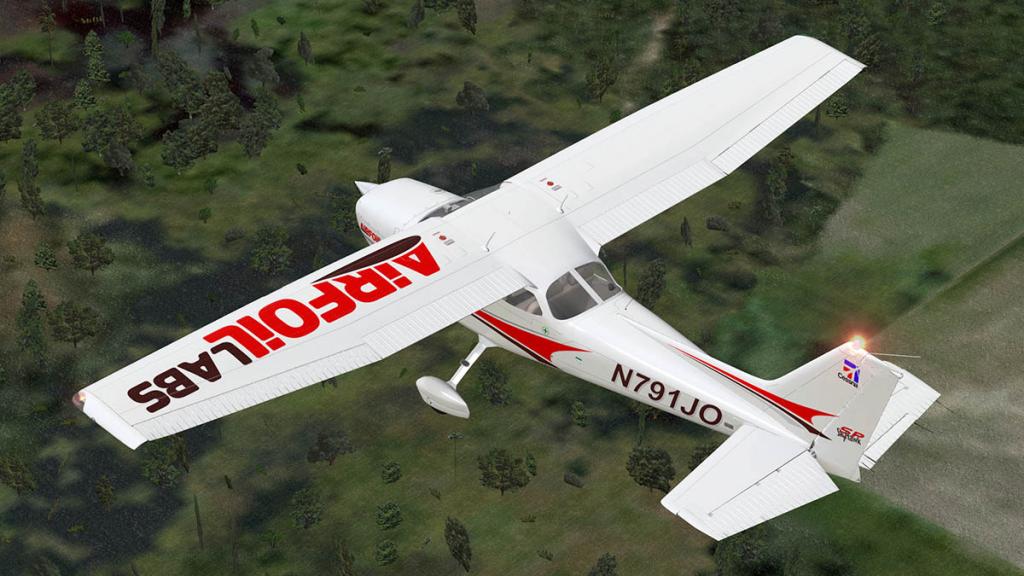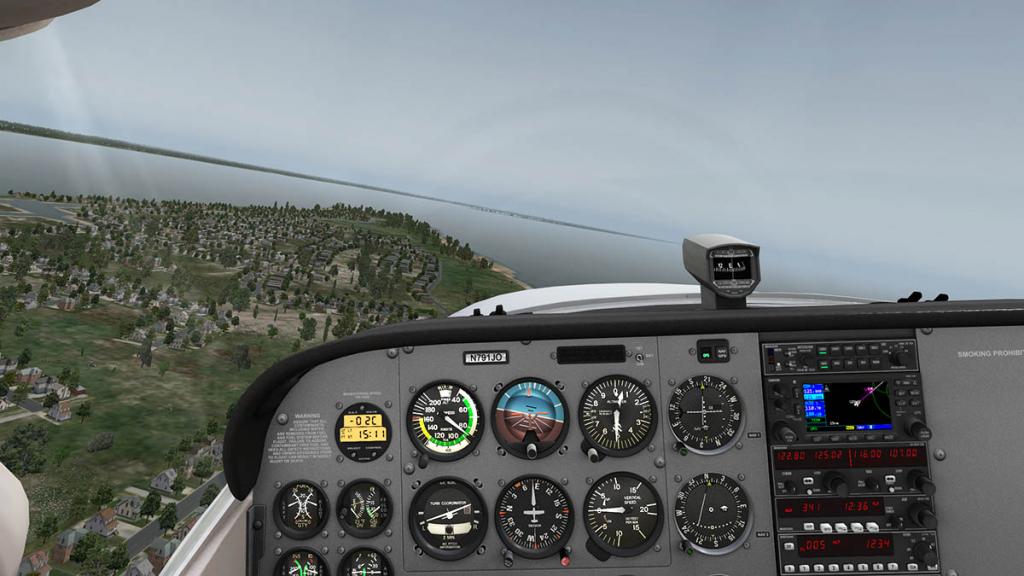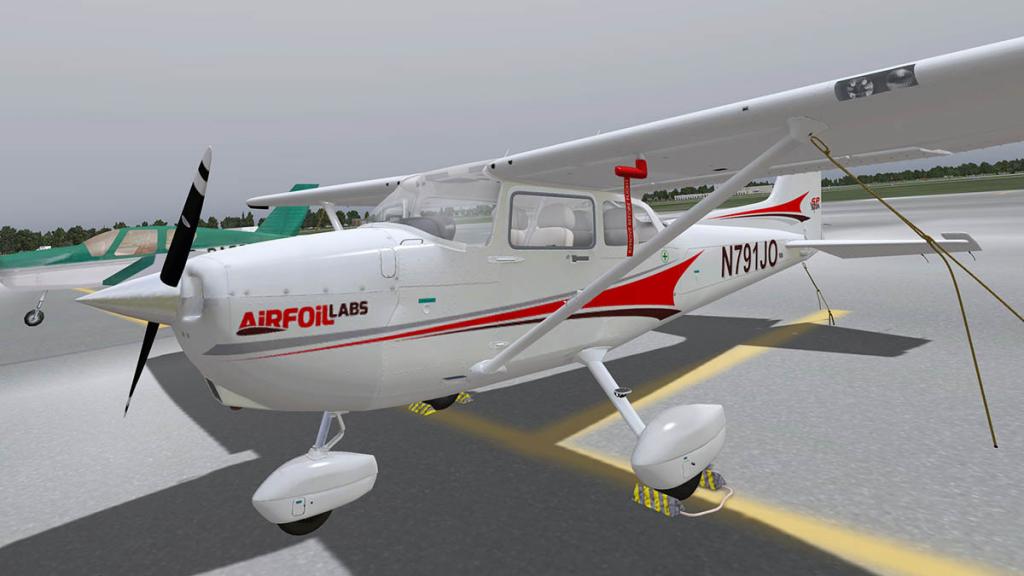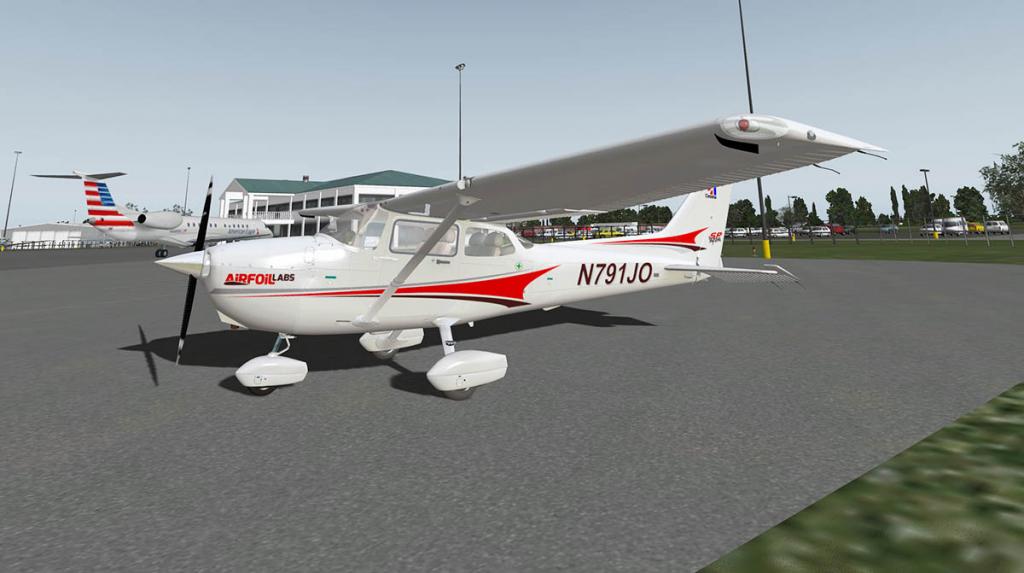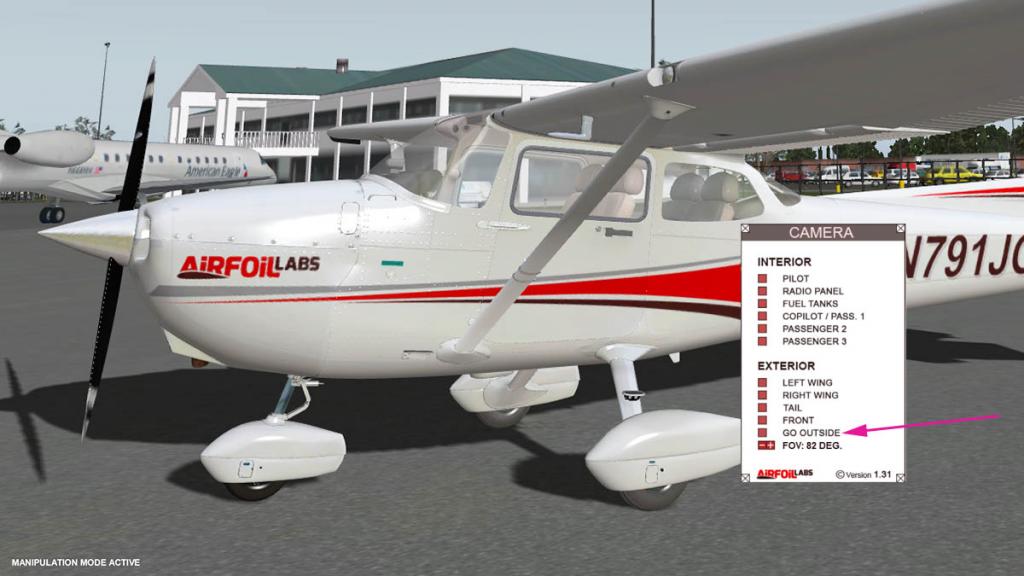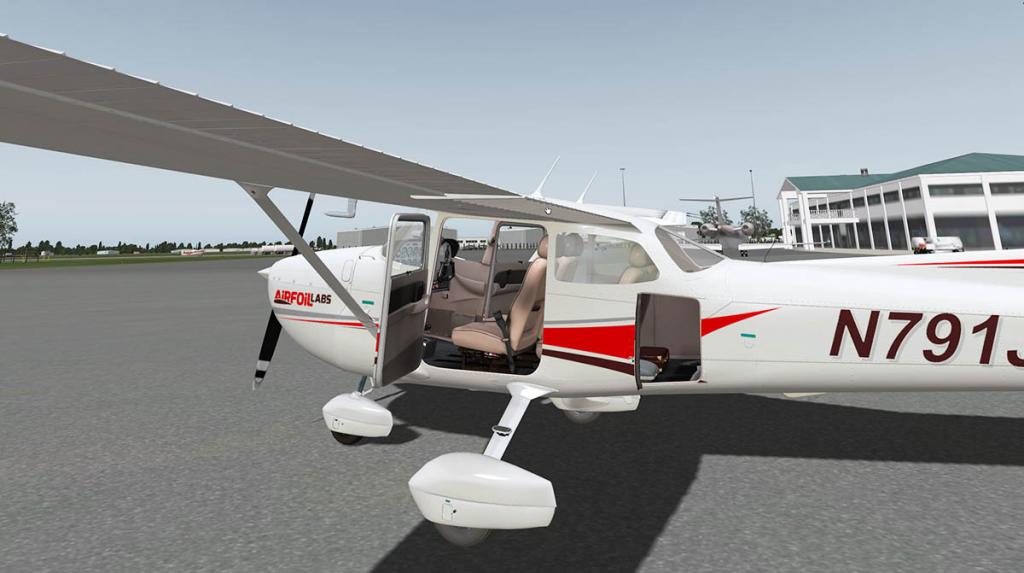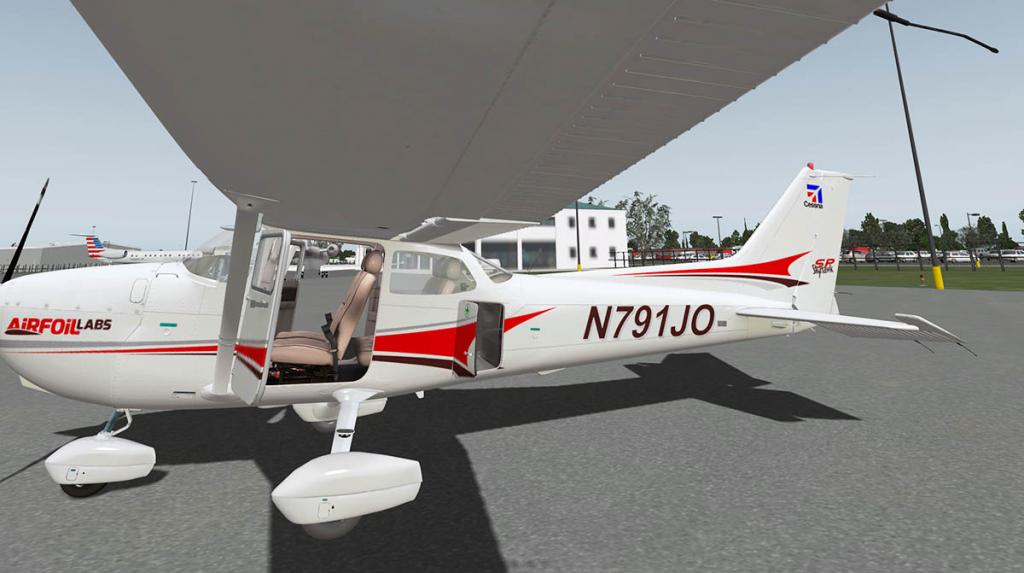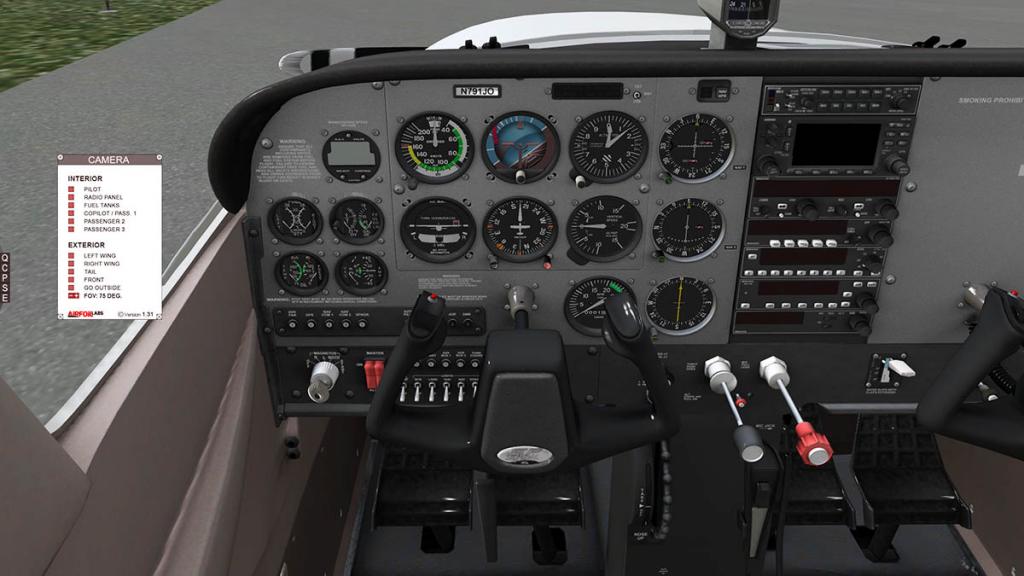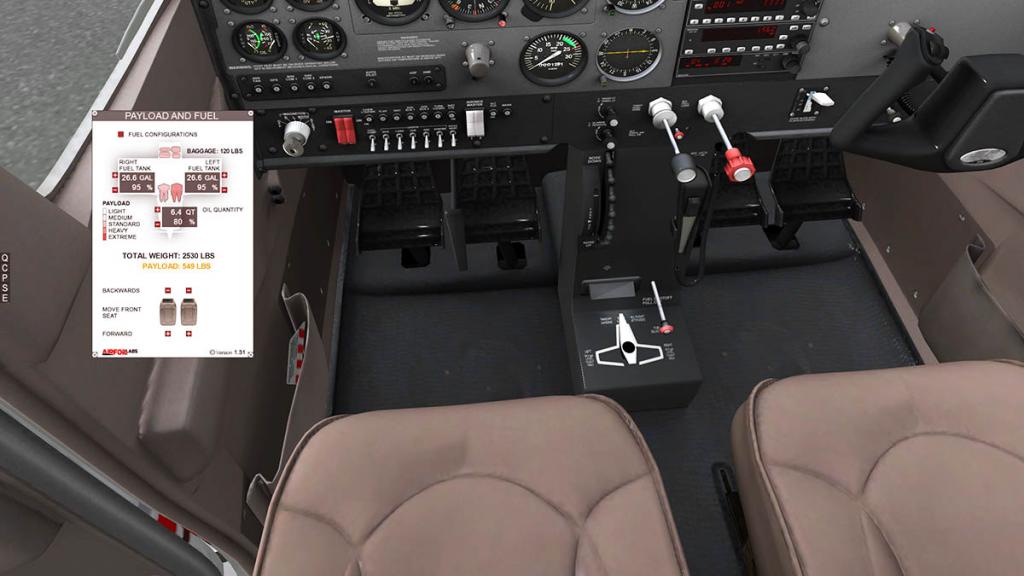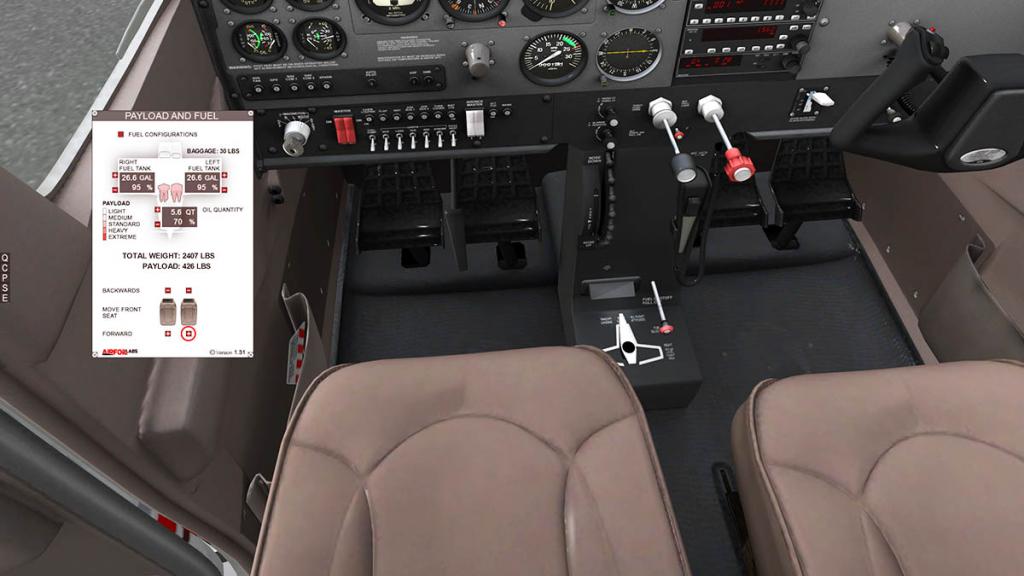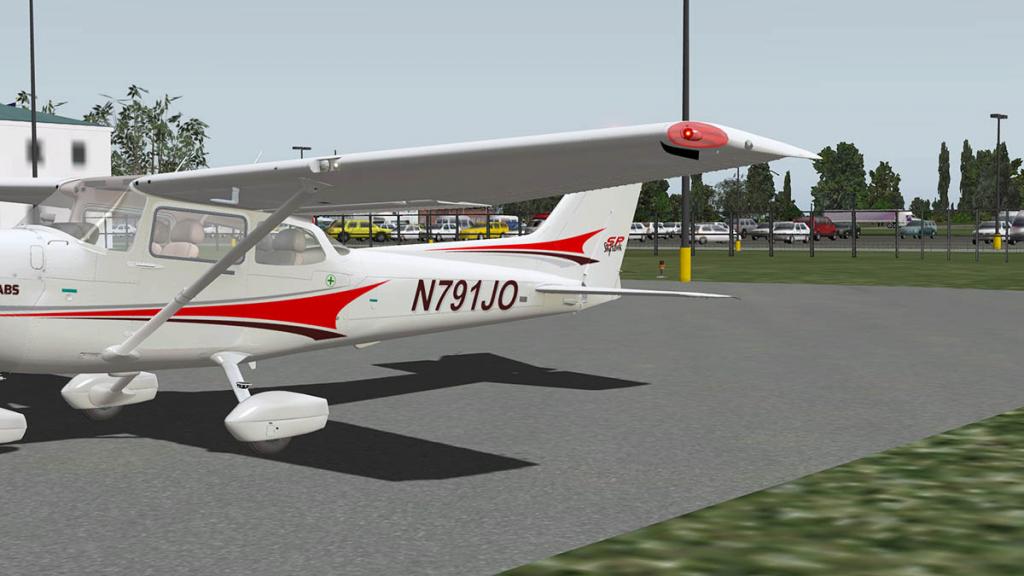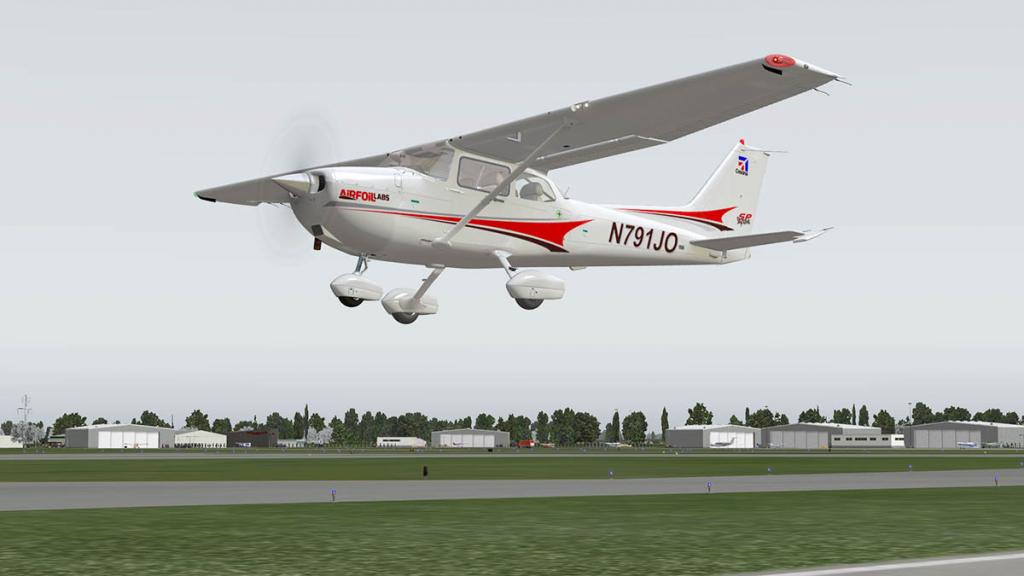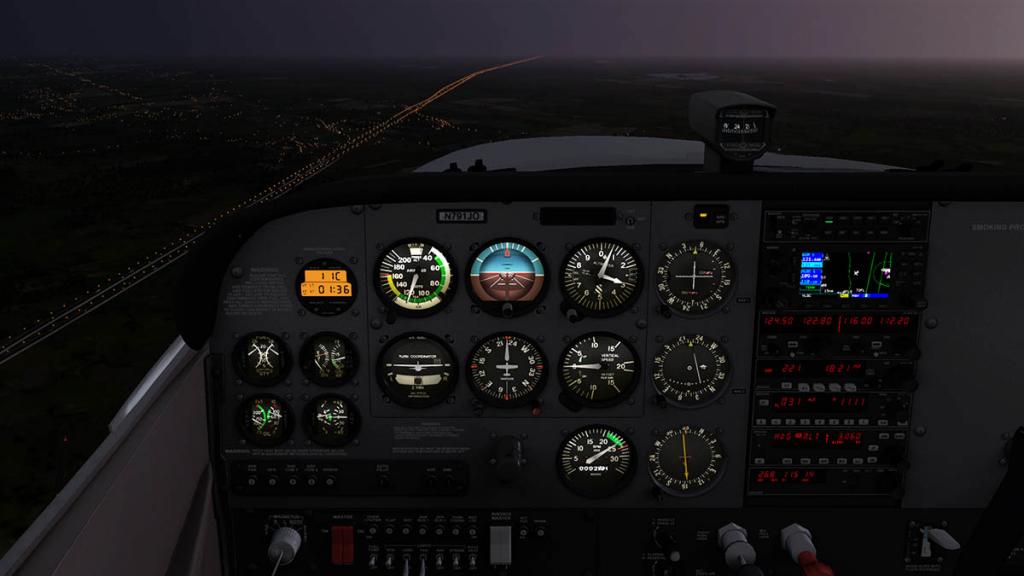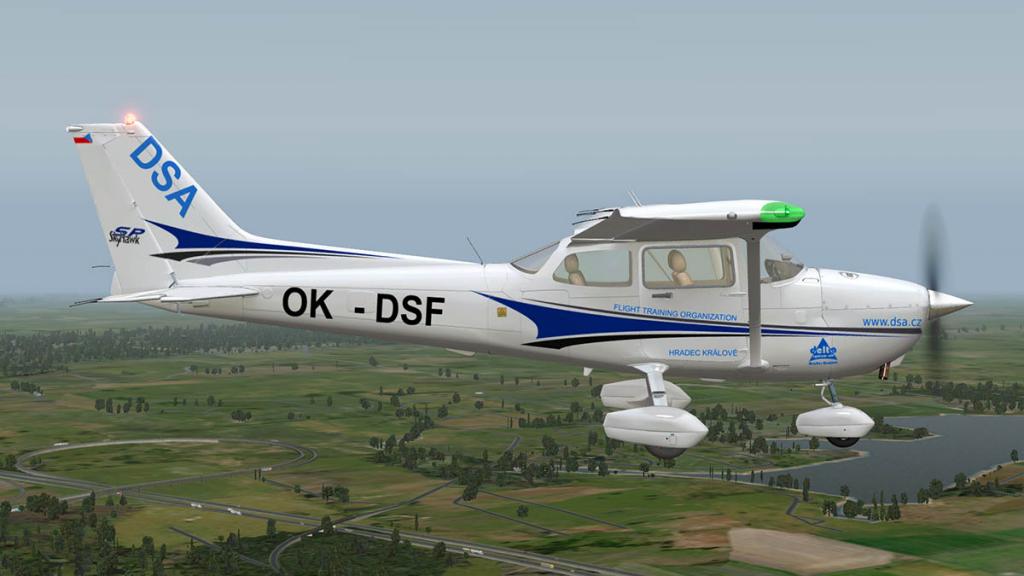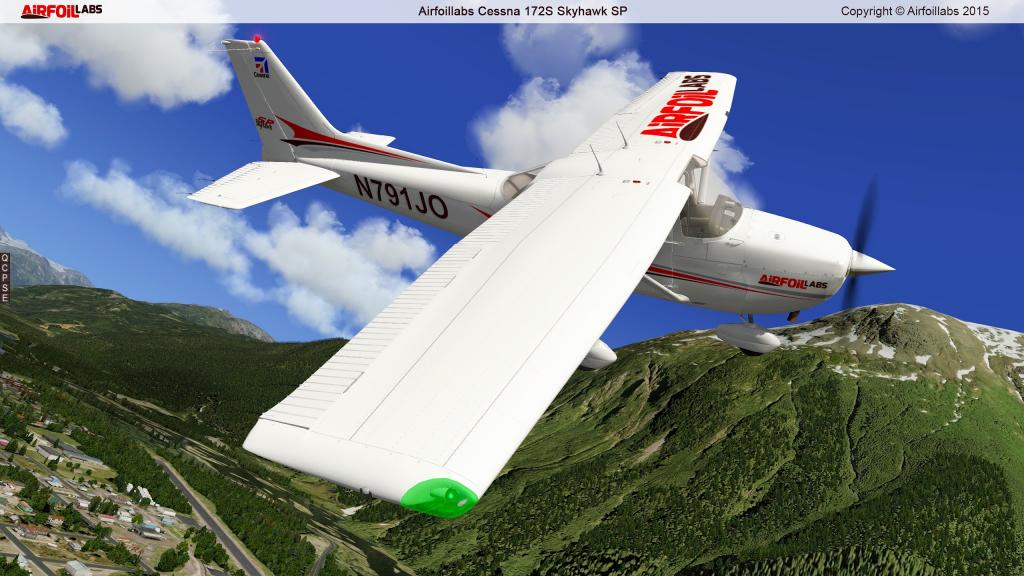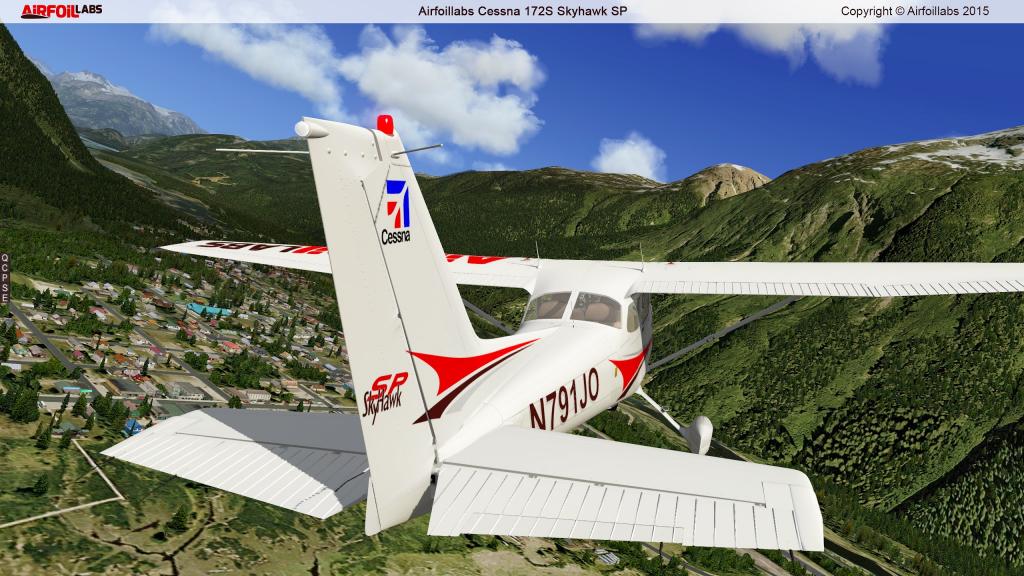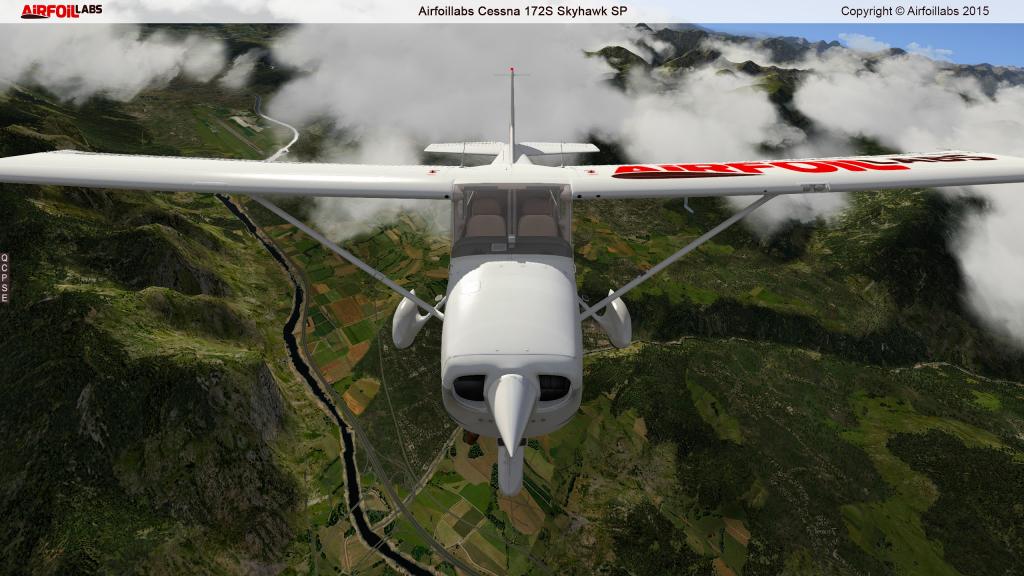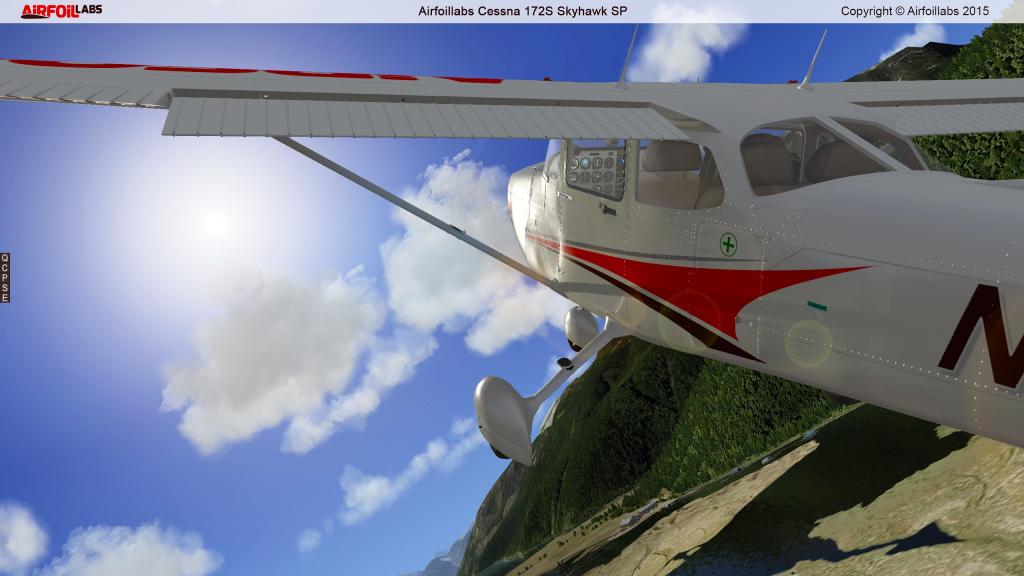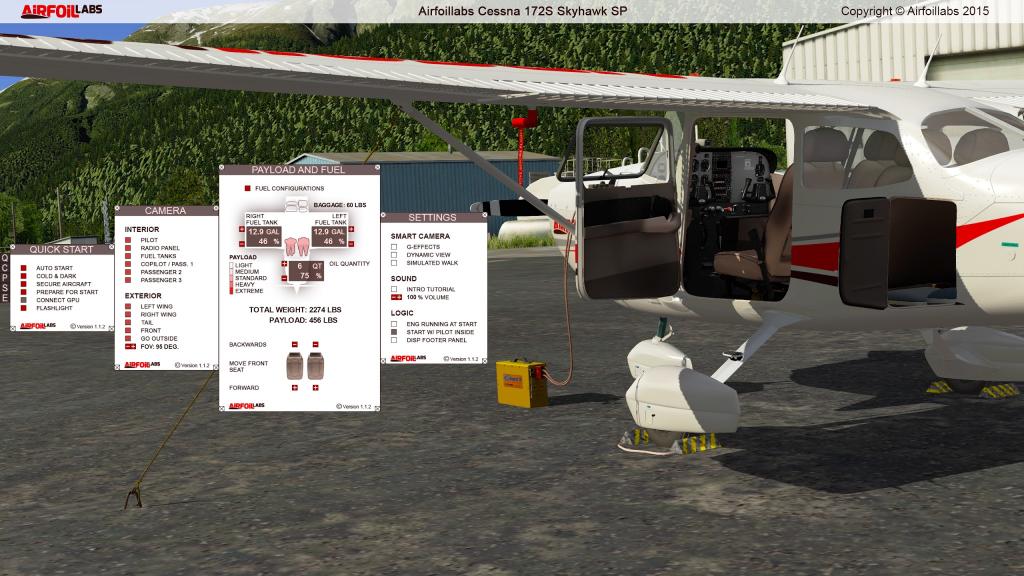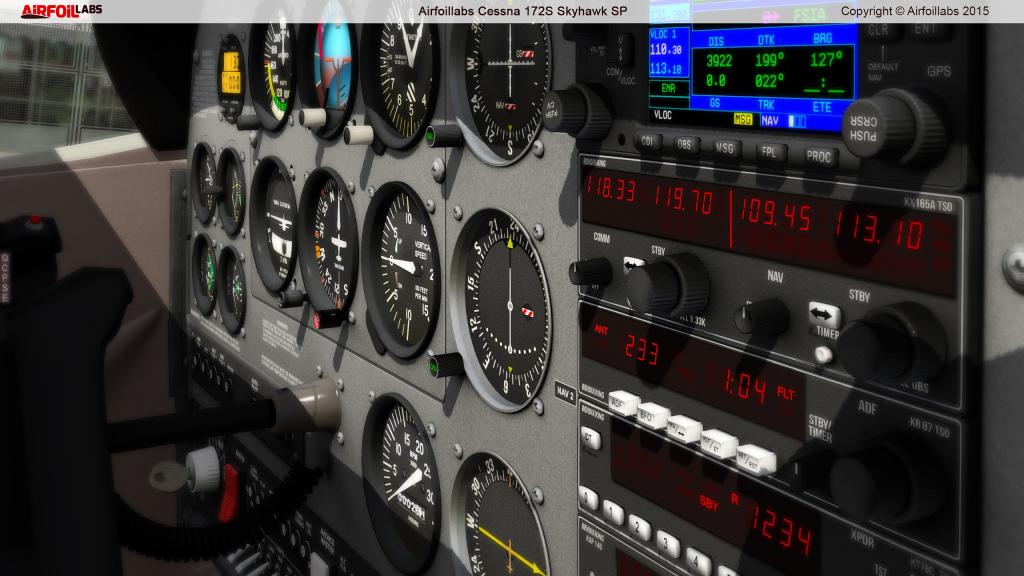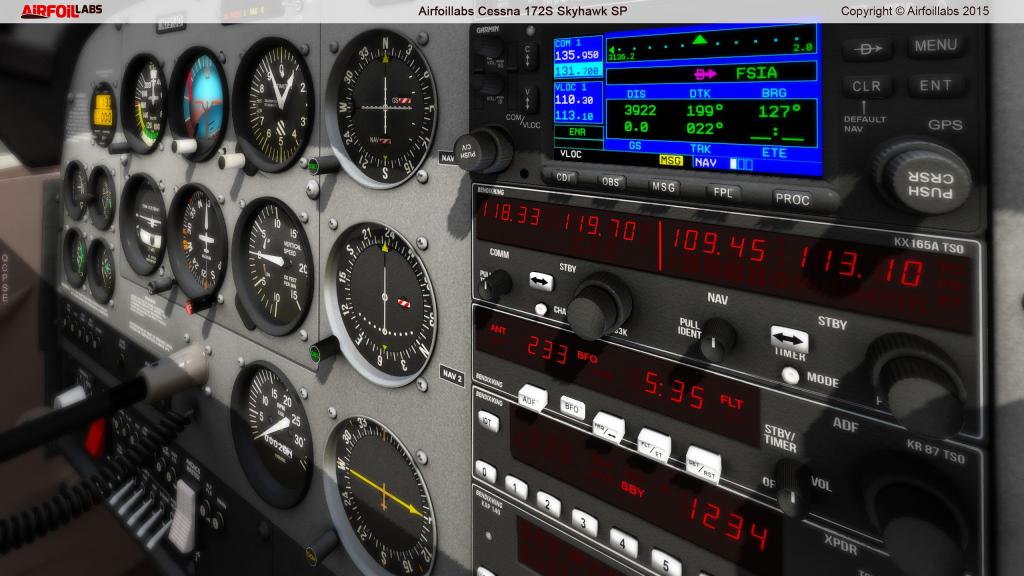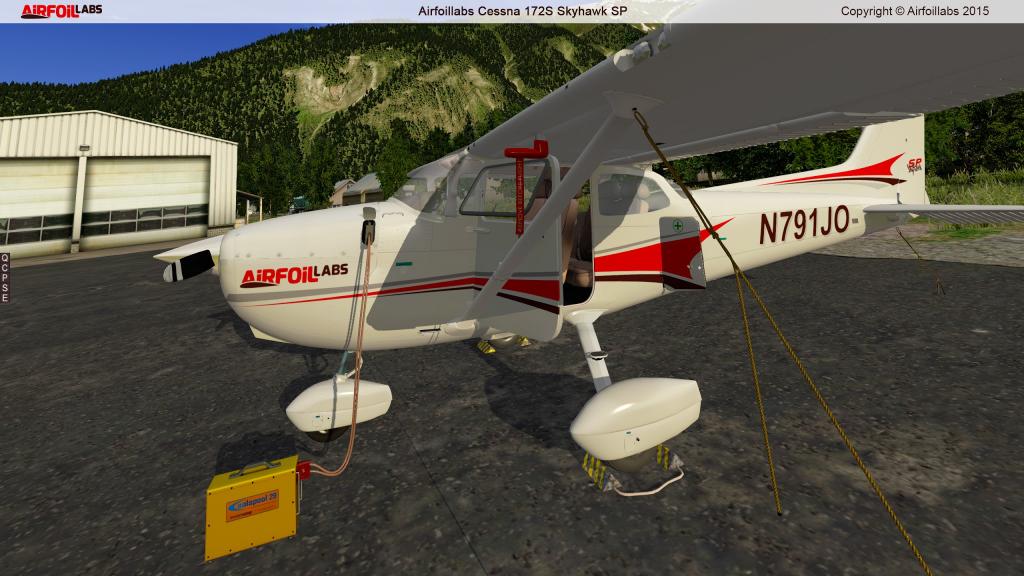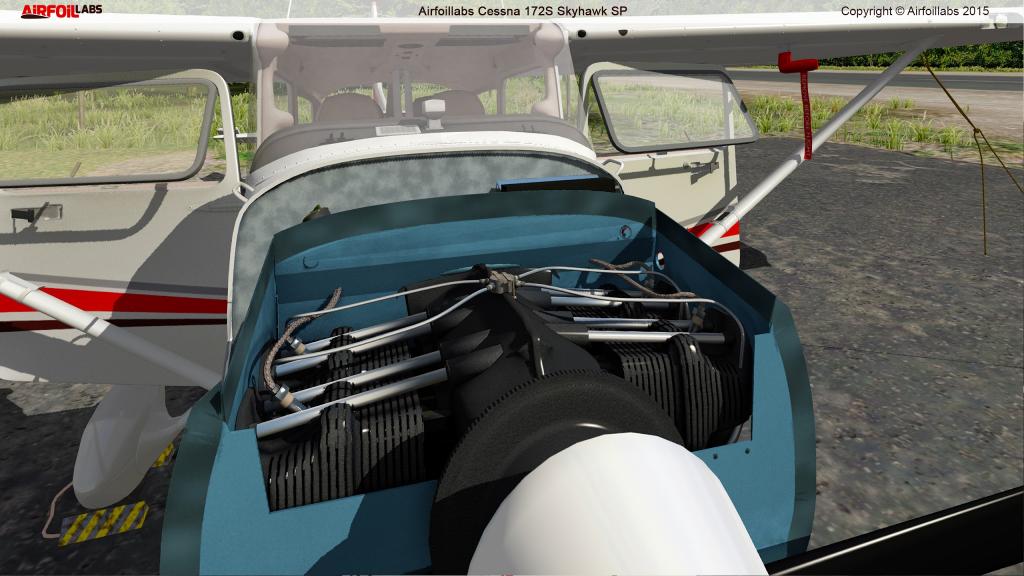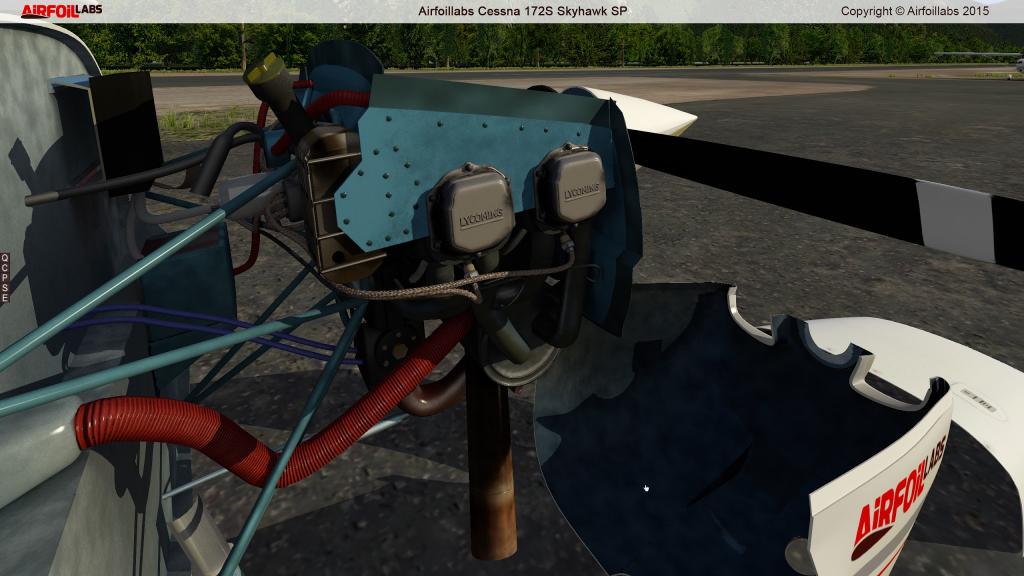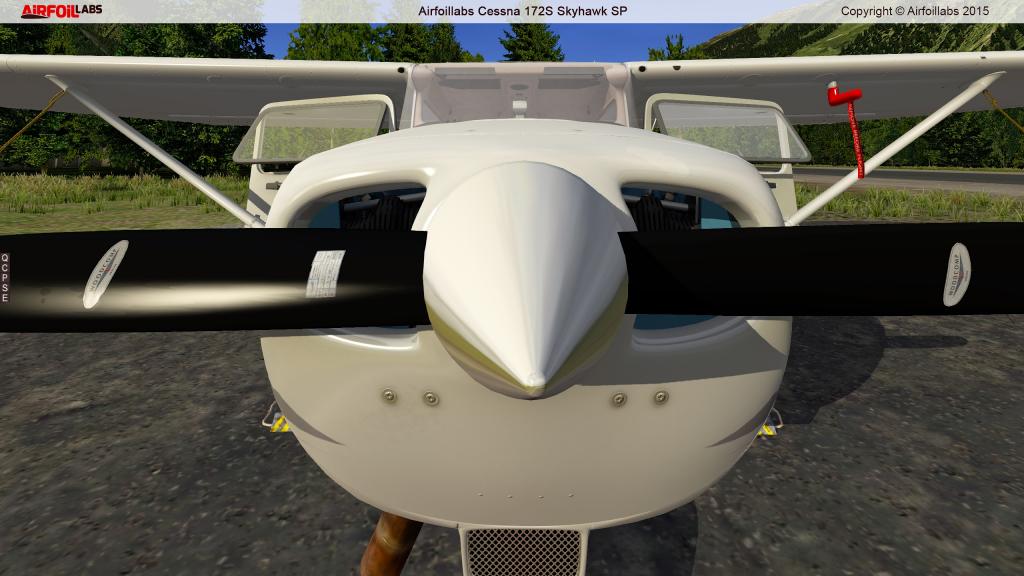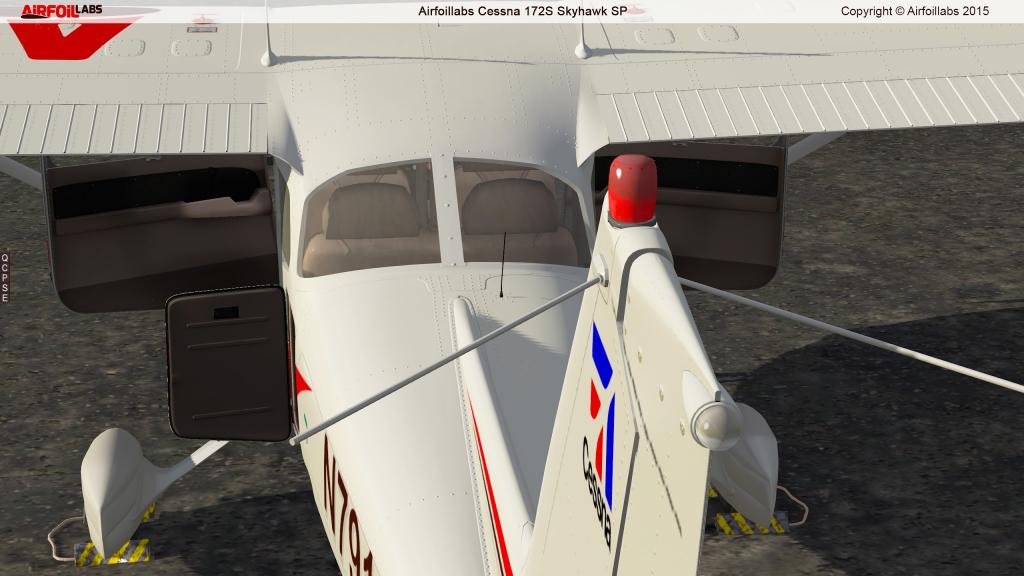Search the Community
Showing results for tags 'airfoillabs'.
-
NEWS! - Variant Release : Cessna 172 NG ANALOG by AirfoilLabs After AirfoilLabs successful Garmin G1000 DIGITAL version of the venerable Cessna 172. Here is the Analog variant of the same aircraft. AirfoilLabs has highly detailed the differences between the two variants. 1. Aesthetic and Experience The ANALOG C172 is a tribute to the golden age of aviation, showcasing beautifully crafted analog gauges. This simulation is not just a flight experience; it's a journey back through time. Every needle and every mechanical component has been meticulously modeled with an extraordinary level of detail, bringing the classic era to life. The animations are layered with realistic behaviors, capturing nuances such as vibrations and turbulence effects, adding to the authenticity of the experience. These features embody the charm and complexity of traditional aviation, making every session with the ANALOG C172 a step into a richly detailed and classic General Aviation experience. The DIGITAL version focuses on modernity with its G1000 avionics. A contemporary approach for modern simulation enthusiasts. 2. Customizable Avionics System The ANALOG C172 takes customization to new heights with its innovative system that allows users to tailor the avionics components in the radio panel stack. This feature empowers users to place and configure their preferred instruments precisely as they desire, ensuring a personalized and satisfying flying experience. Adding to this customization capability, the inclusion of the RXP GTN750 stands out as a notable enhancement, providing users with advanced navigation and flight planning tools at their fingertips. This level of customization in the ANALOG C172 truly sets it apart, offering a deeply individualized and immersive simulation experience. C172 DIGITAL: Includes No Bezels Garmin Displays for a more technologically advanced experience. 3. System The ANALOG C172 distinguishes itself with a uniquely designed electrical system. This system is not only different in its configuration compared to the DIGITAL version but also in the intricate details of switches and circuit breakers wiring. The electrical components and their state are displayed "live" in a 2D window. Additionally, it boasts a distinct lighting system that enhances the overall experience, adding to the authenticity and depth of the simulation. These refinements in the ANALOG C172's systems contribute significantly to its unique character and appeal. 4. Flight Model and Components Differences While the ANALOG version of the C172 shares many flight model and performance characteristics with its Digital counterpart (the original C172 "S"), it stands apart in its intricate mechanical and electrical interconnected components. This differentiation extends beyond mere physical attributes, as we simulate a vast array of potential aircraft failures. The logic governing these failures in the ANALOG version is distinctively different from that in the Digital version. This variance not only adds depth to the simulation experience but also introduces a layer of complexity and realism, making the ANALOG C172 a unique and engaging choice. 5. Distinctive Interior Sound Design The ANALOG version, while featuring the same engine and thus sharing identical engine sounds with its counterpart, distinguishes itself through the unique sounds of its interior components. This differentiation is most evident in the auditory experience of the avionics components, such as the switch sounds, gyro, fans, autopilot, and other internal systems. Each of these components produces its own distinct sound, contributing to a rich and immersive auditory environment that enhances the overall simulation experience. All these samples were recorded in the original aircraft. This attention to the nuanced sounds of each interior element adds a layer of realism and depth, making the ANALOG version a delight for those who appreciate the intricate symphony of aircraft interiors. There are no comments on if there is a discount if you already own the DIGITAL variant of AirfoilLabs C172, it is not noted. But there is already a 10.00(17%) saving on the full price. The best current General Aviation aircraft in the X-Plane Simulator... it has to be right up there for the detail and features! "The most successful aircraft in history the Cessna 172S is now rebuilt from scratch by Airfoillabs for X-Plane as New Generation Airfoillabs Product Series. You can expect unprecedented Study Level Simulation of C172S with Analog Avionics." Designed by AirfoilLabs Support forum for the C172 NG Analog ________________________________ The C172SP NG ANALOG by AirfoilLabs is NOW available here at the X-Plane.OrgStore 172SP NG ANALOG Price is US$59.95 Currently US$49.95... You Save:US$10.00(17%) Requirements: X-Plane 12 (not for XP11) Windows, Mac Intel, Mac Silicon, or Linux 8 GB+ VRAM Recommended Current version: 1.0 (November 17th 2023) ___________________________ News by Stephen Dutton 20th November 2023 Copyright©2023: X-Plane Reviews (Disclaimer. All images and text in this review are the work and property of X-PlaneReviews, no sharing or copy of the content is allowed without consent from the author as per copyright conditions) All Rights Reserved
-
Update Review : Cessna 172SP NG Digital v1.5.1 by AirfoilLabs It was very early in the X-Plane 12 beta or 1.4.0b that I reviewed the Cessna 172SP NG from AirfoilLabs. It was also a moment, in that the future was suddenly laid out in front of the Simulator, this was X-Plane 12, and you saw and felt here all the new benefits it was going to deliver. The bonus of that moment was because, even this early in the evolution of the new X-Plane 12 version. AirfoilLabs had done a pretty good and highly detailed conversion to X-Plane 12. Although the release was noted as a "beta" (1.4.0-Beta (October 10th 2022)), it did cover all the unique aspects of what X-Plane 12 was going to deliver. It was exciting, but also a bit of a relief in that the changes were going to work... It was a review I liked a lot, as it gave us some really great images of cloud formations, before unseen in earlier X-Plane versions. There was another very small tuneup in December 22 (v1.4.1b) for the 172SP, that covered a more detailed Aircraft Performance Tuning for the latest changes in XP12 flight model, an enhanced Camera Initialization Bug fixed and the dark Glass bug that was fixed for the latest XP12 version, really it was all another tight tune to the release of X-Plane 12. This brings us to this update, well two actually. With both v1.5.0 and v1.5.1 which are combined here. Considering both updates, there is not a lot of changes here, but what is important to note is that the aircraft is now officially an X-Plane 12 version, not in a beta. Changes to Version 1.5.0 (August 10th 2023) were small with the G1000 LPV Approaches fixed, those Yoke Erratic Movements were also attended to, and finally the (over) harsh landing sounds have been fixed. The latest update Version 1.5.1 (September 8th 2023) is just as small, call it tinkering if you want to.... Here the Main Landing Gear Leg are not so flexible anymore (slightly harder landings), better Empty Aircraft Initial Attitude, less Tire Skid Sound Effect (connected to the above), and finally the G1000 is Implementing default XP12 Features, in other words the G1000 mirrors the updated X-Plane 12 version. This review is really a reacquaintance of the aircraft. It was then so very early in the beta phase with X-Plane 12 with the earlier release. So what is the aircraft like a year on, I wanted to find out? Product Manager AirfoilLabs use there own external updater system or "Product Manager" to install and update their products. It is very good, but initially also confusing? You can download both an X-Plane 11, and also an X-Plane 12 version of the updater, and both can be installed. All to the good, but it then gets easily confusing on which updater is for what X-Plane version? as both updaters are identical, in not just installing the updater, but in using them... Initially I couldn't find or use the X-Plane 12 version? It's not labeled 11 or 12, even when running the application, it also kept producing and updating only the X-Plane 11 version, and not the X-Plane 12 version? In the end I had to remove entirely the XP11 version and reload the XP12 version to get it to work... even then the application is not anywhere in being noted as the XP12 version of the application, there was a hour lost for this review, in just working it all out? Once updated the "Product Manager" works like this... On starting up, it will show you what AirfoilLabs products are listed in your portfolio. This includes the XJet plugin and version. Important as AirfoilLabs have their own plugin system of all their aircraft (not the usual SASL system) and it has to match the version of the aircraft. Any changes required or new versions are noted in the application. You select a product, then are required to type (cut/paste) in the Serial key to authorise the aircraft. I like this factor, as it means there is no required restart in the simulator (so no slow total redo process to get back to where you already are?). The the installer will look at your current aircraft version and storage capacity, and show you the download file size. Happy it will then install either the full aircraft (product) or update the aircraft to the current version... all the version and changelog changes are shown when the process is completed. The system and use is very good, once you are using the correct X-Plane version. Cessna 172SP NG Digital First look and again the Cessna 172SP really delivers. You currently get a lot of choice in the Cessna 172's in X-Plane 12, and there is a lot of tough competition in the mix. First is the newly released Thranda 172M Skyhawk DGS Series, very good it is. Then there are the two Laminar Research Skyhawks, one analog and the other a Garmin G1000... another but not updated to X-Plane 12 is the Carenado C172 G1000, one aircraft I really liked. A lot of choice, and all good choices as well... so why the AirfoilLabs aircraft? It is a very good question, and one I can answer. There is something quite original about the AirfoilLab's 172, it looks and feels different, but 172 different. For the important aspect of Circuits and Training, if I had the choice of all of the above, then the AirfoilLabs version would still be my selection, the word here is "authentic". As you know if you follow my aircraft or scenery reviews, is that word "Authentic". For me, the whole aspect of Flight Simulators is to get the most realistic experience possible from the combination of the Flight Simulator, Scenery and more importantly the aircraft. If all three combine perfectly then you should get the feeling of real flight, and a real presence of a place. The model here looks totally authentic, very, very real to me in the simulator.... and X-Plane 12 dynamics really bring it alive! The Cessna 172M, is the most popular aircraft ever built with 44,000 units constructed, and production is still going strong. The C172 is popular because it is just that right perfect fit for it's main role... pilot training. The important thing here is just that you have to have complete mastery of the aircraft, if you do, then you feel confident in the machine (that is a very good simulation as well). A stable platform in the aircraft is the total aim. Here you can do that, banks and rolls are perfection, holding the bank whilst not losing (or gaining altitude) is the sign of great aerodynamics, and I could twirl around the sky all day to perfection in the AeroFoilLabs 172. Note the excellent AOA (Angle of Attack) meter in your eyesight. Instrument panel is nicely laid out, clean and efficient, and both the PFD (Primary Flight Display) and MFD (Multi-Functional Display), and both can popout and are highly scalable to size. Set the middle lower panel are the three backup analog instruments for; Airspeed, Artificial Horizon and Altitude. Cabin is very nice... not old, old, but still nicely worn, and yes that word again.... Authentic! Lovely dated and branded "SP Skyhawk", both Yokes can be individually hidden and rudder pedal design is well done deep in the footwell... A side note is the excellent POH or "Pilots Operating Handbook". Situated lower left door pocket, it has a POH introduction, then LIMITS, NORMAL, EMERGENCY and PERFORMANCE data and checklist. Scalable again it is very easy to use. Almost a year on, and I'm flying the same route as that early beta version Brisbane YBBN to Gold Coast YBCG, settings include "real Weather", and yep looking out of my window, the sky looks exactly the same as the X-Plane Simulator download. Unfortunately its a total pristine clear day (early September days in Australia are like that, until the sheer heat kicks in), they can come with no heavy cloud around... but it makes for nice flying. It also shows off X-Plane 12 as well. But I wanted to come up here and see more heavy weather, but you can't doubt the quality of the aircraft and the simulator producing a perfect rendition of the day. I'm very impressed Menus There are a lot of options and menus available on the AirfoilLabs 172SP. The menu options list is sensational, the best in the business, with eight different categories, and 35 different selections... View options include internal and external walkaround. There is a "General" settings panel, and all the main Menu selections are also available on the optional AviTab tablet. Lycoming IO-360-L2A (200hp - 149kW) engine and it's mounting frame and accessories are all here to admire, interactive as well... .... you can check the oil, or see the wear on an engine or system component, you can fail it, or repair the element. All ties downs, inlet, pitot covers, chocks and portable power supply are all available here. Standard or Tundra (large) tyres are also available, as all doors open (cabin and small baggage access). Other options includes several types of wheel covers, or streamline fairings, neat are the small opening flaps in the Wheel Fairings to check the tyre pressures. The Skyhawk is very comprehensive, so anything detrimental? really only one... the Replay doesn't work? press Alt-R and you get an immediate X-Plane CTD or Crash to Desktop, Save a situation and it is a lucky shot as well, I recovered two saves, but also had an instant crash a few times. A better save feature would be a nice addition as the XJet plugin requires custom settings. Finished after a long day's flying... then just wrap up and cover the aircraft for safety, you gotta love it all! As noted earlier, this is just a reacquaintance of the airfoillab Skyhawk and to highlight it's benefits, honestly not much has changed on the aircraft, but you have to acknowledge on how much has changed around the 172SP Skyhawk. X-Plane 12 has evolved hugely over the last twelve months. Even back then you felt the conversion to X-Plane 12 was excellent, and nothing here really changes that aspect, but still the AirfoilLab Skyhawk seems to be better than ever. The main point here is the 172SP itself, like with the Thrandra 172, it is the platform for the pilot that is the most important thing, the line to be at the top of the list. Yes the options list and features all here are outstanding, but the basics have to be perfect if the Cessna is to be usable in the simulator, the 172SP is above all and everything else still a training aircraft, the dynamics and control feel are the most important aspects of this aircraft. This flight down the coast was excellent, everything combined to create a perfect simulation, sounds are great as well, with 320 sounds + detailed, layered engine samples with audible failures simulation.... so there it is this totally "authentic" atmosphere around it, In then I think that is why the AirfoilLabs C172Sp Skyhawk is the highest standard currently in X-Plane if you want a very good Cessna 172SP. Highly Recommended. ________________________________ The C172SP NG DIGITAL v1.5.1 by AirfoilLabs is NOW available here at the X-Plane.OrgStore 172SP NG DIGITAL Price is US$49.95 This aircraft is X-Plane12 supported Requirements X-Plane 12 or X-Plane 11 - both versions included Windows, Mac Intel, Mac Silicon, or Linux 4 GB VRAM Minimum - 8 GB+ VRAM Recommended Current version: 1.5.1 (September 8th 2023) Download for the AirfolLabs 172SP NG DIGITAL is done via an installer "AFL+Product+Manager+Windows+installer" To use the XJet System you have to download the "Product Manager" program and installed on your computer: Product Manager / Xjet 2..0.0) The installer can be downloaded in all Windows (.exe), Mac OS (.app) and Linux (.Jar) forms for your type of operating System. And the final install in X-Plane folder is 2.95gb. Authorisation is now done via the Product Manager. Updates are also done via the same Product Manager. Version 1.5.0-1.5.1 Changelog: AirfoilLab 172SP v1.5.1.txt Designed by AirfoilLabs Support forum for the C172 NG Digital _____________________ Aircraft Review by Stephen Dutton 15th September 2023 Copyright©2023: X-Plane Reviews Review System Specifications: Computer System: Windows - S1700 Core i7 12700K 12 Core 3.60 GHz CPU / 64bit -32 Gb single 1067 Mhz DDR4 2133 - ASUS GeForce GTX 1080 8Gb - Samsung Evo M2 2TB SSD - Sound : Yamaha Speakers YST-M200SP Software: - Windows 11 Pro - X-Plane 12.00B7 (This is a beta review). Plugins: JustFlight-Traffic (X-Plane.OrgStore) US$52.99 : Global SFD plugin US$30.00 Scenery or Aircraft - YBBN - Brisbane International by Orbx - YBCG - Gold Coast International by Axonos (Disclaimer. All images and text in this review are the work and property of X-PlaneReviews, no sharing or copy of the content is allowed without consent from the author as per copyright conditions) All Rights Reserved
-
NEWS! - Aircraft Released X-Plane 12 : King Air 350i by AirFoilLabs AirFoilLabs have released their second aircraft for X-Plane 12 in the Beechcraft King Air 350i. Their earlier X-Plane 12 aircraft release was the C172 NG Digital back in October 2022. The King Air 350 is based on the King Air 300 with a 3.4 ft (1.0 m) span increase and winglets, a 2.9 ft (0.88 m) fuselage stretch for an over 17 ft (5.2 m) main cabin, long enough for double club seating. By 1988, Beechcraft had begun work on the replacement for the 300, it was introduced in 1990 and initially marketed as the Super King Air 350. All 350's (350i, 350ER) used twin Turboprop PWC PT6A-60A engines at 1,050 shp / 783 kW - Maximum cruise speed310 kt / 574 km/h. The AirfoilLabs aircraft come with their own unique plugin architecture, called X-Jet, it is a plugin system for X-Plane that provides licensing, software distribution, and automatic updates as well as full integration in X-Plane via the newest X-Plane SDK. It works on Windows, Mac, and Linux. This release is noted as an "Upgrade", as it is a standalone X-Plane 12 release, however owners of the previous King Air 350 XP11 can get the new XP12 version for only $29.95. X-Plane 12 - New Features! Introducing the ultimate software overhaul for an unparalleled flight experience! Our latest update brings a suite of exciting enhancements, fixes, and features that will take your simulation to new heights: * New Custom Failures Logic * Flight Model Rebuild from Scratch * New Engine Logic and Performance * 3D Model and Texturing Enhancements * Windshield Rain, Ice, and Wipers * Anti-Ice System Redesign * New Governors, Prop Pitch, and Feathering Logic * FMOD Sound Updates and New Features * Enhanced Cam Implemented * Pressurization System Fix + Explosive Depressurization Failure * Automated Checklists Fixes * It is a STUDY SIM level aircraft. * But you don’t have to be intimidated by the complexity of the systems - You are always just one click from the sky. If you are a deep learner and enthusiast, you can plunge yourself and study complicated systems in detail. All this is possible down to our super-friendly interface logic. * Stopping the aircraft, starting the engines, was never easier. But if you like a specific state of the aircraft, you can choose, for example, the Before Taxi state or Save and Load your own state. Designed by AirfoilLabs Support forum for the King Air 350 XP12 Images are courtesy of AirFoilLabs This is only an X-Plane 12 aircraft! The AirFoilLabs King Air 350 XP11 is also available, but not both in the one package. ________________ Yes! the KING AIR 350i for X-Plane 12 by AirFoilLabs is NOW available from the X-Plane.Org Store here : KING AIR 350i for X-Plane 12 Price is US$49.95 Owners of the previous King Air 350 XP11 can get the new XP12 version for only $29.95. No coupons required, the discounted price will show when you are logged in. if you don't see the discount please contact X-Plane.OrgStore sales. Requirements X-Plane 12 (not compatible with X-Plane 11) Windows, Mac Intel, Mac Silicon, or Linux 4 GB VRAM Minimum - 8 GB+ VRAM Recommended Current version: 1.6 Beta (April 13th 2023) Requires the full X-Jet Installation via the AFL (AirFoilLabs Product Manager) ________________ News by Stephen Dutton 14th April 2023 Copyright©2023: X-Plane Reviews Disclaimer. All images and text in this review are the work and property of X-PlaneReviews, no sharing or copy of the content is allowed without consent from the author as per copyright conditions) All Right Reserved.
-
Aircraft Update - C172 NG Digital X-Plane 12 by AirfoilLabs This is Version 1.4.0-Beta of AirfoilLabs Cessna NG 172SP, and an aircraft with X-Plane 12 elements as part of the package. It is signed as a "Beta" version and not as a X-Plane 12 compliant aircraft, it works and flies (actually very well) in X-Plane 12, but as the development Beta goes on, this is not the final form of the aircraft for X-Plane 12. The C172SP NG Digital was introduced into X-Plane 11, early December 2021, so it is basically only 10 months old. It comes with a very extensive package of features (yes the feature list is one of the longest in X-Plane), but also brilliant modelling and quality detail. A full comprehensive review of the X-Plane 11 aircraft release is here: Aircraft Review : C172SP NG DIGITAL by AirfoilLabs With the introduction of the KingAir 350. AirfoilLabs also introduced their own plugin system called XJet. (most developers use the SASL System). Which can be a tricky thing to do and that proved to be just so as the Plugin on release was quite buggy in the KA 350 aircraft. But this is now a few years on, I found this time around that the XJet Plugin is now very refined (now up to version v2.0.0) To use the XJet System you have to download the "Product Manager" program and install it on your computer: Product Manager / Xjet 2..0.0) The installer can be downloaded in all Windows (.exe), Mac OS (.app) and Linux (.Jar) forms for your own type of operating System. Notable is that for X-Plane 12, is that you have to download a new "Product Manger" for X-Plane 12... which can be done when you update or purchase the C172 SP aircraft. So it is a completely new install for X-Plane 12. The "Product Manger" is installed in your X-Plane/Plugins folder, and is accessible via the Banner/Plugins Menu. If the aircraft is available it will show up in the Product Manager, the initial release version is v1.4.0-Beta, just select to load... First you must find the X-Plane 12 "Aircraft" install address, then insert your authorisation number (key), if correct you will get a "Activated" signal. Then you install the aircraft remotely which is around a download of 1.2Gb in size... to wrap up the installation, you have to agree to the "License Agreement". The Startup screen with a rotating aircraft scenario (You can disable this startup option if you want to) is still quite impressive. First a few notes... This review is in X-Plane 12 v12.7b (brand new Beta). Secondly I was only going to do a orientation flight (YBBN - Brisbane to YBCG-Gold Coast), but it looked so good I switched it around for it to be the main update review... it is "Dark" or darker that what I usually put out (Sorry about that), but the visuals deserved to be seen with the real weather exactly the same as outside my window, but in also being an early dawn flight. "It hits you between the eyes". WOW it was so dramatic, sensational with the AirFoilLabs C172 SP in X-Plane 12... Great morning for a flight! X-Plane 12's clouds here are overwhelmingly good, and yes as noted in being exactly like it is outside my window, heavy low cloud with breaks of light. X-Plane 12 lighting (external) is still not right here, so don't look at the taxi/landing lights as the final version. Notable is that the toe-brakes are now more refined, and not as so sharp, so softer means more control while taxiing and even for the initial start of the takeoff run. Just look at that centre image, the realism is now utterly simply unbelievable, "Viva X-Plane 12"... Once clear of the field (YBBN) you track south. The main feature (Besides X-Plane 12) in this release is the "External Camera Enhancements" and "Internal Camera Enhancements" (G-Forces), that can be found on the "Settings" menu panel. Note the lower new adjustment selection for the toe-brakes. On the External effect, you get a pull to the tail on the animation (note, if you start up in the earlier rotating aircraft scenario, it is best to turn the feature off, as it interferes with the rotation effect?) Internally you get movement to the G-Forces, and they are very similar to the XPRealistic Effects. We have complained about X-Plane's weak weather for as long as I can remember, but you have to admit X-Plane 12's weather engine here is bloody impressive! Real clouds with real immersion, I'm totally in love. X-Plane 12 features include a total rebuild of the Flight Model from the ground up for XP12, with new (dynamic) Airfoils. There are also new Weight & Balance corrections, Failures and the Wear (and tear) is better tuned and sensational X-Plane 12 Rain, Fog, and Ice effects are also now active on the aircraft. The modern FMOD system is now better in FMOD2, but still with the 320 sounds plus all the detailed layered engine samples and full audible failures. 360º dynamic sounds are also still spectacular, if the best in the business, so yes of course I really like them. G1000 custom features compatibility for XP12, including the new ATC boundaries, and I like the "GARMIN" titles as well for authenticity. Both PFD and MFD displays can not only pop-up (out), but can be separated and lose their bevels for Home Builders. We mentioned the new "Flight Model" before and basically I think it is excellent, but currently overshadowed by the Beta issues, as I find excessive wind (at all levels) is not currently realistic, so it is pretty hard to make judgements while being thrown around the cabin, ditto the internal lighting, which still feels too dark. Lighting fully adjusted it doesn't really affect the cabin much? But this is not a developers issue(s) but Laminar Beta issues, so ignore them. The cabin textures have been tweaked for X-Plane 12, and they feel basic compared to say Aerobask, but still in tune with a basic C172SP in trim. Overall the cabin fitout and detail is impressive. I hit the coast just south of Surfers (Paradise), then a turn right to line up to YBCG (Gold Coast) Rwy 14... Burleigh Hill, then Palm Beach and over Currumbin Creek, now on finals. I'm fighting excessive wind, but with only 2 knts on the instruments says something's not right with the Beta? "Steady, Steady", The AirfoilLabs C172SP is incredible to fly, you have complete control and a perfect balance to show off your flying skills, realism 101. It is why you do simulation. You want that totally realistic experience and the level of immersion goes up every year, but with X-Plane 12, you have jumped a graded few years into the future, but that futuristic realism is available here to you now. VR compatibility is now also initiated on the AirFoilLabs C172SP for X-Plane 12, so you can go even deeper if you have a Vertical Reality setup. Landing is tricky with the crosswind, but the revised Landing Gear forces have been given a tune-up in X-Plane 12 to give you more feel on the touch. Note the realistic exhaust effects, I like the way the effect changes to the power outputs. The menu options list is sensational, the best in the business. There are also 47 liveries provided with the 172, yes FORTY SEVEN. That covers most areas that has this aircraft still in operation. The USA gets the bulk of the action with 23 liveries, the rest are Europe (but only one G- Rego) and two in Australia. Four are shown here. At the bottom of the internal view icon is the "QuickLook" system. Here you can assign keys or a HAT SWITCH with the AirfoilLab's Camera Commands to navigate visually more quickly around internally in the aircraft, you can customise the view settings as well... it is just another take on the X-Plane Number views system, but with far more options. This has also been revised for X-Plane 12. "It's love at first flight"... _____________________ Summary Only ten months since it's X-Plane 11 release in December 2021, and here is the AirFoilLabs Cessna 172SP update version for X-Plane 12. Notable that this version (v1.4.0-Beta) is the X-Plane 12 Beta configuration, and not the full compatible version for X-Plane 12. The C172SP comes with a very extensive package of features (yes the feature list is one of the longest in X-Plane), but also brilliant modelling and high quality in detail. This X-Plane 12 update is free for current X-Plane 11 purchasers, but you have to download a new version of the "Product Manager" to install the aircraft for X-Plane 12. New features include; External Camera Enhancements and Internal Camera Enhancements (G-Forces), VR Capability, Toe Brake refinement, better internal textures, and no bezels on the G-100 avionics package. X-Plane 12 revisions include; New Flight Model (very good), New Airfoils, better Wear and Tear simulations, Rain, Fog and Ice, Landing Gear forces retuned and G-1000 X-Plane 12 capability. Although already a very highly featured package with a huge amount of detail, the AirFoilLabs C172SP delivers now even more in X-Plane 12. The Cessna looks sensational in the new X-Plane version, and flies far better as well. This was the most immersive and hugely realistic flight I have done yet in X-Plane 12. It was simply really overwhelmingly brilliant, those cloud and skyscapes bring home the real 3d effect of flying an aircraft in a simulator. I'm not going to shy away from the niggles of the Beta v12B7 here. They create over strong winds, dark interiors and shakes to the aircraft that are not realistic. But the brilliant totally overwhelms the niggles, this is the future of X-Plane Simulation, and the AirFoilLabs C172SP is a really big part of that overall experience, this possibly the very best Cessna 172SP for X-Plane, maybe even in Simulation. So what more could you ask for.... Highly Recommended! ________________________________ The C172SP NG DIGITAL v1.4.0 by AirfoilLabs is NOW available here at the X-Plane.OrgStore 172SP NG DIGITAL Price is US$49.95 This aircraft is X-Plane12 supported, but to note it is in Beta form. Requirements X-Plane 12 or X-Plane 11 - both versions included Windows, Mac Intel, Mac Silicon, or Linux 4 GB VRAM Minimum - 8 GB+ VRAM Recommended Current version: 1.4.0 Beta (October 11th 2022) Download for the AirfolLabs 172SP NG DIGITAL is done via an installer "AFL+Product+Manager+Windows+installer" To use the XJet System you have to download the "Product Manager" program and installed on your computer: Product Manager / Xjet 2..0.0) The installer can be downloaded in all Windows (.exe), Mac OS (.app) and Linux (.Jar) forms for your type of operating System. And the final install in X-Plane folder is 2.95gb. Authorisation is now done via the Product Manager. Updates are also done via the same Product Manager. Version 1.4.0-Beta Changelog: Version 1.4.0-Beta (October 10th 2022) Changelog.txt Designed by AirfoilLabs Support forum for the C172 NG Digital _____________________ Aircraft Review by Stephen Dutton 13th October 2022 Copyright©2022: X-Plane Reviews Review System Specifications: Computer System: Windows - S1700 Core i7 12700K 12 Core 3.60 GHz CPU / 64bit -32 Gb single 1067 Mhz DDR4 2133 - ASUS GeForce GTX 1080 8Gb - Samsung Evo M2 2TB SSD - Sound : Yamaha Speakers YST-M200SP Software: - Windows 11 Pro - X-Plane 12.00B7 (This is a beta review). Plugins: JustFlight-Traffic (X-Plane.OrgStore) US$52.99 : Global SFD plugin US$30.00 : RK Apps XPRealistic v2 - US$34.99 Scenery or Aircraft - YBBN - Brisbane International by Orbx - YBCG - Gold Coast International by Axonos (Disclaimer. All images and text in this review are the work and property of X-PlaneReviews, no sharing or copy of the content is allowed without consent from the author as per copyright conditions) All Rights Reserved
-
NEWS! - UPDATE : C172 NG DIGITAL v1.3.1 by AirFoilLabs Since it's release on the 14th December 2021, AirFoilLabs have done three subsequent updates on their excellent C172 DIGITAL aircraft. The first was just a minor quick update (v1.1) after the release on the 20th Dec 21, they then followed that version up with a slightly more comprehensive one in the middle of January 22 (v1.2 12th Jan). And here is the big one in v1.3.1 (14th Feb 22), and quite a fix list it is. Most of focus in v1.3.1 update has been on the 2d panels and a lot of performance tuning... oh and the Hanger now also plays music if you own the AirFoilLab's KAWO Arlington Area scenery. Version 1.3.1 (February 14th 2022) GPU - cable connect sound missing Fuel Consumption tuned Cylinder Head Temperature tuned Oil Temperature Tuned New graphics features on 2d Engine Panel 2d Central Panel - Fuel selector bug 2d Central Panel - Trim manipulator and indication corrected 2d G1000 panels - button animations corrected 2d G1000 panels - now dimmable Failure System Logic - deactivated during Replay Mode to prevent incorrect failures Interior animations fixed during Replay Mode Cockpit Builders/Custom controllers - additional documentation and commands added Quick View system / Memorized Views now working correctly also in external cameras Intro Logic corrected Hangar Music now playing all songs 2d Throttle Panel Manipulators refined 2d Switch Panel Manipulators added functionality The "Enhanced Engine Panel" diagram is noted in the release for the new 2d panel details. Full comprehensive X-PlaneReviews review is here; Aircraft Review : C172SP NG DIGITAL by AirfoilLabs The best current General Aviation aircraft in the X-Plane Simulator... it has to be right up there for the detail and features! "The most successful aircraft in history the Cessna 172S is now rebuilt from scratch by Airfoillabs for X-Plane as New Generation Airfoillabs Product Series. You can expect unprecedented Study Level Simulation of C172S with G1000 Avionics." Support forum for the C172 NG Digital ________________________________ The C172SP NG DIGITAL by AirfoilLabs is NOW available here at the X-Plane.OrgStore 172SP NG DIGITAL Price is US$49.95 The v1.3.1 update is free to all current purchasers of the C172SP NG DIGITAL, just go to your X-Plane.OrgStore account and download the new version. This aircraft is a noted aircraft for X-Plane11 but X-Plane12 will be supported. Requirements: X-Plane 11 X-Plane 12 - Planned ! Windows, Mac or Linux 4 GB VRAM Minimum - 8 GB+ VRAM Recommended Current version: 1.3.1 (February 14th 2022) ___________________________ News by Stephen Dutton 16th February 2022 Copyright©2022: X-Plane Reviews (Disclaimer. All images and text in this review are the work and property of X-PlaneReviews, no sharing or copy of the content is allowed without consent from the author as per copyright conditions) All Rights Reserved
-
NEWS! - KAWO Arlington Area UHD by AeroFoilLabs In the release of the AeroFoilLabs Cessna C172SP NG DIGITAL, AirFoilLab's noted that an accompanying scenery with active elements relating to the C172SP would be released in the near future. And here it is in KAWO Arlington Area UHD. Based around the Arlington Municipal Airport (ICAO: KAWO, FAA LID: AWO), Arlington is a public airport located three miles (5 km) southwest of the central business district of Arlington, a city in Snohomish County, Washington, United States. Extensive is not a word used lightly here... as the scenery includes includes 3 airports (KAWO, Fugios Ranch, and Gabriel's Farm), 2 Adventure Stillaguamish Riverbank Landing Spots, the City of Arlington and the full surrounding neighborhood. When using the AirFoilLab's C172SP it also interactively controls a remotely controlled hangar, 3D Navigational Aids, and more. Features Include: Precise representation of the airports and the surrounding area with an immense amount of details Manually edited photo scenery Custom-made HD ground textures, lines, and dirt with realistic reflections optimized for best performance Thousands of 3d objects with PBR normal maps and DDS textures 3d grass and flowers for realistic ambiance All open hangars provided with detailed interior Ground traffic - animated vehicles, people, animals Animated flags with behavior related to weather in X-Plane Users of Airfoillabs C172 NG DIGITAL get a Remotely controlled Hangar, 6 Traffic Patterns for all 5 locations, represented as 3D navigational aids, and quick orientation scenery arrows. The video supplied here is well worth watching for the immense detail included in this scenery, to the point it is overwhelming. Did I mention extensive... this scenery certainly is, and a very good "Walkabout" scenery it is as well.... well worth investigating as a great General Aviation flying base. Both the images and video are courtesy of AirFoilLabs ______________________________________ Yes! the KAWO Arlington Area UHD by AirFoilLabs scenery is now available from the X-Plane.Org Store here : KAWO Arlington Area UHD Price is US$24.95 Requirements X-Plane11 Windows, Mac or Linux. 4 GB VRAM Minimum. 8 GB+ VRAM Recommended. Download Size: 1.1 Gb. Disc space needed: 2.4 Gb Current version: 1.2 (January 12th 2022) ___________________________ NEWS! by Stephen Dutton 19th January 2022 Copyright©2022: X-Plane Reviews (Disclaimer. All images and text in this review are the work and property of X-PlaneReviews, no sharing or copy of the content is allowed without consent from the author as per copyright conditions) All Rights Reserved
-
Aircraft Review : C172SP NG DIGITAL by AirfoilLabs It is September 8th, 2015 and the first aircraft release from Czech studio AirfoilLabs was the Cessna 172SP "SkyHawk". Since that release the development house also released a very substantial KingAir 350, this new aircraft is their third release in the same Cessna 172SP aircraft but this time it is in a digital glass cockpit Garmin G1000 form. The Cessna 172 is the trainer's, trainer aircraft, the workhorse of most flying clubs around the world, first flown in 1955 (over 60 years ago) and there are still 43,000 172's scattered around the airfields of the world. They are the backbone of the General Aviation world, the Volkswagon Beetle of the general aviation plane world, the everyman's aircraft... In other words there is a lot of them and they are part of the aviation scenery all around you. However out of your honey-eyed gilded memories is that the 172SP as an aircraft is also a morbidly slow and a shockingly noisy aircraft, but lets not damage the cloud high dreams. With the introduction of the KingAir 350. AirfoilLabs also introduced their own plugin system called XJet. (most developers use the SASL System). Which can be a tricky thing to do and that proved to be just so as the Plugin on release was quite buggy in the KA 350 aircraft. But this is new project a few years on and I found this time around that the XJet Plugin is now very refined (now up to version v1.5.1) and thankfully this time around we had no nasty gliches in using it. To use the XJet System you have to download the "Product Manager" program and install it on your computer: Product Manager / Xjet 1.5.1 The installer can be downloaded in all Windows (.exe), Mac OS (.app) and Linux (.Jar) forms for your own type of operating System. Product Manager The "Product Manager" Application is used to download and manage your aircraft from AirFoilLabs, install then run and you will get a summary of the aircraft you have sitting in your "AirFoilLabs" Aircraft folder, if not the the installer will not only create the required folder, but also load in the required XJet Plugin into your X-Plane Resources/Plugins folder. Select the Aircraft you want to Update/Install then load in via the "Install New Addon" button, then select (the path address) of your X-Plane installation and then the "Authorisation Key". Then the "Wizard" will do a complete (and Plugin install if required) aircraft installation. After the installation or update the Product Manager will then show you a summary and "Release Notes" of the install or aircraft update and version number. (shown is the original C172SP update). The full process is very good and efficient. Startup X-Plane and select the AirfoilLab's C 172SP NG DIGITAL aircraft... and you also get a very impressive MSFS 2020 Startup screen with a rotating aircraft scenario (You can disable this startup option if you want to). To start the simulation you press the "TAKE CONTROL" banner, and in (or off) you go. The original AirFoilLabs Cessna 172SP "Skyhawk", was at the time a big step forward in quality and detail, and at the time a new level of realism. And the aircraft stands up well even today (AirFoilLabs have noted the aircraft will get the same full NG DIGITAL level upgrade in the Analog version of the C172SP). The NG symbol is to note "New Generation", or a more highly refined version of the Cessna 172SP. In the walkaround of the newer NG DIGITAL aircraft it certainly looks and feels like it is in another level again in quality and detail. Improvements in texture quality, PBR (Physically Based Rendering) and brilliant NML normal, or Dot3 bump mapping have again raised the game significantly. There is the good, or there is the brilliant, and the AirfoilLabs C 172 NG is certainly in the latter category. We marvel all the time now with simulation aircraft detail, but you can still get blown away on just how far we have actually come in the last half a decade, Carenado's were originally very good, but can now look quite stodgy in being compared to the quality that is currently on show. Detail here is simply mindblowing... every component is modeled here, with each assembly quite perfect, but better are the strengthening panels that are perfectly created with the authentic riveting that is also stupendous in quality, it looks and would feel perfectly real. Door hinges have not only the required perfect hinges, but the cir-clip perfection as well. The metal panels, look like metal panels, this includes the fuselage, wings and the corrugated flaps on the trailing edge. Lighting fixtures (here both with separate Navigation and Strobe lights assemblies, (note the amazing inner plastic lighting assembly to the outer metal skin) are again perfection. Every aspect you can remember on a 172 aircraft is replicated here, and in high detail, notable underwing fuel taps and water drainage. The elevator trailing edge wicks not only have the probes, but the excellent metal assembly as well. Tail assembly is again excellent in detail and riveting, the manufacturer's plate is highly visible and nicely indented with the aircraft's details. All Elevator and Rudder components are beautifully recreated and animated. You have a choice between nice wheel fairings, or the naked gear assembly, which is quite simple on the C172... but extremely well done here, note the logo and tyre canvas detailing. I always liked the unhoused wheels, mostly to see the touchdown better. Cabin glass is also highly realistic. It comes with nice thickness, tint and reflections, with no means that you can't fault it. oddly there is no clear glass option, but I don't think you need it here. Note the opening (animated) side window. Before we consider the cabin and interior, we will explore the very expansive and feature rich Menu, that pops out from the left side of your screen as a lot of features in the menu are relatable to the exterior. Notable is that AirfoilLab's always did do these extreme elaborate menus. Menu There are nine rows of options in the Menu System; Aircraft State 2D Panels Ground Objects Options Weight & Balance Failures Settings Situations Hangar Remote Aircraft State : There are FOUR options on the state of the aircraft; Cold & Dark, Before Start, Before Taxi and Before Takeoff. 2D Panels : There are TEN options of pop-up 2D panels; Pilot PFD (Primary Flight Display), Pilot MFD (Multifunctional Display), AUD (Audio Panel), Avionics Panel, Backup Instruments, Start/Circuit Breaker Panel,Throttle/Mixture Panel, Fuel/Pedestal Panel, Electrical System Panel, And Engine Systems Panel. All pop-outs are extremely scaleable (from full screen to absolute nothing!), window pop-out and moveable around the screen, all pop-out panels are highly useable. Note: if you scale too small you may not resize the panel back to normal, as there is no default reset button either? Ground Objects : There are SIX static elements available; GBU (External Battery Power Unit), RBF (Engine inlet covers, tags, flags), Chocks, Tie-Downs, Door, Engine Inlet Heater and (Cabin) Cover. The six optional static elements are excellent. The Engine heater blower is HUGE, and the full quilted cover is a lovely piece of work, there are no door menu options though. Door operation is direct contact on the outer and inner handles. Options : There are EIGHT Options; Fairings (Wheel), Hub Caps, Bush Wheels, Vortex Generators, Flap Gap Seals, AoA (Angle of Attack) Indicator, Tablet and Headset Sound (headset on or off). The Fairings are nicely modeled and fit well, but look a little heavy for such a light aircraft, the Hub Caps are in silver, and I am not crazy about them.... The large bush tyres (sometimes known as "Tundra") are excellent, but not overly large in a balloon look and feel... ... you also have the option of upper wing 'Vortex Generators". "This vortex air flow energizes the normally stagnant boundary layer of air on the wing's surface. An energized boundary layer is more resistant to flow separation than a stagnant boundary layer. The result is that airflow 'sticks' to the wing better, permitting flight at lower airspeeds with improved control authority.” Similar with the "Flap Gap" seals lower wing, to make the wing more efficient and cleaner. Notable is that with these Vortex generator and Flap gap seals and other options, the Flight Model is influenced and adjusted to the new elements. There is a AoA (Angle of Attack) Indicator that is positioned on the top of the glareshield that can be also selected (Via menu and HotSpot)... ... and fixed to the far right of the Instrument panel is an optional "Tablet" very "IPad Mini" in size, it is also a "Menu" system access panel as well, but note that not all of the menu options are available on here. AviTab is also installed on the tablet. Last Option is to lower the volume as if you are wearing a headset, there are a pair of headsets shown in the cabin, but the volume is not affected if you show or hide them, that aspect is done here in the menu. Weight & Balance : The weight and balance sheet is also excellent and it comes in two options (Select Units) of lbs/Gal or kg/l. There is the full extensive list of weights available and the adjustments are numerous with the two standard wing fuel tanks, Crew, Passengers, Baggage and four Presets for both all the Fuel and Aircraft load weights... a full weight graph shows Centre of Gravity and inches aft of datum. Only notes are that the scale left is still noted in "POUNDS" on the Kg selection, but the Weights are thankfully are shown in both units and they can be directly typed in from your keyboard, and the very large panel is not scaleable. Overall the W&B sheet is excellent. Super nice are the options for both different pilots and passengers, their different weights are also calculated with your choice. There are the choices per seat of Seven different people (and their weight) options, or none at all in the seat except for the pilot, who is of course default. The quality of the on board people are excellent, very if extremely realistic and light years away from the frightful crew in the original 172, and all come with animated head movements. Both pilots and passengers can be shown separately, and visible When Outside, Always or Never. Failures : The C 172SP comes with a significant "Failure" system. And covers both the "Aircraft" and "World" Scenarios. All together 175 Individual Components are Simulated and each Aircraft Component has a wear property with custom Logic in which the separate Components have Wear and Failures that are also influencing each other. Each "Scenario" can be set to "Fail At" (Altitude), Set MEAN TIME, Always Fail, Fail at Speed (KIAS) and Time to Failure. Details of each failure is also shown. If a failure has happened it will be noted in the "Failures Screen" and on the Menu icon by turning red... press the right "FIX " (Spanner) ICON to fix all the issues instantly. You can SAVE a Scenario, LOAD a Scenario with 30 Scenarios provided built in, to get you already straight into trouble, Instantly you can FIX ALL Components via the lower button. So overall it is a very comprehensive failure system with multiple failures also allowed and you can STOP/START the failures at any time of your choosing. Settings : There is a "SETTINGS" panel to cover FOUR areas in General, Sound, G1000 and User Interface. In General, you have options to... Save (current) Aircraft Configuration, so when you come back to the aircraft it will be the same as you left it. Save (current) Aircraft Condition, is the same but for wear and failure states. Both Pilots and Passengers can be shown separately, and visible When Outside, Always or Never. In Sound, you have options to... Hear "Environmental Sounds" (i.e. Wind, Rain and Ambiences) outside of the aircraft. Pilot/CoPilot Callouts "V1, VR, V2 etc. The "Callout" Volume and "Checklist" Speech Volume. In G1000, you have the option to... Disable the Aural Warnings (cautions and warnings). In User Interface, you have the options to... (Delay) the Popup Displays from "Instant to 2 secs". Situations : The AirfoilLab's C 172 SP comes with a SAVE/ LOAD situation interface. Here you can Save a situation, then Load it back in to your own desire. Hangar Remote : The Remote is for opening a hangar door in the AirfoilLabs KAWO UHD Scenery, that will also have playing music inside the hangar. The KAWO scenery update containing this feature will be released in January 2022. Besides the Menu options, there are also a load of "Hot Spot" zones on the aircraft to animate the various areas. Hot Spots You can touch (Hot Spot) areas to also activate all the same Static Elements directly in GBU (External Battery Power Unit), RBF (Engine inlet covers, tags, flags), Chocks, Tie-Downs and Doors. Neat are the small opening flaps in the Wheel Fairings to check the tyre pressures. The elements can be activated with both the external view or internal view settings. Both side doors (and their windows) open, plus the baggage locker behind the seats (with bags if weights selected). You can check the Oil quantity via the right side cap on the engine cowling, and both Fuel quantities via the tank caps on the wing. There is an Aircraft puller that pops up when you press the front wheel strut. You can then manoeuvre the aircraft on the ground via the puller. The External Battery Pack is connected via the left side access flap (press again for battery power). And push the (Hot Spot) areas front of the engine cowlings to remove both the upper and lower cowlings... ... this reveals the complete Lycoming IO-360-L2A (200hp - 149kW) engine and it's mounting frame and accessories. Nothing new actually as the original AirfoilLab's 172SP had the same engine exposure feature, but this Lycoming engine looks far fresher and more authentic than what I remember, but overall it is an extreme example of detailing. Press areas of the engine and the engine bay, and you get details of the part or unit, the same is linked to the "Failure Scenario" with the same events and failures. The thoughts of the Flywheel breaking gives me the "Heebie-jeebies" though... nasty. Overall it is all simply amazing in the extreme detail and access you have to the aircraft and it's systems. Views Menus There is a views Menu that pops up far lower left screen. It is in three parts. External Views, Internal Views and the QuickLook system. The aircraft symbol allows you to do a walkaround of the aircraft via hotspots. You can manipulate all the flying surfaces to check them, and there is movement and sounds as you physically check each surface. The internal views selects a certain panel or area of the cockpit... ... at the bottom of the internal view icon is the "QuickLook" system. Here you can assign keys or a HAT SWITCH with the AirfoilLab's Camera Commands to navigate visually more quickly around internally in the aircraft, you can customise the view settings as well... it is just another take on the X-Plane Number views system, but with far more options. Checklist The right side lower screen icon is your checklist feature. There are Five (four Checklists) in; General, Limits, Normal, Emergency and Performance. The same comprehensive checklist system is also available from inside the cockpit. Interior At first glance the cabin looks very, very similar to the earlier released analog C 172SP. But there are a few subtle and significant differences. The seats themselves are the same design, but the material used is now vastly different in detail, quality and has a nicer darker tone, also the side paneling material is lighter in a grey tone, than the earlier darker material. Underseat detail is excellent, with a full frame seat construction. If you select the centre of either front seat cushion, you use a hotspot to enter the aircraft and position yourself into either one of the front seats. Same detailing quality is in the rear with the same bench seating but coming with the newer materials and details. Cabin is still very, very tight inside, tall and not so very wide. Roof details are excellent with a ceiling molding, with a centre lighting module... .... the side air vents are animated and can be positioned on were you want them. Note the very nice (and readable) Information Plate on the high left side. Both blinds are nicely animated in both dropdown and sideways movements. Instrument Panel Most trainer aircraft instrument panels are usually quite simplistic, they have to be at this level. But this panel is even more sparse without all the usual primary, analog and avionic instruments... all there is really are two large Display Screens, Backup Instruments, Switch panel, Fuse (Circuit Breaker) Panel and central Throttle and Mixture push/pull knobs. But there is a far deeper depth and quality on show here, the grey facia is nicer and darker that the original silvery hue... it all feels very luxury or more modern than before. The twin displays have a lovely glossy sheen that speaks realistic. Twin screens note the DIGITAL in the title, and both are nicely labelled GARMIN for authenticity. The twin Yokes are very authentic, right down to the lovely "Skyhawk SP" logo. They are wire gust locked, and the left yoke has a built in (working) electric Trim adjuster. Nice is that you can hide each yoke separately, so both, one or none. Turn on the power supply, the right PFD (Primary Flight Display) starts up with a really well done system test procedure, and it takes a minute or so to align and test the G1000 system ready for flight. Switch on the AVIONIC power supply and the right MFD (MultiFunctional Display) then also goes into startup mode. Avionic power has both A and B busses. When both displays are set up you get actually the standard X-Plane G1000 avionics interface. Obviously it is good, but I expected at least the Artificial Horizon colouring to be the the more custom lighter browns and blues at least at this level. Both displays pop-out and can be scaled and moved around the screen. The G1000's PFD main flight instruments are all the standard layouts, with the artificial horizon, speed and altitude tapes, bank roll scale and roll pointer and HSI (horizontal situation indicator), course and heading pointer which are all in one, ALT, BARO and HDG. The FD (Flight Director) elements are also shown. Other features include "Inset" map, alerts, REF/TIMER, NRST, XPDR, both VOR 1 and 2 pointers, DME and Wind (3 options), OAT and XPDR (Transponder)... top banner includes Radio NAV (left) and COM (right) Autopilot info (centre). Note the Crew Alerting System (CAS), and it comes as standard with the G1000 system, the CAS system will display WARNING (Red), CAUTION (Yellow) and ADVISORY (White) alerts, in that order of priority. The MFD is both the MAP and FLIGHTPLAN display. There is the excellent ENGINE (Engine) mode screen. Note; the engine parameters viewed here are shown to be not running. Engine parameters covered are "Engine RPM", "FFlow" (Fuel Flow), "Oil" Pressure and Temp. "Engine Temperatures" EGT ºF, VAC (Vacuum), "Fuel Qty" (in GAL) for both tanks and ENG HRS (Engine Hours). ELECTRICAL output section covers both Current (A) and Bus Volts (V) M&E and AMPS. SYSTEM mode shows The Fuel section displays the same Engine RPM", "Oil" Pressure and Temp. Then lower is the FUEL CALC section, with "FFlow" (Fuel Flow), GPH (Gallons Per Hour), GAL USED (Gallons Used), GAL REM (Gallons Remaining), "Fuel Qty" (in GAL) and both the Fuel and Remaining settings can be reset. Lower is the same ELECTRICAL display as on the Engine display selection. A custom and interesting feature is you can select the LEAN button and see the EGT ºF of each cylinder. Moving between the cylinders is done via the CYL SELCT button, and you can also ASSIST in showing the PEAK ºF temperature. The usual HIGH and LOW Range of MAPS. TOPO, TERRAIN and AIRWAYS are all standard, as is the FLIGHTPLAN (FPL) option. Between the two G1000 displays is the COMM Radio Panel, with a DISPLAY BACKUP that puts all the critical flying and system information on one or in this case both active screens. Instrument panel details include; Aircraft Registration that changes with the livery, STBY BATT (Standby Battery) with test that powers the backup avionics. MASTER and AVIONICS power (Avionics has BUS 1 and 2). Lower left is the Instrument DIMMING panel, and to the right the LIGHTS (external) switchgear, with optional FUEL PUMP, PITOT HEAT and CABIN PWR 12v switches. Centre are the three Backup Instruments in; AIRSPEED, ARTIFICIAL HORIZON and ALTIMETER, top far right is a QUARTZ Hour Meter. Lower left panel is the IGNITION/MAGNETO switch, the an extensive and hot working Fuse (Circuit Breaker) Panel. Moving central is the Throttle and Mixture push/pull knobs, and to the right the WING FLAPS UP-10º-20º-FULL. Both Cabin Air and Heater knobs are highly animated. Centre console has a very nice TRIM wheel, Fuel Cutoff (hard to use?), and Fuel tank selector in; LEFT, RIGHT or BOTH. Also you get the currently seriously popular X-Plane feature of a Coffee or Drink Cup! There is some seriously nice work to see under the Instrument panel... modeled and fully animated are the wheels and pulleys of the flight cables (the wires that move the aerodynamic surfaces), and brilliantly done it is. The rudder pedals and mechanism is also fully animated, and the pedals are far better modeled and rugged than the pedals on the original C 172SP of which I wasn't crazy about. Also nicely done is the logo Cessna Key... when not used the key tab sits on the top of the glareshield. Note the nice Whiskey Compass. Each side pocket has something interesting... the left POH is the same checklist as on the right lower screen icon... ... the right pocket has a map, that when touched (hotspot) it brings up the X-Plane Local Map. Notable is that if you touch the audio connectors it will Show/Hide the headphones on the seats. Notable is the Detailed Damage Simulation as in the bending of the wings and propellers, Overspeed Flutter, Flaps damage, Gear damage, Wing loss and much, much more hairy stuff. Sparks will even flow if you are running the broken gear along the ground! Flying the C172S NG DIGITAL In a release history AirfoilLab's has been interesting. The original C 172SP was their first, in that was a huge complex first project for them, and it felt a little underdeveloped when released that was quickly fixed in updates. Personally I just didn't take to the aircraft, but most C 172SP owners said it was a perfect rendition, so I respect that aspect. Then came the KA 350. On this AirfoilLab release the aircraft now came with a very, very buggy new plugin system in XJet. Plus the aircraft itself was very buggy as well, huge on features and ideas... when it came to piloting pleasure, again the aircraft just didn't ring with me. It is in no doubt brilliant and so don't get me wrong on that account, but not were it counted for me in the left seat. Coming into this updated NG version of the C172SP DIGITAL, it was a far more effortless installation and set up, the aircraft itself feels a whole lot better and should I say now even more authentic... but it will be in the flying that it has to convince me into fly it regularly. First off is the option to allow for continuous ongoing wear and tear on the aircraft (Save Aircraft Condition). This will make your starting procedures easy or difficult, for as starting the tiddler C 172SP it can get harder and harder as time moves on, unless you replace the worn components. Very realistic, but it can also get seriously infuriating if you can't start the aircraft and just want a quick zip around in a few circuits around the area. On approaching the aircraft at the start of the day I found everything set as I had left it the night before, including the still set flightplan... nice. This can be activated by the "Save Aircraft Configuration" option. Consistent resetting everything from absolute zero has been one of my constant pains throughout the year, developers need to use better saves and turnaround settings. (ToLiSS saves are golden). There is of course the option here of the four start states of; Cold & Dark, Before Start, Before Taxi and Before Takeoff. Settled in and I then selected the big gruff bearded passenger as my Co-Pilot, mainly because he looked like a strict instructor. Then did a control check, by putting the yoke and rudders through all the motions. Throttle slightly in, Mixture at ¾ and "chuck, chunk" and the C 172SP fires into life. The effect shakes are not as I remember them, they used to be quite violent, but now they are more tamed with the cowling vibrating nicely in your view. Sounds on churn and starting are excellent, very realistic, but again not as noisy as I remember them. Other effects cover Rain (drops), Fogging, Icing and a Broken Windshield. Trim is set to neutral, and flaps to 10º. Off with the park brake and your rolling.... ... even touching the brakes will give you a very bouncy nose movement as I quickly remembered as it was the same in the Original, courtesy of a very soft nosewheel. So taxiing can be tricky as the C 172SP will weave and scare you if you try to go too fast down a long taxiway like at Taxiway C at YBCG (Gold Coast), so you need to moderate the way you travel at ground speed. Plus I keep out of the way of the jet blast from a departing QF Boeing 737 as we both head for Runway 32. Lined up on RWY 32, and I can't sit around, there is now a VA Boeing 737 now turning into finals behind me. On the hold the aircraft sounded perfectly authentic and real with the rough aircooled four-stroke clatter patter perfectly right, throttle up and you get that roar and the wind effects you know well. The aircraft has moved on from the original DreamEngine Sound plugin which had then 140 different sounds to the now more modern FMOD system with 320 sounds plus all the detailed layered engine samples with full audible failures simulation. So okay it was back then actually very good... however now it is even far, far better aurally. So with the power knob in and it is "lets Go". The VSpeeds are listed in; Y, G, X and R, and once underway they move into their correct positions on the speed tape. The asymmetrical thrust is actually not bad, but you have to be really good on the rudder pedals in not letting the aircraft get away from you, if you weave too wide you will lose it... and it will always end up in disaster. Rotation is noted at 73 Knts, I lift at 77 knts, so you could say VR (Y) + 5... Vertical speed is not riveting at only a top climb rate of 700 fpm (721 ft/min (3.66 m/s)) or usually your climbing out at around 500 fpm, and if in wanting to test out the aircraft's ceiling altitude 13,500 ft (4,100 m) it is going to take an afternoon to do so. In the air I feel very confident, not a lot of wind is making the flying smooth and easy... yes "I feel very good". I'm a bit slow in retracting the flaps, and that shows in the speed and aircraft pitch angle, with them extended to 10º you feel the aircraft pulling back with the drag, very impressive... once retracted the aircraft settles nicely. Now I trim with sound clicks from the Yoke. Again very impressive as the Skyhawk finds itself a really nice balance, and it is very easy in the aircraft is to fly manually, and even with your hands and feet off the controls, ditto are the sweet turns, but you have to watch the slight power drop if at a tight bank angle. There is a very heavy purple window tint like on the Original, it is one of those things that you will like, or don't. Personally I'm still not sure? Cruise speed is 122 kn (140 mph, 226 km/h), but generally you keep around the 100 knts mark, slower sometimes than the cars down there on the freeways. Never exceed speed is 163 kn (188 mph, 302 km/h) (IAS) and the range is an impressive 696 NM (801 mi, 1,289 km) with 45 minute reserve, at 55% power, at 12,000 ft. The exhaust particle effects are really good, the Original 172 was a bit of a smoker, but this NG version would find you with a notice from the Environmental Agency. Underside fuselage detail is worth a long look. Lighting Overall for such a small aircraft the lighting is impressive with HDR Lighting throughout. The main cabin lighting is courtesy of three overhead lights, two forward adjustable, and one rear which is just a push button. The forward overhead lights are moveable adjustable spotlights, but still being close together they don't create a darker one side and bright the other effect, it is nicely dimmed however, but with such a small cabin the tamdem spot lighting could still distract the pilot. Four panel adjustment knobs cover; Lower Switch Panels, STBY IND (Standby Instruments), Avionics (G1000 screens) and a PEDESTAL for a lovely little light over the Fuel Selector. So that low-light flying or perfect approach feel without any bright panel or cabin distractions can easily be achieved in here with the excellent lighting adjustments. Impressive are the mid-wing LED Main and taxi lights, and they stream forward nicely in the dark. The rest of the external lighting is also good, with nice Navigation, Tail Beacon and perfect tight flashing wing Strobes. Again all excellent. Arriving at YNBA (Ballina/Byron) is a tricky western approach into Runway 06, it is hilly and hides the airport directly from view, and so you can't go to low either in the circuit. So getting as low as I could (initially 1200ft) then 800ft, it was making you work hard to use the throttle knob correctly. Too much power and you didn't descend (at all), drop the power too low and you easily fell into a stall or consistent fading speed zone. So it takes a little practise to get it all right with the correct speed and altitude. With the gruff instructor watching my every move, he also knew how hard I was working to fly the aircraft... Turn to finals in the circuit. On finally sighting RWY 06, I dropped the speed to 82 knts and the flaps to 10º, the trick is that even from 600 ft, I was going to go over the hill and then dropping hard down into the airfield, so the slowest speed I can approach the field gives me more of the time to do the descent correctly. The Cessna 172SP is the ultimate training aircraft, but here you will still need a bit of skill to fly the aircraft, as I am working everything pretty hard in here on the controls. Again it is a balance. At Full flap you have get the power thrust right, or you will easily stall the aircraft now at the (Y) 75 knts. Loosening the power down to 72 knts will then give you a nice descent rate of 200 fpm, another few knts down and you get 300 fpm... all up and down control is now via the throttle. Over the fence, and I go into a 60 knt float, but still gradually dropping to the surface. Stall speed is 47 kn (54 mph, 87 km/h) (power off, flaps down), so again you don't have a lot of room to manoeuvre in the low power zone... No time for a slight flare here, just all wheels straight on to the ground... and rolling. Tricky yes, but I got the thumbs up from the gruff instructor, so I must have done good. You have to be aware that the current development of X-Plane aircraft in that the dynamics are now extremely good (Experimental Flight Model here is actually off). So the AirfoilLab's C172SP's handling and feedback is still exceptional... in every area the dynamics are more heightened and that is certainly in this case. But your skills now have to match the heightened dynamics as well... total realism now has a price. Liveries There are 47 liveries provided with the 172, yes FORTY SEVEN. That covers most areas that has this aircraft still in operation. The USA gets the bulk of the action with 23 liveries, the rest are Europe (but only one G- Rego) and two in Australia. I couldn't do all of them to show what they are like, but most are white with stripes, but the best 12 are shown here. __________________ Summary This is the third aircraft released from Czech studio AirfoilLabs after the Original Cessna 172SP "Skyhawk", then a KingAir 350, and now in this release in the same Cessna 172SP but this time in a digital glass cockpit Garmin G1000 form. Notable it is titled NG for "New Generation". The first Cessna 172SP had a big feature list and was by all accounts quite an impressive reproduction of the most famous training Cessna of them all. The "Skyhawk's reputation is exceptional, loved by one and all and most of these Cessna's are still flying actively in clubs all round the world. So this not just a heavily updated aircraft of the C172SP, but a compete ground up redevelopment of the aircraft (AirfoilLab's have noted the Original analog version will get the same complete full development treatment as seen here). And a serious new aircraft it is. Modeling is above and beyond just great work, the result here is an almost perfect replica of the 172 Cessna aircraft. Everything is modeled and to an extreme high quality in PBR Texturing. Metal looks like metal, and the rivets and plating is all to perfection. Glass is really great, but the tinting is to your personal taste. Interior cabin is to a greatly higher quality in detail and materials, and "Just like the real thing". If you want BIG feature lists, then you can't go past AirfoilLabs. And the C172SP NG doesn't disappoint here. Basically every idea or feature you could think of you have available here via nine rows of options in the comprehensive Menu System. Including removing the engine cowlings to reveal a complete Lycoming IO-360-L2A with all it's engine parts, it's impressive. Full custom GARMIN G1000 avionics suite is installed, based on the Laminar Research version, it is customised with startup test screens and layouts for the Cessna 172SP There is a comprehensive weight and balance sheet, comprehensive view system, comprehensive failure system, excellent internal and external lighting, comprehensive quality 320 sounds plus FMOD system, animated choices of pilots and passengers, ten popout panels and 47, yes count them 47 liveries and a "partridge in a pear tree". This aircraft has absolutely everything in details and features. The overall proof though is in the flying and use. Earlier AirfoilLab's aircraft were good, but so complex that they may have hindered slightly themselves, a brand new XJet plugin didn't help either. But this new "Generation" aircraft has moved beyond those aspects. The plugin now works faultlessly, and the Product Manager is also very good at loading in and updating the AerofoilLab products. And the ease of use of flying and using the aircraft is also now very good. It was not just more features that you needed, but just the basics done well... and the proof of that aspect has now been done as well and creates a very good experience all around. Any negatives... not much, the consistent popping out of the menus can be annoying and the failures can be like little fireworks going off sometimes, I personally would have liked the more custom Artificial Horizon than the Laminar default dark blues and browns... but overall the aircraft is totally brilliant in every area. The proof for me will be in the time going forward for this Cessna 172SP NG. In just selecting it and flying not only circuits, but also doing small point to point routes will then mean I want to fly the Cessna and WILL want to use the aircraft as well. My gut currently says that will certainly happen, so that means also a high recommendation of the level of the quality and dynamics of the aircraft, and overall this is a supreme elevation to another level of Simulation and for the standout quality of the X-Plane Simulator... Highly Recommended. ________________________________ The C172SP NG DIGITAL by AirfoilLabs is NOW available here at the X-Plane.OrgStore 172SP NG DIGITAL Price is US$49.95 This aircraft is noted aircraft for X-Plane11 but X-Plane12 will be supported. Features: 3D Model 3D Model based on real aircraft and rebuild from the ground up Exquisite PBR Texturing Lycoming IO-360-L2A with all engine parts Engine Heater, GPU, Refueling details, Fuel Sampling, Oil Management Covers, Chocks, Tiedowns Interior with many animations, vibrations, zero-G floating objects, baggage, and more Damaged Aircraft Parts Many detailed passengers and pilots Rain, Fogging, Icing, Broken Windshield Custom Particles Effects 48 Liveries Countless additional details, features, and animation HDR Lighting System FMOD Sound More than 320 sounds + detailed layered engine samples with audible failures simulation Many real aircraft recording sessions All animations, movements, and situations are producing sounds Weather effects outside and inside of the aircraft Flight Model Based on real aircraft flight recordings Performance tuned and correlated with performance tables Behavior details consulted with Pilots and Flight Instructors Additional custom behavior: Stall and Spin, Soft Field Takeoff, Crosswind Ground Operations Lift, Drag, Moment Forces Airfoils Data customized by internal plugin-based tweaker Detailed Damage Simulation as Bending of the wings, Overspeed Flutter, Flaps damage, etc. Wing Tail and Fuselage ground strike simulation. Flight Model is influenced by - Vortex Generators, Flap Gap Seals, Bush Wheels, Fairings, Broken Windshield, etc. Aircraft Systems Custom Fuel System Simulation including fuel flow and individual components logic and failures Landing Gear plugin-based tuning of forces including Side Moments, Skidding, and more Detailed Landing Gear Damage - Bending Struts, Tire Wear, Flat Tire, Brakes, etc. Flight Controls Damage simulation Electrical System Plugin Based Custom Electrical System designed according to real C172 Electrical Scheme Simulating All Circuit Breakers, Electrical Components Failures, Short Circuits Custom Busses, Fuses, Corrected Voltages, Amps, Batteries, behaviors, etc. Electrical Scheme 2D Panel with live states Engine Logic Plugin Based Custom Engine Components Simulation and Wear Per Cylinder Simulation of Temperatures, Wear and Failures Custom Oil Temperature, Pressure Simulation Custom Per Cylinder EGT simulation 2 Magnetos and 8 Individual Spark Plugs Simulations Spark Plugs Fouling Simulation Additional Engine Components Wear and Failure Simulation (Air Intake, Fuel Pump, Exhaust, Fuel/Air Control Unit, Fuel Flow Transducer, Oil Filter, etc.) Failure Management System and Scenarios Saving Custom Plugin Based Failure Management System 175 Individual Components Simulated Each Aircraft Component has a Wear property with custom Logic Components Wear and Failures are influencing each other Components State Saving Option Failed at Altitude ASL/AGL Option Possibility to Save Failure Sets as Individual Scenarios with thumbnail and description 30 Scenarios Provided C172 Knowledge Base All of the failable 175 components are explained in detail in a 2D window It provides valuable C172 information about how the aircraft works in real life Engine Components are 3D clickable from the outside with Instant Descriptions, Explanations, and Illustrations. User Interface and 2D Panels New Gen User Interface with Floating Menu - Ergonomy and Ease of Use in mind Instant Loading of Aircraft States: Cold&Dark, Before Start, Before Taxi, Before Takeoff Detailed 2d panels with detachable windows for second monitors PFD, MFD, Audio Panel, Switches Panel, Standby Instruments, CBs, Throttle Quadrant, Pedestal, Electrical System, Engine with animations 2D Panels Aircraft Options Menu Weight & Balance Detailed Options Complex Failure Management System General Settings include aircraft states, components conditions, sounds, intro, etc. Custom Load/Save Situations Dialog Remote Control for Airfoillabs Hangar at KAWO airport Camera and Quick View Interface Automated Checklists with Performace Calculators (Takeoff, Landing, Cruise) Stylish Intro Animation Cockpit Builders Optimized Preparing Support for RealSimGear Hardware at the beginning of 2022. G1000 additional features Custom Engine Panel with Realistic Lean and System Tabs Lean Assist Logic Reversionary Mode Logic related to custom components Custom Alerts, Caution, and Warning System Speed Slip Improvements (Acceleration, V Speeds) Simulating Loading Sequence and Instruments Initialisations Custom Instruments Failures Warnings G1000 Components Failures simulation Aircraft Options Wheel Fairings, Stylish Disc Wheel Covers, Bushwheels Vortex Generators, Flap Gap Seals Cockpit AoA Indicator and Tablet with AviTab Implementation Headphones Logic and Noise Canceling Checklist and Performance Complex Automated Checklist System Camera Focus on Instruments Option Checklist Flow Options: Manual, Semi-Automatic, Automatic Checklist Hints Short Field Takeoff Calculator Short Field Landing Calculator Ground Operations Manual Towing Exterior Manual Check of Flight Controls Covers, Tiedowns, Chocks Manipulation Manual Fuel Sampling Manual Refueling and Fuel Quantity Check Manual Oil Refilling and Oil Quantity Check Engine Heater Operation Logic Walk Feature and QuickLook Camera with Collisions Walk Feature with Terrain and Aircraft Collisions Walk, Run, Crouch and Gravity Simulation Climb on aircraft to refuel, get in/out Customizable and Comfortable QuickLook System for Hat Switch Joysticks, compatible with other plugins Requirements: X-Plane 11 X-Plane 12 - Planned ! Windows, Mac or Linux 4 GB VRAM Minimum - 8 GB+ VRAM Recommended Current and Review version: 1.0 (14th December 2021) ________________________________ Installation: Download for the AirfolLabs 172SP NG DIGITAL is done via an installer "AFL+Product+Manager+Windows+installer" To use the XJet System you have to download the "Product Manager" program and install it on your computer: Product Manager / Xjet 1.5.1 The installer can be downloaded in all Windows (.exe), Mac OS (.app) and Linux (.Jar) forms for your type of operating System. And the final install in X-Plane folder is 4.60gb. Authorisation is now done via the Product Manager. Updates are also done via the same Product Manager. Documents: There was no Manual or documents at the time of release. ________________________________ Review by Stephen Dutton 14th December 2021 Copyright©2021: X-PlaneReviews Review System Specifications: Computer System: Windows - Intel Core i7 6700K CPU 4.00GHz / 64bit -32 Gb single 1067 Mhz DDR4 2133 - ASUS GeForce GTX 1080 8Gb - Samsung Evo 1TB SSD - Sound : Yamaha Speakers YST-M200SP Software: - Windows 10 - X-Plane 11.55 Plugins: Global SFD plugin US$30.00 : Environment Engine by xEnviro US$69.90 : RK Apps XPRealistic v2 - US$34.99 Scenery or Aircraft - YBCG - Gold Coast International by Axonos - YBNA - Ballina/Byron Gateway (Disclaimer. All images and text in this review are the work and property of X-PlaneReviews, no sharing or copy of the content is allowed without consent from the author as per copyright conditions) All Rights Reserved
-
News! - Aircraft Update : King Air 350 v1.5 by AirFoilLabs The Airfoillabs team, an X-Plane 11 addon developer from Brno, Czech Republic has released the v1.5 update of their King Air 350. The team from Airfoillabs has spent quite a bit of time in this update release focusing on the physical model, avionics, performance and general handling of their airplane. The 5th in line, this update introduces a new Quick Look feature, which allows the Pilot to use predefined views to navigate around the flightdeck. This feature should significantly reduce the workload for the pilot during critical phases of the flight. The KA350 is based on the new technology XJet plugin system. Changelog v1.5 is quite extensive NEW FEATURE - Views - New Quick Look system. NEW FEATURE - Quick view mapping, pilot does not have to hold the key to stay in outside view NEW FEATURE - Torque. The aircraft is now less prone to over torque. NEW FEATURE - Switches. When switched to single momentarily, surface de-ice is powered for 10s until the de-ice cycle completes. NEW FEATURE - Switches. The Exit switches are now spring loaded to the neutral/middle position. NEW FEATURE - Switches. The voltmeter is spring loaded from BAT to TRIPLE FED. NEW FEATURE - Switches. Wipers park is spring loaded. NEW FEATURE - Rudder. Only slight movement in rudder pedals when the aircraft is at a stop. NEW FEATURE - Re-fueling. Fueling nozzle can be locked during refueling. Once full, it will disengage automatically. NEW FEATURE - Performance. Engine power slightly adjusted. NEW FEATURE - Performance. The aircraft is now less prone to over torque. NEW FEATURE - Ground effect. Adjusted ground effect, aircraft won't float so much during the flare. (I hated that one) NEW FEATURE - Assigning commands. Added on/off commands for each and every Two State Switch in the aircraft for better HW mapping. So far only toggle commands were supported. NEW FEATURE - Annunciators. Bleed Fail Annunciators implemented. NEW FEATURE - ALT 2D panel. ALT SELECT PANEL added in the A/P pop up window. NEW FEATURE - AFL side panel. AFL side panel, implemented delay function. The rest are bug fixes: Weight and balance - W&B, fixed issue where passenger showed instead of cargo Walking function - Walking during flight disabled. Pilot won't fall out of the aircraft anymore when he/she decides to stand up during flight. Virtual Reality - Added VR configurations. Towing - Issue which occurred during aircraft towing fixed. Taxi - Aircraft sliding while taxiing in harsh meteorological conditions. Sun visor - Sun visor not positioned on its rails. FO Call outs - Issues with Co-pilot callouts fixed. FHD resolution - FHD resolution. External Views - Ability to map external views to NUM keys. Electrical - Triple-fed bus 1V less when fed from the battery. EHSI - EHSI now displays correct information from the FPL (GTN + G530 + FMS). EHSI will now show the correct waypoint and distance from FPL (works for all avionics options). EHSI will now display the FPL when in MAP mode (For FMS and G530 option). Annunciators - Low fuel pressure annunciators fixed in crossfeed. Altimeter - Altimeter BARO adjusted, issue with high QNH setting fixed. A/P - The A/P is too sensitive to turbulence / often disconnects itself A/P - A/P climb, descent tweaked (I didn't like that one either!) 2D panel - Maximalized A/P pop up window which did not show correct values. There are also noted known Issues, but not corrected in this update; VR - Still not possible to control the airplane with VR controllers. Failure system - Whole failure system, this feature is under development and will be released at a later stage. Performance - Aircraft performance to be added into the flight manual. AirFoilLabs have also produced a video to cover the update v1.5 changes and show you the new Quick look Feature; The update covers many new features and changes including the as noted brand new quick view system, tuned power and over-torque performance, And thankfully two areas have had attention. First was the nasty ground effect so the aircraft won't float so much during the flare, if you check out the review, and in there was the comments "you had to almost bang the airframe down on to the runway", horrible, second area was the A/P (Autopilot) climb and descent which was not so great either, as was the performance, other AirFoilLab notes include; "All IFR pilots will welcome adjustments they made to both the FMS, G530 and Reality XP avionics, where the EHSI will display correct information from the Flight Plan. Changes were made also to the A/P, which is now less sensitive to disengage during heavy turbulence, systems such as De-icing, various switches operations now feel more real-like.” If you already own the AirFoilLabs King Air 350, you can now update to the new v1.5 version by going to your X-Plane.OrgStore account and downloading the improved version or using the built in Airfoillabs 'Product Manager" and update the version from there. The AirFoilLab's King Air 350 is also available for US$49.95 from the X-Plane.OrgStore. Support forum for the King Air 350 _____________________________________________________________________________________ The King Air 350 v1.5 by AirfoilLabs is a new release for X-Plane11 and is NOW available here at the X-Plane.OrgStore King Air 350 Price is US$49.95 Requirements: X-Plane 11 (Fully updated) Windows, Mac or Linux 4 GB VRAM Minimum - 8 Gb+ VRAM Recommended Download size: 800Mb Current version: 1.5 (April 16th 2021) If you already have purchased the AirFoilLabs KA350, then go to your X-Plane.OrgStore account to download the v1.5 of the KingAir 350 ___________________________ News by Stephen Dutton 17th April 2021 Copyright©2021: X-Plane Reviews (Disclaimer. All images and text in this review are the work and property of X-PlaneReviews, no sharing or copy of the content is allowed without consent from the author as per copyright conditions) All Rights Reserved
-
News! - Release! : AirfoilLabs release the Beechcraft King Air 350 Pre-release views were everywhere then there was nothing for a few months... then suddenly we have the actual release! Welcome to the Airfoillabs King Air 350. Previous release of the C172 from AirfoilLabs was an interesting and if very different take on the usual type of aircraft from say the likes of Carenado or vFlyteAir... you either loved the 172SP which many did, or found the 172SP a bit of an odd one out... my take was a boot in both camps, so the King Air 350 is an interesting next step on the same path, I think it will be excellent. Main feature is a new plugin called "XJet" a new technology plugin system for X-Plane 11 that provides licensing, software distribution, automatic updates as well as full integration in X-Plane 11 via the newest X-Plane SDK. The XJet plugin is still LUA based but quite different from the standard SASL plugin system. Features Include: PBR 3D Model Extraordinary Ultra HD details both in interior and exterior. Every rivet, every sign, every screw, every light, every instrument inside and outside is modeled to the highest fidelity. And photorealistic engines. Ultra realistic cockpit details, glasses, dirt, scratches. Ice on wings, windows, rain effects, wipers and more. High Optimization Method - to save performance all details were designed in separate overlay objects to enhance 3D detail and economize on texture size. 18 amazing, hand painted Liveries with artistic touch. All liveries are based on real paint schemes. 3D FMOD sound 924 sound events and snapshots in total. Real recording from 350 was used, too. The principle is that all you can touch and move is provided by manually and meticulously edited sound samples. Enhanced Multi Layered Engine Sound Design meets realism and complexity. These details are taking into account: Location, Propeller, Propeller Pitch, PT-6 engine (no propeller) On, PT-6 windmilling, Starters, Igniters - all modeled separately to cover all real world situations. Realistic cockpit sounds are modeled to such details as Bus Ties Relays (electrically operated switches), Ticks in the audio system, electrical discharges during igniters, etc. Ground Movements, Tire rumble based on surface, Cockpit vibrations based on G-Forces, breaks squeaking, skidding, Impacts based on G-Forces. When manipulating with aircraft in the exterior everything is provided by a sound: caps, latches, remove before flight objects, doors, electrical towing, refueling etc. Pilot/Copilot Callouts indicating V speeds and other details during takeoff and landing phase. Ambiences - you feel, when you are outside, real wind sounds based on X-Plane 11 weather system, outside precipitation Aircraft Systems Simulation Electrical System: Custom made system for simulating complex electrical DC and AC behavior in details with electrically operated relays, load distribution per component, inverters, sensors and more. The load of the system influences even how bright the annunciators lights are. Simulated buses: Battery Bus, Center Bus, Dual Fed Bus, Left Gen Bus, Right Gen Bus, Tripple Fed Bus, Left AC Bus, Right AC Bus, Avionics buses 1, 2 and 3. Lighting: All lights in Cockpit, Cabin and Exterior, described in the real aircraft manual are operational and connected to correct buses. Master Warning System And Annunciators Logic with dimming. Fuel System: Realistic layout of the fuel cells with boost pumps, transfer pumps, crossfeed system, firewall fuel valves, vents and drains for manual Fuel Check in exterior preflight. Auxiliary Power Unit simulation with engine start, realistic electrical behavior. Engine: Custom made simulation of Alpha, Beta(Ground Fine) and Reverse regimes. X-Plane Commands modified to match real behavior. Inertial separator simulation. Custom Feathering system. Custom Autofeather system and test logic based on real aircraft. Simulation of Primary Governor, Overspeed Governor, Fuel Topping Governor. Low Pitch Stop and Test simulation. Rudder Boost logic and Pitch Trim system logic based on Manual. Fire Protection: Engine Fire System detection replica with FW Valves logic and Fire Extinguisher. Pneumatics: Custom logic matching the real system dependencies to environmental controls, pressurization vacuum system, gyros suction. Ice and Rain Protection: Engine Inlet Lip Heat, Inertial Separators, auto-ignition system, windshield anti-ice, wipers, propeller deice system, pitot heat, surface deice boots simulation. Pressurization: Cabin Pressure Control systems with testing logic simulated. Hydraulic Power System. Avionics: all systems are modeled as close as possible to the real instruments. Radio instruments (COM 1, COM 2, NAV 1, NAV 2, ADF, Transponder) all modes available with memory function and simple testing sequence. Avionics power and gyro initial spin-up replica. All digital displays graphics and logic based on real aircraft data. EADI (Primary Pilots Display), EHSI (Pilots HSI/Map), MFD (Main Map Display), EHSI Copilot. Weather radar simulation. The provided FMS is X-Plane 11 FMS, therefore the aircraft uses standard navigation database integrated in X-Plane. Autopilot Modes Logic and interconnections are custom made to match the real one. Aircraft performance is tuned to match speeds in real performance tables Menus are comprehensive with Aircraft Setup, 2D Panels, Active and Static elements, Weight and Balance Panel and Settings panel. There is a walkaround feature and an instrument panel closeup feature as well. User Interface What you need is always reachable quickly. Main Menu appears on the left side when you are close to the left edge. Camera Views appears in the left Bottom Corner when you are there. Cold&Dark, Before Engine Start, Before Taxi and Before Takeoff states are available. 2D Panels: The practicality is overwhelming. You can very comfortably manage different aircraft systems that are modeled in detail also in 3D, but it is so much easier, especially during busy flight phases. All windows are detachable and can be placed anywhere. Ground Services: Manage your ground services quickly and easily. You can certainly go outside and touch and manipulate all too, if you don’t hurry. Weight & Balance: Tens of pages in the real Aircraft Manual are transformed to algorithms and graphics that permits you to play with your fuel and weights limits. Everything is very well graphically arranged. Settings: All is stretched to minimum option so that you don’t have to spend time going through settings rather than flying the aircraft. What we can, we are implementing directly in X-Plane. The Aircraft Handbook will appear in the right bottom corner. Sections: Aircraft Specs and Limits, Checklists, Performance. Automated Checklists: The Checklists can be set as fully automated with speech, hints and messages. You can look and learn and next time you can put the automation down a notch and try it for yourself. By the way the Speech System represents 768 separate audible sentences. Performance - Hundreds of real world performance pages are transformed manually to programming language to calculate Takeoff and Landing speeds and distances. Walk feature - You can walk everywhere, inside and outside of the aircraft where collision zones are programmed. You can climb stairs and there is 1G force simulation. The walking interferes with X-plane terrain too. Requirements X-Plane 11 (Fully updated) Windows, Mac or Linux 4Gb VRAM Minimum - 8Gb+ VRAM Recommended Download size: 800Mb Current version: 1.0 (April 5th 2019) Overall an excellent aircraft... Now available at the X-Plane.OrgStore! ______________________________________________________________________ Yes! the Airfoillabs Beechcraft King Air 350 is now available from the X-Plane.Org Store here : King Air 350 Price is US$49.95 ________________________________________ News by Stephen Dutton 6th April 2019 Copyright©2019: X-Plane Reviews
-
Aircraft Review : King Air 350 by AirfoilLabs AirfoilLabs released their first project in the Cessna 172SP Skyhawk back in the 3rd Quarter of 2015. As a project it was certainly highly ambitious and in areas also created new levels of aircraft detail and interaction. The Skyhawk also had a strange feel that was not the usual X-Plane type of feedback that you usually had, but the 172SP's role was never in doubt, as it was aimed directly at trainers and pilot's that have certified on the aircraft or even if you currently owned one. Their feedback was that overwhelmingly the Czech studio AirfoilLab's C172SP was a great if not a perfect reproduction of the real aircraft... not bad for a first release. The X-PlaneReviews review is here: Aircraft Review - Cessna 172SP Skyhawk by AirfoilLabs But I will admit the feel and high immersion was something you liked or not, so the C172SP split users into two camps, say 80% for to the 20% against. Myself personally I had a foot in each and again the percentage was about the same in say 80% /20% of how much I really liked it. For one it is deathly slow aircraft if you like VOR to VOR flying, you judge distance in months not hours in getting anywhere and I am not a big fan of too much realism of where it starts to get in the way of the simulation.... but that does not take away the fact of the scale of the achievement that AirfoilLabs in what they had created. So when the announcement came that AirfoilLabs next project would be the King Air 350, then that was a real "whoa" moment, as for ambition goes you have to give AirfoilLabs a lot of pertinacity, as this is another huge step and with another huge project cliff face to climb... it would have been all quite so easy just to have done another single-engined light GA of say the Cessna 152, but no it is the huge twin King Air 350. Super King Air 350 There are so many King Air variants you need a wall chart to work them all out of the active 7,300 aircraft produced. But the highly successful B200 Series created all that and operators wanted even more and more out of the iconic airframe. First came the 300 series in were as the B200's airframe was "cleaned up" and used even more powerful engines (PT6A-60A, rated at 1050 shp) installed in redesigned cowlings (known as "pitot cowlings" due to the reshaped engine air intakes) with MTOW increased to 14,000 lb (6,300 kg). Not finished there they then wanted even more bigger King Air and so the fuselage of the 300 was stretched again by nearly three feet with two extra cabin windows on each side and winglets added to the wingtips to create the Model B300. The aircraft was introduced in 1990 and initially marketed as the Super King Air 350... at a later date the "Super" title was dropped and later aircraft were fitted with Pro Line 21 avionics. AirfoilLab's King Air 350 Even from the first release images of AirfoilLabs new machine, it was very obvious this was a very highly detail and well crafted aircraft. In the release version as well you were certainly not disappointed either, this is nice modeling at it's best. But let us not forget that this is one of the most competitive categories there is and you are situated directly against the high-dynamics of the Carenados and the JustFlights. In that company the visual effect is slight flatter, its good, even very good and make no mistake, but the level here now required is to the extreme more than just very good... it is also a personal viewpoint as well as many would even nudge more towards the AirfoilLab than the extreme Thranda dynamics, but I am more the other way around. Detail of course is excellent and extremely well done.... not only the exposed areas like the undercarriage, but the semi-hidden areas as well like the highly detailed wheel wells. Expected... well yes actually because this is where your money goes, high detailed costs... and there is to be no shrinking of the budget, but you certainly get your money's worth here... we expect the overall fuselage and flying surfaces to be correct as they all are very impressive, but again it is in the detail that we look for value and quality.... .... lighting assemblies are excellent and highly detailed... love those huge trumpet exhausts, and they are very well crafted here. The spinner and chrome detail is very good as well, note the nice attachment screws. Rear engine locker detail is also very good, lovely chrome and detailed lock... wing construction (rivets) and paneling to the correct scale is also very good. Trim adjusters are excellent, great detail. The external avionics are well done as well, a simple thing to brand them, but this sort of detail also gives the aircraft the air of authenticity.... beacon has the internal bulb filament... impressive. There are a few elements that are not textured though, like a few aerials, drain pipes and some blade radio fins, they are only pure 3d modeling, do so AirfoilLabs think we wouldn't notice? Glass is very good, but not the best I have seen lately... the close up surround detail is slightly ragged and in some lighting viewpoints you lose the reflectivity, but you really like the rare green tint and wear and tear window scratches. Oddly enough there is no option to turn off the window or instrument reflections, and you don't need to inside as the tint is not visible. All glass has a rain feature that is very good... I don't think it is the new Librain effect, as the waterdroplets and effect are quite different, but they are very good and realistic. Time to have a look inside the B350... Internal Cabin There is only one entrance door on the King Air's, to the rear on the left side, opening it up and the animation with the rope stair is very good, it is very hard to animate rope or flexible materials and it is well done here. As you enter there is a single crew seat opposite, and a large luggage area with safety straps to the right.... note the lovely aluminum door frame, that is nice detail. In the cabin then leather and rich grain wood abound, this is certainly an executive layout with double sets of club chairs, this is very nice arrangement, but a lot of KA350's are used for medical evacs, so an option of a medvac cabin would have been really good. Each club area has foldout animated tables, beautifully done and overall the cabin fitout is excellent and very luxurious... but I am going to be a bit picky here, as there are areas are speedy modeling... circles are time consuming to create in 3d, to eliminate the straight line on a circle effect then more straight smaller lines you do, the better the circumference... the larger the lines saves time and work. There are areas here that show such straighter more than circle design, window frames and lighting are the most obvious, there are well done areas, but there are also a lot of noticeable design points throughout the aircraft. To note is that now in X-Plane we are moving in the era of ultra quality, certainly in this category, so anything now that was then brilliant and exemplary of even a few years ago, can now be judged by a very different scale.... don't get me wrong here this cabin is extremely good, but detail is detail and that is what you pay for. Cabin lighting is very good even excellent, but not as spot seat adjustable as say the Carenado... main cabin overhead spot lighting is set in three positions in Bright - Dim - Off, but I couldn't see much difference between "Bright" and "Dim", yes it is slightly dimmer, but not as noticeable enough to be different or certainly usable. So the "Off" is a stark dark contrast... "Exit" lights (two) are manually switched (very nice) and a switch on the rear wall by the door will light up the rear entrance and cargo area, again very nicely done. Externally the cabin looks very cosy and inviting but the glass looks missing? Cockpit Cold Time to look behind those lovely doors... the cockpit doors can't be opened from the cabin, which is weird? and can only to be opened from the cockpit side, which begs the question "how do get in there if the doors are locked from the other side?"... there are several areas like this (including the armrests) that can't be activated from certain angles... Yes it is a King Air cockpit with that familiar layout, as they say "fly one, then fly them all"... but the detail set out here is deep, extremely deep. Yes AirfoilLabs have done an extremely great job in here, and in finding the right balance between the practical and the wear and tear... ... we have seen a lot of King Air cockpits in X-Plane and some very good ones, but this is without doubt the best of them all in minute detail and interaction. As they say, "you have to give credit, where the credit is due". Powered Cockpit Turning on the power brings the King Air to life, there is a GPU (Ground Power Unit) as to not ruin your battery power if you are on the ground setting up for a significant time. Note the separate avionics switch... even with this switch on the full panel is still not full active as a lot of the avionics have separate ON/OFF switches. On a cold startup you get a none aligned EADI (arrowed) and I never found out how to align it? You can remove the chunky yokes, but the "AirfoilLabs" replacement logos look out of place by being too bright and are quite a distraction? A modified custom (darker) version of the logo would have been more expertly done... Outwardly the instrument panel looks very complex, but actually it isn't, as all the systems are broken down into their system areas and if you know what area you are looking at it is all easy even basic to use, but a rough drawn chart can help if you are new to King Airs. The pilot's side is dominated by the Collins EFIS 84 (Electronic Flight Instrument System) avionics with on top the EADI (Electronic Attitude Director Indicator) and lower the EHSI (Electronic Horizontal Situation Indicator) the Co-Pilot only has the lower EHSI and a standard Artificial Horizon top. The EFIS is surrounded by the main flight instruments with left the Airspeed Indicator, ADF/VOR direction pointers below. Right is Attitude Indicator positioned top, Vertical Speed Indicator is middle and the backup Artificial Horizon bottom.... far left is a Rate Of Turn indicator top and a Gyro Slave set out below. There are the standard twin sets of gauges set down the left centre panel that covers the engine outputs with top to bottom: ITT (*Cx100) - (Interstage Turbine Temperature), Torque (FTLB x 100), Prop - RPM, Turbine % RPM, Fuel Flow and Oil temps/Pressure... nice digital readouts are included in the Torque and RPM dials. Lower left panel covers Electrical, Anti-Ice, Prop AutoFeather, External lighting (in two sections either side of the landing gear lever) and Ice Protection. Co-Pilot's side is again quite basic in the layout... the already mentioned lower EHSI and a standard Artificial Horizon are central, then Airspeed Indicator, ADF/VOR direction pointers to the left with a Radar Altitude dial bottom. Right is the Attitude Indicator positioned top and below the Vertical Speed Indicator with a Rate Of Turn indicator far right, another Gyro Slave is below. On the lower right panel are four dials covering Gyro Suction, Pneumatic Pressure, Cabin Air temp (ºF) Hobbs (Hour) meter is middle and Oxygen pressure far right... switchgear and knobs cover Environmental systems. The central panel is really well done and very authentic, it is also a little complex. King Air COMMS panel is top with separate volume knobs.... Collins Altitude Selector is below. Old style Collins CTL22 serial tune control units cover COM/NAV radio frequencies, COMM 1 & 2, NAV 1& 2, Transponder and ADF. The tuners are highly impressive from the standard block default ones you usually use in X-Plane. All CTL22s have separate volume knobs and built in four position frequency memory and all can be tested. The Collins WXR-850 Weather Radar is also not the usual dummy unit... It comes with full RADAR, NAV and TEST, GAIN, TILT and RANGE functions, heading can be UP or North. The display can also be used as a backup EADI or EHSI by selecting the lower selection buttons (green). Impressed... you should be. Center console has the Collins APS 65 Autopilot and EHSI functions and a separate EHSI panel for the Co-Pilot. The FMS is a custom version of the X-Plane11 default FMS, and as usual the panel pops-out. The cabin pressure/altitude adjustment knob is here as well, with the pressure dump switch just above. Side panels cover all the circuit breakers, the B350 has a custom electrical DC and AC behavior in detail, with electrically operated relays and load distribution per component... it is very extensive and realistic. The upper fuel panel is standard King Air and fully switchable with tank crossfeed... a nice touch is the switches don't just switch up or down, but lift to the new position which is very realistic. Overhead Panel (OHP) is again standard King Air, but well done in detail. Simulated buses include Battery Bus, Center Bus, Dual Fed Bus, Left Gen Bus, Right Gen Bus, Triple Fed Bus, Left AC Bus, Right AC Bus, Avionics buses 1, 2 and 3. All interior lighting is focused here as well. Two annunciator panels covers Master and Caution Warnings top and the large multi status panel lower... all annunciators can be tested... .... again it is highly impressive and detailed. Centre pedestal is a pure King Air arrangement, with twin levers for Throttle, Propeller (Feathering) and Condition. Aileron and Rudder trims with a large wheel pitch trim wheel on the left. The Flap[ lever is here as well with three dials covering Flap position UP -º20 - º60 - º80 - DOWN selections, Cabin Climb and Cabin Altitude dials. So in detail and the depth of the systems there is no doubt this is an impressive aircraft, all functions and switch gear work as per a real King Air, so that then nominates the aircraft as a "Study" grade aircraft... the only aspect that is not real world is the FMS, but as X-Plane and advanced avionics progresses (notes of Pro-Line are already simmering around the sim) then in time even the basic FMS will certainly be replaced. Cockpit Lighting With an array of lighting knobs on the OHP then the cockpit lighting options should be very good, and they are. Full panel lighting to just instrument lighting is excellent. Twiddling the knobs will find you with your perfect setup, of also dim left side or right side main instrumentation or selected areas like the engine dials or avionics. The EFIS displays brightness can be adjusted via the console panel, and separately for either pilot. There are two overhead spots that are animated, but not spot animated in that they throw a spot light aka Carenado. In reality it is just two broad overhead lights and one for each side... it still works in creating mood lighting, but you miss the dynamics and drama of the Carenado feature. _____________________________________ XJet The AirfoilLabs KA350 is different as well from other X-Plane aircraft. This is the first use of the "XJet Plugin" which is LUA based code. Most heavy system aircraft use plugins to replicate and achieve realistic systems and animations. The standard is the SASL plugin and also the Gizmo system, which in it's earlier incarnations was quite a nasty piece of simulator crashing pain. But most if not all developers are devoted to the SASL system because the SASL developer will be flexible enough to create custom code for certain functions at the whims of the aircraft developer. So here is a new LUA based version and AirfoilLabs notes it's features that includes Aircraft Systems Logic Tools to simulate realistically very complex electrical systems and a built in Interactive Checklist System that is able to control the aircraft automatically with camera focusing and audio specs. It is also available on all X-Plane based platforms of Windows, Mac and Linux. But the new plugin has it's teething problems. On the aircraft systems side it looks pretty faultless, (unless you use the replay) so that is not the issue here. It is in the external factors that it shows it's issues. Number one is the authentication of the aircraft, and quite frankly it is a mess of untested pain... It is supposed to install not only the XJet plugin but the aircraft itself and a load of software packages like java to make the whole thing run. This "Product Manager" is supposed to be run externally before starting X-Plane, but note it only at the first load or insert, then then loads in only the XJet plugin. When install is complete you then start over again and install the aircraft, with the authorisation (key) of the product... done, not! Running X-Plane and opening the aircraft gives you a warning to authorise the aircraft (but "what" I have already done that?), try and do that and the authorisation will not work as usual. To authorise the KA350, you need to then go back to any other aircraft in your "Flight Configuration" and load it, then pull down the "Plugin Menu" and then with the same "Plugin Manager" panel and then again redo the authorisation key... and now it will finally work... well yes? Several times when doing a startup in reloading the AirfoilLabs KA350, you will find you need to go back to the last step of reauthorisation via another aircraft to run the KA350 for that simulation... annoying. You do a sort of a cheer when it all finally works, but no doubt it will be all fixed up and working correctly in time and the point is why with such an important aspect and the very first introduction to the aircraft then why wasn't the installer tested? and tested again... It all caused so much confusion. Another aspect of the XJet plugin is that it is sluggish... you see it in the aircraft's movement and certainly in any internal view movement, as X-Jet is not as refined yet as it needs to be, framerate is not the issue and it seems it is with the other plugins like xEnviro and WorldTraffic3 that this movement is even more highlighted. The aircraft also has a "Save" last flight feature, that saves all the current systems as they were on the last flight, however in some instances I found when loading the AR KA350 it would load the aircraft in another place, and in my place that was in the drink or a lake somewhere else??? it is all very odd. _____________________________________ Menu System The AirfoilLabs KA350 has an extensive menu system that is activated via movement to the left of your screen. There are five rows of menu options... Aircraft situation 2D Panels Static Elements Weight & Balance Settings Aircraft Situation : There are four options on the state of the aircraft : Cold & Dark, Before Start, Before Taxi and Before Takeoff.... I did find that in a few aspects there was still a few switches to throw (i.e. battery switch on the before start state?) to get to the said situation, so it is always a good idea to run through the checklist. 2D Panels : There are six options of pop-up 2D panels : Pilot AP/YD, Co-Pilot AP/YD, Pedestal, Environmental (lower console), EADI and EHSI All pop-outs are extremely scaleable (from full screen to absolute nothing!), window pop-out and moveable around the screen, all pop-out panels are highly useable. Note: if you scale too small you may not resize the panel back to normal, as there is no default reset button either? Static Elements : There are seven static elements available : GPU (External Ground Power Unit), Fuel Tanker, RBF (Engine inlet covers, tags, flags and cones), Chocks, Tie-Downs, (Open/Close) Door and Maintenance Stands. All the static elements are excellent. Highly detailed GPU and an outstanding fuel tanker, Chocks only is a big "Thank You" and you have to really love those four Maintenance Stands... 5 stars! There are more active areas for ground activities... You can switch on the clickable green areas to show these active zones around the aircraft. These zones can be used with the menu, or directly (say position the chocks or open the door)... but more so for more access to the aircraft. Both side engine panels can be opened to reveal the Pratt & Whitney PT6A-60A reverse flow, free turbine engine... ..... and the oil stick can also be accessed. Fuel can be loaded remotely for both the outer and inner tanks, and even the earthing cable is to be attached! Rear engine cowl lockers open via latches, and there is ground puller that can be used directly to move the aircraft. Weight & Balance : The weight and balance sheet is also excellent, it comes in two options with lbs/Gal and kg/l.... There is the full extensive list of weights available and the adjustments are numerous with four separate fuel tanks, Crew, Passenger and Baggage and Presets for Fuel and aircraft load weight... full weight graph shows Centre of Gravity and inches aft of datum. Only notes are that the scale left is noted in "POUNDS" on the Kg selection? and the panel is not scaleable. Overall the W&B sheet is excellent. Settings : The settings panel is quite well laid out in two areas : General and Sound. Top has the "Remember Aircraft State" of which I like, as the aircraft is still set up the way you left it last flight... but note it did have that bug where it constantly dropped me in a lake? Several settings will show an "Arcade 2D Panel" along the top of your screen, this is selectable for both internal or external views. And the Green click regions noted above that can be set three ways : Hide, Hide When Still and Show Always. Both pilots and passengers can be shown separately, and visible When Outside, Always or Never. The humaniods are debatable in their quality? They seem to have been created quickly for the feature than with much care for realism, they are passable and not animated and I don't use them except the pilots in the external view. Alpha when Airbourne, restricts the throttle from going into the reverse beta mode while in flight, which can be helpful with add-on throttles. You can select the "Environmental sounds "(external sounds) ON or OFF, Turn ON/OFF Pilot/Co-Pilot call outs in V references and Adjust the checklist volume. Views/Walkaround : There are two selectable view tools that are selected via the "Camera" bottom left of your screen. One is for the Panel views and the other is a Walkaround feature that can be used in conjunction with all the active zones around the aircraft. Handbook There is an aircraft handbook available as a pop-up in the cockpit (this is a handbook, not a manual), the handbook can be selected either by pressing the book in the left pouch by the pilot, or by pressing the logo bottom right of the screen. There are four tab selections in: General, Limits, Normal, Performance and one Options page. GENERAL There are two pages covering the sizes and dimensions of the aircraft LIMITS There are four pages of noted limits for the aircraft's limitations, and there is a lot of detail in there. NORMAL is the built in checklist and very good it is to... (note the voice is loud unless you adjust the speakers volume) When you run the required checklist the (Co-Pilot) will run through the list with you. The item is pointed out and the action is noted on the bottom of the screen, If you complete the action the checklist will then move on to the next item, If you want to pass through the list item you can just press that item and move it forward yourself.... brilliant. It is excellent for learning all the items and switches around the KA350 panels, and with a few run throughs you are an instant expert. PERFORMANCE allows you to find the best performance figures for that flight in Takeoff and Landing. In certain zones you can input current details to get the correct current performance figure, but they can be slightly buggy with the inputs. Options There is also an "Options" panel that is selected top right of the panel (arrowed). Options include "Camera Focus" were the camera moves to the next item on the list. The "Checklist Flow", here you can select three options in: Manual (clicking on the item will move you to the next list item), Semi-Automatic (By doing the action on the checklist it moves to the next list item) and Automatic (This will automatically do the checklist for you). You can set the actual speed the checklist is completed action by action. CHECKLIST HINTS (lower screen) can be shown ON/OFF, and under the SPEECH options you have the voice say "Checklist Items" and Checklist Hints". On the top of the options page is a slider to adjust the transparency of the Handbook. Scale adjustment is huge, you can go from small (excellent for doing the checklists) to very (fill the screen) large. _____________________________________ Flying the King Air 350 Starting a King Air is actually quite easy.... Once your checklist is done and the aircraft is ready (fuel, weights and systems sorted) it is then down to the start procedure. Set the Trim to neutral (0) and switch on the ignition switches... ... set the condition levers to "Low Idle" (for fuel flow) and switch up the engine start switch of the engine you want to start. They take their time to go through the extensive start sequence, but finally the prop will turn and the engine will whine into use, it sounds really good from the cockpit. Sounds are very good and doppler dynamic externally and internally... the engine startup sequence is also excellent, so is the change in power feedback. Using the "TakeOff" performance page in the handbook and filling in the required areas will give you your takeoff ref speeds and if you press the "Set Markers" that will then set the speed bugs on the Speed dial. Half throttle to get the aircraft moving, then about 100% torque to start the speed build... as the required takeoff v2 is only 120knts you are rotating and climbing very, quickly. Co-Pilot vocal readouts are excellent, but it also depends on if you want everything noted that you are doing, overall the readouts are very good. Climb speed is 2000 fpm, but you have a lot of choice as the maximum is 2750 fpm, but 2000 fpm is still very good with the available power. Once you have a nice positive climb then gear and flaps up... but with the gear retracted and the landing/taxi lights are still active as they hang below the nose? A small detail but a highly noticeable one. The KA350 is very nice in your capable hands, heading adjustments and banks are lovely, but it is a good idea to level off and set the trim early. The trim is very good in this aircraft, and can be adjusted via the buttons on the yoke... personally I use the keyboard to save off any distractions from looking down than forward while in the crucial climb, so to note that the AirfoildLabs aircraft uses the "Pitch Trim Up/Down - Mechanical, not servo" setting rather than the usual standard "Pitch Trim Up/Down" and so you have to set that key input on your keyboard to use it. The aircraft will trim up very nicely, but you do also get a slight right bank? I tried adjusting the Aileron Trim, but that didn't work as well as I wanted it to... ... adjusting the throttle input torque was the best way to eliminate the bank.... of which I kinda like because you have a more realistic feel to the engine output power, but to note the aircraft was fighting though an almost headon 44 knt crosswind. This is not the first time in X-Plane we have used the Collins EFIS 84, but not to this system depth as in the functionality here you are wanting nothing, but that also comes with the aspect of a required manual to also understand the full functionality of the system, and how to get the best out of it... and it would take a review alone to cover all the intricate details and I wouldn't recommend this high-depth functionality to a newcomer to these sort of systems. All VOR 1 - VOR 2 - FMS selections can be set individually on both the EADI and lower the EHSI which are controlled via the pop-out panel (or rear console if you are a diehard). Upper CRS ACT is used to set the EADI but the selections are shown in the top section of the EHSI... the CRS PRE is the same for the EHSI and setting, there is also a BRG (Background) function as well for ADF 1 - VOR 1 - VOR 2 and FMS.... Course CTL (Control) can also be switched. Nav Data includes ET (Time used), Wind direction, TTG and GSP (Ground Speed)... a nice aspect is that when you come up to a change of heading the current waypoint will flash alerting you, again this is not something we have not seen in the past but it is in the professional way it is done here that you really like. Both the current waypoint and heading pointer will both flash at 4 nm out from the heading change. To a point you have to be aware to manage all the Nav-Aid and FMS pointers, if not the EHSI can get seriously complicated if you have them all selected, simple selections of current requirements sometimes beats using all the features, just because you can. All three heading selections are available with HSI (rose), ARC and MAP. VOR 2 selections can hold three channels (arrowed below) and several selections of available data... Display details (Test) on the EFIS panel shows the huge amount of selections available, with all the major functions having ARM availablity... 1/20 is half bank (arrowed). The extensive menu options though can get in the way of using the EFIS panel, it pops-up and activates unwanted things while you are using the panel, same with the right lower handbook tab (arrowed right) as that tab gets constantly in the way of the range selection on the central MFD panel.... and YES both do get seriously annoying while trying to make quick flight adjustments. The King Air 350 has a ceiling of 35,000 ft / 10,668 m and a Max Speed of 320 kts, a Normal Cruise is 310 kts and an Economy Cruise is around 234 kts, but I found if you pushed the 350 past 340 knts - 350 knts it would start porpoising (pitching up and down) quite badly so the 235 knt range was the best for a clean flight, but still note that heavy crosswind. The Pratt & Whitney Canada PT6A-60A turbines crank out 1,050 shp / 783 kW, so climbing to high altitudes is not a problem and the best aspect for a cleaner faster flight if the distance is over 800 nm. So with full tanks you can certainly cover a large distance with 1,806 nm / 3,345 km range and an extended range at 2,670 nm / 4,945 km. Externally the particle effects are not good around the engines, and they also abruptly stop (in a line) by the entrance door level.... ... parts of the visual triangles are highly noticeable and distract constantly from the look of the aircraft in flight. Overall the sounds are very good, but there are some quirks... external sounds can get very deep droney and repetitive and if you sit in the cabin in the left seat you can't hear any sounds, but they are there with the right side cabin seats? (oddly some Carenados do this as well) so maybe that is a FMOD quirk. Externally the lighting is very good, but again has quirks... end of wing assembly lighting and (Ice) wing lighting is actually very good, as is the lower beacon and the tail lighting, the floating landing and taxi lights are of course awful as is the over bright cabin that is still over bright even when set on the "Dim" setting as also the window glass is not filtering out the lighting differences so the windows at night look like they have no glass. Arrival in Portland KPDX means getting ready to land... using the Performance "Landing" tab in the Handbook you fill it in of the airport's details and press "Set Markers" to again set the landing speed bugs... again it was buggy in filling in data zones. Once aligned with RWY 10R you switch over the VOR 1 for the ILS alignment (note the setting change is done in the upper segment of the EHSI for use in the EADI) There has been some controversy on the AirfolLab forums that the KA350 is hard to land, or specifically it bounces... hard. Obviously in most cases a bouncy landing means you are going too fast... but there is more going on here, yes I feel the KA350 is approaching the runway too fast, but the numbers on the dials disagree with that at the stall speed is 94 knt dirty, so really the 100 knt marker is your final stall line. I personally have done three perfect landings, The blue line 125 knts is the best minimum approach speed, but a little higher at 135 knts gives you more control. Control the speed and you control the height, as you may go a little long, but you will stay in control for a nice touch down landing... the bigger problem is when you use the ILS glideslope, as the speed control at the same 135 knts then the KA350 does something weird... as you drop out of the glide slope the KA350 decides to drop and you can easily lose control (I have several times) my guess is the Autopilot in taking control and not switching off, but once the AP is off you get your control back, but only after a marginal shove of the throttles for height and more power, its nasty... so it is best to avoid it by taking control and adjusting the power (switching off the AP) before the ILS slope runs out... ... it is certainly not easy to do as it can take some skill to get right, but my overall feeling is that it is a bit of both going on here, yes you can land the KA350, but I still think a little bit of refinement is still required by AirfoilLabs, if the KA350 was a real aircraft you would call it "Nasty" with this approach aspect. A final note is that the AirfoilLabs KA350 absolutely loaths the X-Plane Replay mode.... obviously the X-Jet plugin is not configured correctly for the replay, so it will fly the aircraft, but not to expect any correct readouts from all the spinning instrument dials and wonky displays, worse is coming out of out of the replay mode as the KA350 acts really weird with completely odd things not working or not adjustable, as only a full X-Plane restart will bring the aircraft back to normal, and even then to remember to have the feature setting "Remember Aircraft State" switched off unless you want the same defective aircraft that you left running in the last flight of the KA350. _____________________________________ Liveries There are 18 liveries, all are created from real world KA350 liveries and cover all aspects of the types of KA350s flying including the Air Ambulance variants. N70EU is default and there is a blank. Four liveries are the Wheels Up Cancer support, for Breast Cancer, Heart and Ovarian Cancer. _____________________________________ Summary First of all don't let us forget the size of this project, the sheer ambition on show here with is excellent King Air 350. But the point of the huge undertaking and the introduction of a completely new Plugin system X-Jet is that it is all extremely highly complex and with an plugin system still in it's development stage. Most developers use SASL, and the main reason they use SASL is that it has had a huge amount of development over the years and is highly stable... and there is no doubt that there is a huge amount of versatility and highly dynamic elements that this new X-Jet tool will bring to our aircraft. But trying to bring both a extremely complex aircraft and a new plugin tool into use together, then was that all a step a bit too far. I have no absolute doubt that the X-Jet plugin and systems will be refined and soon will be also very stable, but the reality is that currently the KA350 is a bit to a lot buggy and not completely stable, some at times even infuriatingly so, it is a bit like a Forrest Gump chocolate "You just really don't know each time you use the KA350, of what sort of aircraft you are gonna get". In reality the aircraft needed far more development and testing before releasing it onto the unsuspecting user, a few months and some good feedback would have completed the project to a higher and far more professional level that you would expect at this level, Of say would Aerobask deliver an aircraft like this, I doubt it... and from the off in the installation set up and activation palaver is just plain painful is the sort of starting point you just don't need. In the extensive (even mind boggling) features and system depth the KA350 is astounding, the feature list is simply huge, even mind boggling and the detail in the systems is even very and highly realistic, it is noted as "Study" grade and I will second that. Electrical, Fuel Systems, Pneumatics, Fire Protection, Ice and Rain Protection, Pressurization and oxygen systems and Hydraulic Power System are all covered and all are highly realistic and you are wanting for nothing. In avionics and again the feature list is huge and with a lot of depth of a perfect replication of the Collins EFIS 84 (Electronic Flight Instrument System) and EADI/EHSI displays and yes it is the very best EFIS system now in X-Plane... in the value aspect then the money is off the wall in what you receive and even at an US$50 investment. If you buy this aircraft you will certainly love it like I did, and certainly for it's depth. But also be very aware it takes skill to fly it well, but more so to work around all it's current foibles, quirks and some are quite maddening... as for deep down this still a buggy aircraft and still in development and in currently purchasing the aircraft you have to be aware of that factor, even if some things noted here are just so simple to avoid. So this KA350 aircraft is absolutely brilliant, but lacks refinement. I will note this review was also done without a manual? there is a manual available but only in the.php format, and that version would not load via the Chrome browser. And as infuriating that is, for this also is an extremely complex aircraft and totally requires this sort of indepth information to use it, and in some ways that fully sums up the release of AirFoilLabs King Air A350. _____________________________________________________________________________________ The King Air 350 by AirfoilLabs is a new release for X-Plane11 and NOW available here at the X-Plane.OrgStore King Air 350 Price is US$49.95 This aircraft is a noted aircraft for X-Plane11 only and version v1.0 is required Features: PBR 3D Model Extraordinary Ultra HD details both in interior and exterior. Every rivet, every sign, every screw, every light, every instrument inside and outside is modeled to the highest fidelity. And photorealistic engines. Ultra realistic cockpit details, glasses, dirt, scratches. Ice on wings, windows, rain effects, wipers and more. High Optimization Method - to save performance all details were designed in separate overlay objects to enhance 3D detail and economize on texture size. 18 amazing, hand painted Liveries with artistic touch. All liveries are based on real paint schemes. 3D FMOD sound 924 sound events and snapshots in total. Real recording from 350 was used, too. The principle is that all you can touch and move is provided by manually and meticulously edited sound samples. Enhanced Multi Layered Engine Sound Design meets realism and complexity. These details are taking into account: Location, Propeller, Propeller Pitch, PT-6 engine (no propeller) On, PT-6 windmilling, Starters, Igniters - all modeled separately to cover all real world situations. Realistic cockpit sounds are modeled to such details as Bus Ties Relays (electrically operated switches), Ticks in the audio system, electrical discharges during igniters, etc. Ground Movements, Tire rumble based on surface, Cockpit vibrations based on G-Forces, breaks squeaking, skidding, Impacts based on G-Forces. When manipulating with aircraft in the exterior everything is provided by a sound: caps, latches, remove before flight objects, doors, electrical towing, refueling etc. Pilot/Copilot Callouts indicating V speeds and other details during takeoff and landing phase. Ambiences - you feel, when you are outside, real wind sounds based on X-Plane 11 weather system, outside precipitation Aircraft Systems Simulation Electrical System: Custom made system for simulating complex electrical DC and AC behavior in details with electrically operated relays, load distribution per component, inverters, sensors and more. The load of the system influences even how bright the annunciators lights are. Simulated buses: Battery Bus, Center Bus, Dual Fed Bus, Left Gen Bus, Right Gen Bus, Tripple Fed Bus, Left AC Bus, Right AC Bus, Avionics buses 1, 2 and 3. Lighting: All lights in Cockpit, Cabin and Exterior, described in the real aircraft manual are operational and connected to correct buses. Master Warning System And Annunciators Logic with dimming. Fuel System: Realistic layout of the fuel cells with boost pumps, transfer pumps, crossfeed system, firewall fuel valves, vents and drains for manual Fuel Check in exterior preflight. Auxiliary Power Unit simulation with engine start, realistic electrical behavior. Engine: Custom made simulation of Alpha, Beta(Ground Fine) and Reverse regimes. X-Plane Commands modified to match real behavior. Inertial separator simulation. Custom Feathering system. Custom Autofeather system and test logic based on real aircraft. Simulation of Primary Governor, Overspeed Governor, Fuel Topping Governor. Low Pitch Stop and Test simulation. Rudder Boost logic and Pitch Trim system logic based on Manual. Fire Protection: Engine Fire System detection replica with FW Valves logic and Fire Extinguisher. Pneumatics: Custom logic matching the real system dependencies to environmental controls, pressurization vacuum system, gyros suction. Ice and Rain Protection: Engine Inlet Lip Heat, Inertial Separators, auto-ignition system, windshield anti-ice, wipers, propeller deice system, pitot heat, surface deice boots simulation. Pressurization: Cabin Pressure Control systems with testing logic simulated. Hydraulic Power System. Avionics: all systems are modeled as close as possible to the real instruments. Radio instruments (COM 1, COM 2, NAV 1, NAV 2, ADF, Transponder) all modes available with memory function and simple testing sequence. Avionics power and gyro initial spin-up replica. All digital displays graphics and logic based on real aircraft data. EADI (Primary Pilots Display), EHSI (Pilots HSI/Map), MFD (Main Map Display), EHSI Copilot. Weather radar simulation. The provided FMS is X-Plane 11 FMS, therefore the aircraft uses standard navigation database integrated in X-Plane. Autopilot Modes Logic and interconnections are custom made to match the real one. Aircraft performance is tuned to match speeds in real performance tables XJet A new plugin system for X-Plane 11 that provides licensing, software distribution, automatic updates as well as full integration in X-Plane 11 via the newest X-Plane SDK. It works on Windows, Mac and Linux. Requirements: X-Plane 11 (Fully updated) Windows, Mac or Linux 4Gb VRAM Minimum - 8Gb+ VRAM Recommended Download size: 800Mb Current and Review version: 1.0 (April 5th 2019) _____________________________________________________________________________________ Installation: Download for the AirfolLabs KA350 is done via an installer "AFL+Product+Manager+Windows+installer" messy to use and buggy (see details above) and final install in X-Plane folder is 2.29gb. Final authorisation is done via the X-Plane plugin, again messy and unreliable. Documents: Manual is available only in the .php format, and it didn't work when used in the chrome browser... useless! ____________________________________________________________________________________ Review by Stephen Dutton 20th April 2019 Copyright©2019: X-PlaneReviews (Disclaimer. All images and text in this review are the work and property of X-PlaneReviews, no sharing or copy of the content is allowed without consent from the author as per copyright conditions) Review System Specifications: Computer System: Windows - Intel Core i7 6700K CPU 4.00GHz / 64bit - 16 Gb single 1067 Mhz DDR4 2133 - ASUS GeForce GTX 1080 8Gb - Samsung Evo 512gb SSD Software: - Windows 10 - X-Plane 11.25 Addons: Saitek x56 Rhino Pro system Joystick and Throttle : Sound - Bose Soundlink Mini Plugins: Environment Engine by xEnviro US$69.90 : WorldTraffic 3.0 Plugin - US$29.95 : SimBrief - Free Scenery or Aircraft - KHAF - Half Moon Bay by Rising Dawn Studios (X-Plane.OrgStore) - US$19.00 - KPDX - Portland International Airport 1.5 by mister x6 (X-Plane.Org) - free
-
News! - Aircraft Updated to X-Plane11 : Cessna 172SP by AirfoilLabs The plucky little Cessna 172SP from AirfoilLabs has been updated to X-Plane11. In this nice if small update but it does cover extensively the changes to the new X-Plane version, including the new X-Plane11 flying characteristics in the new engine tuning, but also the flight model tuning, fuel and weight calibration and a new propeller animation detail. The XP11 PBR (Physical Based Rendering) feature is covered is covered as well with all the textures reworked and for the metalness feel on related items applied. The DDS textures have also been redone for faster loading and better framerate. Officially this version is known as "Version XP11 1.0" But there is now a separate X-Plane11 aircraft file for X-Plane11 use. The X-Plane10 version is still "Version 1.72" which is still included in the package. Full changelog is : Version XP11 1.0 (April 14th 2017) Separate file for X-Plane 11 All textures reworked and metalness applied DDS textures export Weight and fuel system redesigned for XP11 Engine tuning for XP11 Flight model tuning for XP11 Propeller animation corrections Other small adjustments related to XP11 So a nice update to X-Plane's best General Aviation aircraft, and now flyable in X-Plane11 as well. If you have already purchased the AirfoilLabs C172SP then go to your X-Plane.OrgStore and update to vXP11 1.0 from your account. ______________________________________________________________________ The Cessna 172SP Skyhawk by AirfoilLabs is available from the X-Plane.Org Store here : Cessna 172SP Skyhawk And is priced at only US$34.95 If you have already purchased the AirfoilLabs C172SP then go to your X-Plane.OrgStore and update to vXP11 1.0 from your account. The update to X-Plane11 is free. ______________________________________________________________________ Stephen Dutton 18th April 2017 Copyright©X-Plane Reviews: X-PlaneReviews (Disclaimer. All images and text in this review are the work and property of X-PlaneReviews, no sharing or copy of the content is allowed without consent from the author as per copyright conditions)
-
Aircraft Update! : Cessna 172SP Skyhawk v1.70 by Airfoillabs Airfoillabs have updated the Cessna 172SP to v1.70. When the c172SP was released from Airfoillabs it set a new level in immersion for General Aviation aircraft and introduced many exciting new features to the X-Plane simulator. Immersion is the word here, as from not just flying this aircraft which is highly realistic, but to the maintenance and the general running of the aircraft including wear and tear the C172SP runs to a very deep level. This made the aircraft a huge success in X-Plane and it is well deserved. In most ways the C172SP does not feel very X-Planey, it has it's own feel, intergration and sounds. But that is what makes it more interesting and more challenging than most GA aircraft. It is also something you would like or not, but the overwhelming response in the user base is for the "very much like" than the other. Features are extensive and most areas were covered in X-PlaneReviews main review of the C172SP here: Aircraft Review - Cessna 172SP Skyhawk by Airfoillabs v1.70 If you are familiar with the original release of have read through the review, then you would notice the biggest changes to the aircraft has been a complete reworking of the menu system and newly designed layouts (above right). The v1.70 update mostly continues on that theme with a new panel in the "Failures and Behaviour" menu (below right) that has been split from the "Maintenance" (belopw left) and that menu now is all focused only on repairs and the general state of the aircraft. The "Failures and Behaviour" panel now separated allows for a more bigger selection and selected failure groups which can be used in a new function of training and the handling of failures. You can also select the system fail probability factor between Never - Medium - High. I selected "Engine Systems" to fail and set the training timer to five minutes, I also set the probability factor to Medium. To start the scenario you press the "Start Scenario" checkbox and then wait unnervingly to die! It didn't take long before the engine started to cough... then splutter and the needles started to do things that they shouldn't usually do. Then the 172SP started to feel really sick! Sounded really sick! The 172SP didn't just conk out which is the easy thing to do, but just ran rough and spluttered along at a minimum of power, a look at the maintenance panel showed that my spark plugs were fouled. So I found a bit of clear ground and put the Skyhawk down... You can adjust the time of the failures, plus how many you want to... fail and which group of systems were you want those failures to happen. As we saw above or heard, the sounds have been added to simulate the problems and the overall sounds have had a few tweaks as well. So the notes in v1.70 are for the new failure system activation, New complex failures in the system, the engine failures have all been reworked and the adjoining maintenance has also been overhauled and had new components added to the already extensive list. Starting and ease of use features have been added via a slider with Ease - Medium - Real settings. And (thankfully) the actual starting (including Autostart) procedures have been made a little more realistic than before. Engine oil and EGT temperatures have also been adjusted for realism. Brake and flat tire logic has also had attention. My only quibble here is the pilots and the passengers? Their actions and animations are very good, but the texture quality is quite average and they are very visible both inside and outside the aircraft, and they look a little cartoony and in need of medical attention. Fittingly a better set of people would be more in tune with the quality of the aircraft. Summary To a point this upgrade completes the aircraft in the menu panels and systems as that with like with the maintenance menu, as it was missing at the release of the aircraft a few years ago. So the best description of this v1.70 update is to say it is a maturing of the the Cessna 172SP Skyhawk from Airfoillab's, but to note it is still an X-Plane10 version and not yet converted to X-Plane11, although I would say that release won't be too far away. Overall this v1.70 keeps this excellent Skyhawk general aviation aircraft at the front of the best of all GA aircraft, mostly through it's in depth systems and running wear and tear features, still good... now slightly better. ______________________________________________________________________ The Cessna 172SP Skyhawk by AirfoilLabs is available from the New X-Plane.Org Store here : Cessna 172SP Skyhawk And is priced at only US$34.95 ______________________________________________________________________ Full v1.70 Change log: REWORKED FAILURE SYSTEM ACTIVATION NEW FAILURES COMPLEX MENU REWORKED ENGINE FAILURES REWORKED MAINTENANCE MENU + NEW COMPONENTS AIRCRAFT MUCH MORE EASE TO OPERATE AND TO START POSSIBILITY TO SET EASE OF USE PARAMETER FAILURES SCENARIOS OPTION SMOKE IN THE COCKPIT LOGIC BIRD STRIKE BROKEN WINDSHIELD FLAT TIRE FLIGHT MODEL LOGIC NEW BRAKES LOGIC ENGINE OIL TEMP LOGIC CORRECTED ENGINE EGT TEMP LOGIC CORRECTED CORRECTIONS IN THE ELECTRICAL SYSTEMS AUTOPILOT 100 FEET SELECTION CORRECTED REWORKED AND CORRECTED AUTOSTART CONTROLLER PANEL TOE BRAKE AXIS CORRECTED CONTROLLER PANEL MIXTURE AXIS CORRECTED COCKPIT PANEL 3D MODEL AND TEXTURE ENHANCEMENTS SOUND CORRECTIONS NEW SOUNDS REPRESENTING FAILURES Stephen Dutton 17th December 2016 Copyright©X-Plane Reviews: X-PlaneReviews
-
Aircraft Update - Cessna 172SP Skyhawk v1.40 by AirfoilLabs Updates to newly released aircraft can come a quite a rate after the initial release, and mostly are nips and tucks to cover the wide spectrum of users and computer specifications. Airfoillabs were extremely good at clearing the way through their first time release of the Cessna 172SP for this new developer on the X-Plane simulator. Reaction and quick implementation to comments and even ideas can gain you a lot of credibility and resales into the future, and no doubt Airfolilabs have done a great job to cover the notes and this update is noticeable in that the developer is willing to make big changes very early in the release period. What is interesting here is that the changes in v1.40 are not focused on the aircraft, but mostly on the menu structure. It was not like the original menus were poor in the first place, in fact they were very good, clear and well laid out. But here in v1.40 they have been already comprehensively redone. I do at this point recommend to read the full comprehensive X-PlaneReviews release review here : Aircraft Review - Cessna 172SP Skyhawk by AirfoilLabs Before understanding the changes between the release version and this update v1.40. The original release version put the menus side by side (original on the left) and you can see clearly the complete overhaul and look of the two menu versions. First off there is now a transparency look on the main menu tab, it is darker (as all the menus are) in black and blue than the white/grey look of before. I personally welcome the change as the white was sometimes a bit overwhelming on the bright computer screen, the darker tone works far better. Menus can be moved around the screen, but not compressed. The seven "Menu" tabs are situated left centre of your screen. The alphabet tabs have also gone and now each tab is just worded They still represent Quickstart - Camera - Payload and Fuel - Settings - Controllers - Engine and Checklist. That adds in two new tab items in Controllers and Checklist. On the "Quick Start" there is no change in any items, and they are... Quick start in "autostart" or "cold & dark" when starting the aircraft up (cold and dark is the default), "Secure aircraft" will shut the aircraft down and add in the static elements in one click. "Prepare for Start" will have the aircraft ready to the point of turning the key. The other two options are to connect the GPU and use a flashlight. "Autostart" is now excellent if you want to fly quickly, just watching the aircraft light up, set and start itself is great fun. The "Camera" tab has been completely revised. All the same choices in views are still there in (Internal) Pilot, Radio Panel, Fuel, Co-Pilot/Pass1, Passenger 2 and Passenger 3. (External) Left wing, Right wing, Tail and Front. A slider is now your controller of the "Field of View" by degrees, instead of a - or + button. "Go Outside" has been changed to "GO OUT/IN" but has the same function of moving you into the pilots seat or outside the aircraft. The "Smart Camera" choices have been moved from the old settings menu to the Camera menu and have been completely changed. G-Effects OFF - G-Effects Basic - Compatibility Mode -G-Effects Advanced are the new settings and you also have a slider to adjust the amount of effect in % you can have. The % effect slider is a great change, I didn't like the heavy movement effects in the original review it was even very disruptive to operating the aircraft, but now it is perfect as you can find your correct feel (of the brakes and movement), a great change. One thing that is better in the G-Effect changes is that if you switch them off (G-Effects OFF) you get full movement back in the cockpit via your keys. Before you were locked into the pilots seat point of view only and restrictions if you wanted to move to the left or right or up and down around the panel. The "Dynamic View" and "Simulated walk" (around the aircraft) options have now been moved to the bottom of the tab menu screen. Overall on this tab the changes have been a significant improvement over the original ideas. The "Weight and Fuel" menu is also a major change and even in name from the old "Payload and Fuel" menu. The menu has been greatly expanded and sliders again replace the old - and + adjustment. It is brilliantly clever in being able to select the exact weight of the pilot and passengers on board, and so also the baggage. The fuel is easier set as well. Even more great is the fact as you change the weights you can see the shift and changes in the aircraft's Center of Gravity and the set limits of where that weight goes on the aircraft are shown on a very well prepared graph. Both "Total Payload" and "Total Fuel" are noted on the bottom of the menu. Zero Fuel is the aircraft's weight with no fuel on board (the default position) and the Takeoff weight of the aircraft with the adjusted Center of Gravity, both weights are shown. The seat forward and aft adjustment has been removed. The "Settings" menu has also had a total makeover. The "Smart Camera" options on the original settings menu as noted have been moved to the "Camera" tab. The settings "Engine Running at Start", "Start with pilot inside" and "Disp Footer Panel" have been moved to the the top of the menu with "Display Text Messages" added in to the list. I have never seen a "Pilot Inside" yet? even though I have always had the box ticked on?. Sounds have been completely redone into a set of five sliders covering; "All Sounds", "EXT. Sounds", INT. Engine", "INT. Environment" and "INT. Instruments". This set up gives you far more control and more great options to create better sound out of the aircraft, settings are on % of 100%. The "Intro Tutorial" on the older menu has been dropped. Bottom of the Settings tab menu are three new options for "Glass" in; "Glass", "Fog effect" and "Ice Effect". The "Glass" setting at this point does not seem to do anything, so is that for lighter or darker glass or rain effects?, ditto "Ice Effects", I cooled the aircraft down to -13º and put it in a snowstorm and could see nothing happening? Fog effects however are amazing!.. If the outside temperature is around or below zero the windows start to fog up... and pretty soon you can see bugger all. Your thoughts are how can I land this aircraft and using a cloth and a wipe of the (computer) screen is not an option? A panic pulling of every knob and a search for any demisting switches was solved by pulling out the "Cabin HT" and "Cabin Air" knobs buried behind the Co-Pilots yoke... and the screen thankfully slowly clears clean, frighteningly authentic. Add in to the tab menu structure is a "Controller" menu. Many users wanted more control of their Saitek Yoke addon system to get a better response to the feel of the aircraft, and this menu is in response to that feedback. It allows you to switch from the standard X-Plane axis settings to a custom set you can adjust to your perfect handling of the aircraft, again the "Saitek" option is a separate custom setting just for that addon gear or you can have the "Joystick" option. And the sliders cover the Pitch, Roll and Yaw axis areas of "Sensibility" and "Artificial Feel" More tickbox options cover "Yoke Movement Swicthes (Switches) Autop. Off" in other words if you take control of the yoke the autopilot will switch off and give you back control. "Disable Rudder Trim" and "Disable Aileron Trim" are two other options. The engine menu tab is not changed and the panel is still blank. I thought this would have been operational in this v1.40 update... but no. The new "Checklist" Tab is just sensational! Designed around a spiral tabbed Aircraft Checklist notebook, its simplicity is so clever you wonder why it wasn't done before. The main tabs cover five areas in "Contents", "Preflight", "Takeoff-Cruise", "Landing" and "Emergencies". Navigation to other pages is via the arrows on the bottom of the notebook and the contents include almost everything you would find in a real checklist pad. "Crosswind Component" graphs, Landing distance tables, Emergency failure procedures and great vSpeed references are all in here besides the usual start up and shut down checklists... just amazing. No doubt this tab menu selection is vastly improved over the original system, it looks far better as well, a great improvement. In the aircraft walk-around if you now touch the Rudder, Flaps or Aileron you get a popup info chart and tickbox checklist. I like the idea, but this means now if you are doing your walk-around if you touch the surface you have a menu option on your screen to click away before moving onto the next one, doing all the surfaces means a lot of boxes opening up and being closed again... I am a visceral person, in the moment and I liked the idea of moving around the aircraft checking the surfaces ready for flight... popup boxes will in this context would spoil that in the place and moment feeling, that is my view anyway. KLAL Lakeland-Linder to KFMY Page Field, Fort Meyers A quick run from KLAL to Page Field KFMY was decided to see how the C172SP felt with the upgrade. First up the effects in now being adjustable remove an irritant that I didn't like first off in the original aircraft, so I was more comfortable straight away. The loading of the aircraft was fun as well with the new "Weights & Fuel" menu, and the checklist pad was simply excellent. Speed is still pathetically slow, so take a book to read even on a short sector. But that is missing the point, as this C172SP is a trainer and not a long distance cruiser. I was slightly indifferent to the AirfoilLab C172SP with my first encounter with the aircraft, I found it overly complex for a simply trainer that would be aimed at first fliers (and sometimes new to simulation as well) learning the ropes. But now I feel this aircraft is turning into an X-Plane classic... it is brilliant, and with tons of features. More adjustment in v1.40 have been inserted were it counts and the aircraft is more sorted and complete than the release version was and that was certainly very good. I really enjoyed the flight down to Page Field, it just worked really well and you know you want more flying time when after a slight rest you just turn around and fly back to base at KLAL, that means you want more, more fun and more time on the aircraft, that then makes it a good sign it is a great aircraft. Summary Like I noted at the start of this update review, great developers listen and change to what the users want, doing that quickly and even throwing away good ideas to do better ones are certainly paying off for AirfoilLabs and this C172SP is turning into simply a sensational aircraft, a classic even for X-Plane. Most of the focus in v1.40 has been on the "Menu" system and the effects the changes in there has on the aircraft, which in this case is quite comprehensive, there are a still a few notchy things like sometimes the engine is missing when you remove the covers? and some items like the tiedown won't disappear but these are very, very minor issues. But the changes to adjustablity in effects, Addon (Saitek) control and sounds are a good big move forward. The choice now in X-Plane in the General Aviation category is one of the fiercest and competitive areas in X-Plane and more so in the this higher price range bracket. To spend and invest here means you want value for your high investment, no doubt even at this early stage the AirfoilLab's C172SP Cessna is a great deal and a long termer in usability in your hangar and overall there is no doubt that AirfoilLabs will be a major player in X-Plane in the future. The Cessna 172SP Skyhawk by AirfoilLabs is available from the New X-Plane.Org Store here : Cessna 172SP Skyhawk And is priced at only US$34.95 If you have already purchased the Cessna 172SP from AirfoilLabs then go to your X-Plane.OrgStore account, log in and download v1.40 from your account. _____________________________________________________________________________________ Fully featured and including: FLIGHT MODEL Very accurate Flight Model. Tested and approved by real world Cessna 172 SP pilots and flight instructor Realistic weight and balance - lateral and longitudinal loads placement Custom made flight characteristics derived from the real aircraft flight recordings and based on real flight manual performance data Calculation of real KIAS based on KCAS according to flight manual Realistic stall characteristics Climb performance according to flight manual performance data Cruise performance data precise match (PRESS ALT, TEMP, POWER, KTAS, GPH) Electrical system derived from the real ELECTRICAL SCHEMATIC Functional Circuit Breakers logic HIGH QUALITY 3D MODEL, TEXTURES AND ANIMATIONS High resolution 4K textures Easy to read, high-resolution panel All switches, buttons and knobs animated Volumetric side view prop effect Realistic 3D night lights effects. Dynamic loading/unloading of 3D parts and plugin logic for FPS optimization _____________________________________________________________________________________ Installation : Download file size is 567.80mb to your X-Plane - GA Aircraft Folder. Installed file size is 962.80mb Notes: None Documents : You get a Manual that at this point is still a bit of work in progress and you can check and download a manual here: AirfoilLabs.com Requirements : X-Plane 10.40+ (any edition) running in 64bit mode - Windows 7+, Mac OSX 10.7+ or Linux Ubuntu 14.04LTS or compatible 64bit version required - Microsoft C++ Redistributable 2013 64bit is required - 1Gb+ Dedicated VRAM Video Card (2GB VRAM Recommended) Current version: 1.40 - Last updated on October 16th 2015Developer Support Site : (AirfoilLabs X-Plane.Org Support) Full v1.40 update notes NEW MENU SYSTEM NEW CAMERA SYSTEM WITH MORE COMPATIBILITY NEW PRE-FLIGHT SYSTEM WITH WINDOWS AND NEW ACTIVITIES NEW SYSTEM FOR CONTROLLERS SETTINGS CHECKLISTS WEIGHT AND BALANCE SYSTEM WINDOWS FOG AND ICING EFFECTS REDESIGNED ELECTRICAL SYSTEM WITH FUNCTIONAL CIRCUIT BREAKERS UPDATED SOUNDS AND ADDED SOUND SAMPLES (AVIONICS FAN, ENGINE COOLING, STALL BUFFETS, etc.) REDESIGNED SOUND MANAGEMENT WITH MORE OPTIONS AVAILABLE INSTRUMENTS, AVIONICS AND RADIOS FIXES NEW CUSTOM COMMANDS FOR EASIER INTERACTIONS TEXTURES CORRECTIONS AND NEW TEXTURES 3D MODEL FIXES _____________________________________________________________________________________ Update Review by Stephen Dutton 26th October 2015 Copyright©2015: X-Plane Reviews Review System Specifications: Computer System: - 2.66 Ghz Intel Core i5 iMac 27”- 9 Gb 1067 Mhz DDR3 - ATI Radeon HD 6970M 2048 mb- Seagate 512gb SSD Software: - Mac OS Yosemite 10.10.1 - X-Plane 10 Global ver 10.40 (final) Addons - Saitek x52 Pro system Joystick and Throttle : Sound - Bose Soundlink Mini : WorldTraffic v2 Scenery or Aircraft - KLAL - Lakeland Linder Regional Airport 2.01 by Drankum (X-Plane.Org) - Free (note: personal added items in an office (okay demountable building and vehicles) - KFMY - Page Field, Fort Meyers by Timbenedict3 (X-Plane.Org) - Free
-
News! : Aircraft Update! : Cessna 172SP Skyhawk by AirFoilLabs The Cessna 172SP Skyhawk by AirFoilLabs was X-PlaneReviews general aviation aircraft of the year in 2015, and that award was not without some outstanding design and brilliant features to lift the GA category to whole new level of aircraft immersive experience. The updates for the C172Sp have been coming thick and fast from the v1.20 release version to this latest v1.61 release. Here is the full set of release notes: Cessna 172SP Skyhawk Release v1.61 COMPLETELY REWORKED SOUND SYSTEM WITH MUCH MORE STEREO SOUNDS MANY NEW SOUNDS ADDED, VIBRATIONS, DAMAGED ENGINE, ETC. NEW CUSTOM MADE MIXTURE LOGIC NEW CUSTOM MADE THROTTLE LOGIC FUEL FLOW SIMULATION NEW ENGINE PRIMING LOGIC NEW ENGINE START LOGIC BASED ON MANY PARAMETERS NEW MAGNETOS SYSTEM LOGIC SPARK PLUGS SIMULATION - FOULING POSSIBLE OIL AND EGT TEMPERATURE LOGIC OIL PRESSURE LOGIC NEW COMPLEX ENGINE DYING LOGIC NEW FUEL PUMP LOGIC NEW BATTERY AND ELECTRICAL EQUIPMENT LOGIC NEW ENGINE STARTER LOGIC COMPLEX FAILURE LOGIC AND DEPENDENCIES: CYLINDER DAMAGE OIL FILTER DAMAGE SPARK PLUGS MAGNETOS OIL LEAKS OTHER CUSTOM FAILURES: FUEL PUMP FUEL INJECTOR STARTER FUEL FILTER FUEL LINES ALTERNATOR AIR FILTER VACUUM PUMP NEW JOYSTICK CONTROLLER DETECTION SYSTEM NEW CUSTOM LOGIC OF TOE BRAKES - SMOOTH CONTROL NEW NEEDLES FLUCTUATIONS LOGIC FUEL TANK NEEDLES FLUCTUATIONS BASED ON ACCELERATIONS REWORKED ENGINE VIBRATIONS PROPELLER VIBRATIONS AND FORCE MOMENT EFFECT LOW RPM PROPELLER ANIMATION NEW MESSAGING SYSTEM WITH VOICE HINTS SYSTEM INSTRUMENTS DIRT NEW MAINTENANCE MENU PANEL SETTINGS PANEL REWORKED CONTROLLERS PANEL REWORKED XPDR VFR CODE OPTION INTRODUCED MANUAL TOWING NOW POSSIBLE ON GRASS PARAMETERS SAVING REWORKED AirfoilLabs notes that there are more features coming later during this northern summer and also a new "intelligent instructor" failure activation training system. X-PlaneReviews did a full review of the excellent C172SP, so check it out here: Aircraft Update - Cessna 172SP Skyhawk v1.40 by AirfoilLabs _____________________________________________________________________________________ The Cessna 172SP Skyhawk by AirfoilLabs is available from the X-Plane.Org Store here : Cessna 172SP Skyhawk And is priced at only US$34.95 If you have already purchased the Cessna 172SP from AirfoilLabs then go to your X-Plane.OrgStore account, log in and download v1.61 from your account. Requirements: X-Plane 10.45+ (any edition) running in 64bit mode Windows 7+, Mac OSX 10.7+ or Linux Ubuntu 14.04LTS or compatible 64bit version required Microsoft C++ Redistributable 2013 64bit is required 1Gb+ Dedicated VRAM Video Card (2GB VRAM Recommended) Current version: 1.61 (last updated June 16th 2016) _____________________________________________________________________________________ Stephen Dutton 16th June 2016 Copyright©2016: X-PlaneReviews
-
Aircraft Review - Cessna 172SP Skyhawk by AirfoilLabs That first flying lesson and the moment you are free to do your first solo, are two moments in your aviation career that will always be burnt hard deep into your memory. Just you and the machine and the freedom from the earth, you are flying and you now have no bounds to the earthly core below you. There are more chances than not that both of these great moments in your life will be behind the controls of this aircraft... The Cessna 172SP. It is the trainers, trainer aircraft, the workhorse of most flying clubs around the world, first flown in 1955 (nearly 60 years ago) and there are 43,000 172's scattered around the airfields of the world. They are the backbone of the General Aviation world, the Volkswagon Beetle of the plane world, the everyman's aircraft... In other words there is a lot of them and they are all part of the aviation scenery all around you. Things you did erase however out of your gilded memories are that the 172SP is morbidly slow and shockingly noisy, but lets not damage the cloud high dream. The venerable Cessna 172 started life as a tricycle landing gear variant of the taildragger Cessna 170, that had a basic level of standard equipment. In January 1955, Cessna flew an improved variant of the Cessna 170, a Continental O-300-A-powered Cessna 170C with larger elevators and a more angular tailfin. And although the variant was tested and certified, Cessna decided to modify it with a tricycle landing gear, and the modified Cessna 170C flew again on 12 June 1955. To reduce the time and cost of certification, the type was added to the Cessna 170 type certificate that then became known as the Model 172. Later, the 172 was given its own type certificate, 3A12. The 172 became an overnight sales success, and over 1,400 were built in 1956, in its first full year of production. Early 172s were similar in appearance to the 170s, with the same straight aft fuselage and tall landing gear legs, although the 172 had a straight tailfin while the 170 had a rounded fin and rudder. Then later 172 versions incorporated revised landing gear and the swept-back tailfin, which is still in use today. The final aesthetic development incorporated in the mid-1960s, was a lowered rear deck allowing an aft window. Cessna advertised this added rear visibility as the "Omni-Vision.", and Cessna has not changed the airframe configuration since then, except for updates in avionics and engines, including the Garmin G1000 glass cockpit in 2005. Production halted in the mid-1980s, but resumed in 1996 with the 160 hp (120 kW) Cessna 172R Skyhawk. Cessna supplemented this in 1998 with the 180 hp (135 kW) Cessna 172S Skyhawk SP. AirfoilLabs This C172SP is the first design from Czech studio AirfoilLabs. And being a new design from a new direction it is quite a different feel from most X-Plane standard aircraft. No doubt the starting brief was to create the most outstanding C172SP in X-Plane, and the aircraft is nothing but highly ambitious in creating that standard and refinement. But even at this point the skill and quality is there and there is no doubt about that and certainly AirfoilLabs are another welcome addition to the X-Plane world. Cessna 172SP X-Plane comes with a default Cessna 172SP and it has already a 3d cabin and controls, It is very good and of course free if you have purchased the simulator. For many this aircraft is their first introduction to the simulator, but most new users will usually fly the huge default Boeing 747 which is a really silly thing to do as the aircraft requires a little experience with all that weight and heavy aircraft flying characteristics, and I am as guilty as everyone there. The aircraft comes in three versions: Low-res : Medium-res : High-res Which is the weight of the textures in low/med/high in quality. The first thing you notice is that the aircraft is heavy, not only in the download but in the simulator and that is the penalty that comes with quality. No doubt that AirfoilLabs are aware of that and so hence the three choices, and the "Low" is well too low, in blurry texture writing on the panel and liveries, and the high is for only people that have computers that are run directly off nuclear power stations. So the "Medium" is the best compromise and that is what we are flying here. First impressions are of a highly detailed design and the forementioned quality, no doubt this is an excellent 172SP. Detailing is deep and significant, with ribs, great paneling, riveting and the whole lot of screws and bolts holding the aircraft together. Glass is first rate and the whole machine has a real authentic look from the start. For a first time effort it is a very good design. The aircraft is fuselage full of features, there is a lot on the aircraft. But we will start with the menus. The five "Menu" tabs are situated left centre of your screen. They represent (Q) Quickstart - (C) Camera - (P) Payload and Fuel - (S) Settings and (E) Engine Service Panel We will start with the (C) Camera because it is important to understand the view system. In X-Plane you use a view system that is mostly set by using your keyboard to represent a certain view and your position inside and outside of the aircraft. The AirfoilLabs view system mostly over rules that feature by taking control of your views and giving you certain actions within that view field. That can cause some conflict between the two systems as we will see. But the way you should approach the views is to say be inside the AirfoilLabs views or out of them. The idea is to give you a full view and control of the aircraft, it is very clever but has some restrictions. On the (C) Camera menu you press the "Go Outside" box to go into the system and that is noted by the notice at the bottom of your screen " Manipulation Mode Active" you can still use you left- right and forward - back movement keys to move around but they are slower (even with the -Shift double speed pressed down). But you can then also access the many active zones all over the aircraft that are represented by the hand, press the zone areas on the forward upper and lower engine cowling panels, and there is a whirr of bolts coming off and the panel then split and rest on the ground in front of the aircraft and reveals the internal uprated Lycoming IO-360-L2A (200hp - 149kW). The beautifully constructed but fragile looking Lycoming is very well detailed and a great feature. These active zones are positioned all over the aircraft. To check your fuel, you press on the step on either the side of the aircraft, and you are lifted onto the wing and the fuel tank cap rotates off. You can then adjust the fuel load of each tank via the menu. Pressing on the flap on the cowling will show you the oil stick. You can pull (manoeuvre) the aircraft by pressing on the front strut and pulling the handle and there are check items on the wheel covers. All static items like tie-downs (wings/rear) wheel chocks, pitot cover can be individually attached or hidden. (note: when starting the aircraft and giving the aircraft throttle you may wonder why? It doesn't actually move?, it is usually the wheel chocks are still in place, but to remove them you have shutdown the engine again and move outside to do so, move again back inside and then restart the engine) Doors (Pilot's and Co-Pilot) can be opened by pressing on the latch and so can the baggage door to the rear. All move-able surfaces can be checked on the walk-around, by placing the hand on the surface, items that can be checked (they move for you) are the flaps, ailerons, rear elevators and rudder. A lot of the items noted will only work if you are close to them, any distance and they don't work... the oil stick is quite hard to animate. From the menu you can connect an external GPU (Ground Power Unit) but only if the cowling is on the aircraft, again you press the small hatch (left high) to connect. Get close to the door and the internal cabin is extremely well done, only the rudder pedals are a bit too shiny and not worn for my liking. The seating is well done and the internal fittings are first rate, the aircraft is however not grubby and tired like you find in an Carenado, but still very good. The panel is very authentic and well done, highly realistic. To get into the aircraft you press the centre of the seat and with that you are in the pilots seat. To get out again you press the step on the wheel support. Both actions are on the view "menu" and Pilot will put you in the drivers seat and Go Outside will put you on the ground again. You realize sorta quickly that you are a little restricted? you can rotate and angle up or down but not move actually left-right or up-down like you can with the X-Plane keys. To move you have to use the view menu and go to that position. You do get used to it... in time, but you feel restricted overall. A fellow user that tried the system hated it, and if it gets confused with the X-Plane system you get a bad shudder and no more movement is possible. An escape from the shudder is press your X-Plane "Cinema Verite" key or (view) menu option, it is the only one that works? In the rear it is nice and cosy back there. And the door can be closed by touching the catch, the window opens on both doors as well and the external sounds go up or down with them open or closed. A nice touch is when the engine is running the doors and windows if opened will vibrate in the slipstream and can't be fully opened, but will thankfully close. The (C)-Camera (views) menu covers a lot of options internally (including the various equipment views) and externally. The POV (Point of View) can be adjusted to get the best position and that is usually a required adjustment as it is too far back. Panel and Instruments This being a trainer then the panel is set out in a basic configuration, just the main flight instruments front and centre. But the aircraft and instruments are not basic, basic... there is a bit of power in there to do more than circuits. The standard six instruments ( Airspeed Indicator, Attitude Indicator or Artificial Horizon, Altimeter, Turn Coordinator and Vertical Speed Indicator) are large and clear as they should be. Below is the engine RPM dial. To left are the four clear engine instruments in Fuel (both left and right tanks), EGT (exhaust gas temperature) and fuel flow, Oil pressure and Temperature and VAC (Vacuum) and AMP (amperage). In a bit of modernity there is up at the top a digital display for Temp, Volt and timer. Right of the Standard Six are two CDI (course deviation indicator) for VOR OBS (Nav2) and NDB direction, a third (top) is a ILS alignment vertical and Horizontal) dial (Nav1). Top of the panel is the NAV/GPS switch. And on the Co-Pilots side you get just a large clock. Lower panel is the main key start switch, Power switches (master) and Avionics power switches. Set out between are the seven switches for lights, pitot heating and fuel pump. All the relevant push/pull fuses work, so don't mess around with them. Lower centre is your panel lighting, throttle and mixture push/pull knobs, (note the small "lean" knob between the throttle and mixture knobs) flap lever is to the right in four positions 0º... 10º, 20º, 30º. A large lovely trim wheel is beautifully done and nice to use On the floor is a fuel tank selector (all or left/right tanks) and fuel cut off push/pull knob. The central equipment stack is quite comprehensive for a small trainer (and making the aircraft more powerful and versatile). So as we turn on the power and avionic power then the Eq Stack starts up. It is becoming common now in X-Plane to switch on individually the separate radio sets and you do so here as well. It is a full Benedix/King suite with the standard X-Plane Garmin GNS430 GPS. Top to bottom is the standard COMM KMA 26 TSO, then the Garmin GPS which is also your COMM 1 and VOR 1 settings. The KX165A radio is your COMM 2 and VOR 2 set that works in conjunction with the very bottom KN62A for VOR distance, speed and time to the set waypoint. Then your KR87 is the ADF and flight time unit and the XPDR (Transponder) is a KT76C. The autopilot is a comprehensive KAP 140 which we will come back to later, but all the equipment radio sets are excellent to use and are very authentic. A nice detailed compass sits mid central pillar. On the (P) Payload and Fuel menu there are a few options in setting up the aircraft for flight. If you don't want to go scrabbling over the wings to put fuel in the aircraft then you can do so here, and adjust the oil quantity. You can add or takeout baggage in the small compartment behind the cabin and choose not only if you want a passenger but also very cleverly both the pilots and co-pilots weight in five settings, and the full payload and gross weight of the aircraft is shown. You can adjust both front seats front and back which is a nice touch and gives you a set up your right position feeling. Yoke is beautiful, certainly it is an added bonus if you have a Yoke and Rudder pedal set up, you can hide both yokes if you want more of a panel view, but they are nice to have in view. Flying the AirfoilLabs Cessna 172SP Two more menu pages help with the start up and settings while flying. The first is (Q) - Quick Start, that gives you options on either the aircraft is quick start (auto) or cold when starting up (cold and dark is the default), "Secure aircraft" will shut the aircraft down and add in the static elements in one click. "Prepare for Start" will have the aircraft ready to the point of turning the key. The option to connect the GPU and flashlight. The other menu is the (S) - Settings menu. This page is more for the special effects (Smart Camera) and sound. You can select to start with the engine running, pilot in the seat on startup (never saw any pilot?) and a footer menu at the bottom of the screen for flight data. There is a final menu tab for (E) Engine Service Panel but that system is not yet implemented, but looks very interesting. A lot of thought has gone into making sure the 172SP is totally authentic with the real Cessna. That is apparent in the way you start the aircraft. Make sure the fuel shutoff is in on the lower pedestal (fuel pump is on), and so is the lean knob... mixture knob is too the dash and turn the key to start the engine. The propeller will turn but stutter? Try again... no it still won't start? Give the aircraft a little throttle, another key turn and... the Lycoming IO-360-L2A will burst into life! Let the engine warm up and then settle it back into idle. Love it. As the engine crackles your vision is slightly moving with the vibration. This is the G-Effect feature, and it is to give you an authentic movement as you fly the aircraft. Before departing I try out the lighting. The Navigation lights are beautiful and well done, and so is the tail beacon. There is a taxi and landing light in the left wing, but looking closer the actual light is a bit like a rough diamond than a smooth surface, but the light itself is good. Park brake off with a loud thunk and we are moving. Touch the brake to check the forward speed and Whoa! You get this severe forward movement that your head is about to go through the windscreen? Don't like that? It is not the idea doesn't work it is the severity of it. X-Plane has two brake modes "regular" in 50% brake action and "Park" for 100% brake. Here you get 100% every time you even lightly touch the brakes, so you don't actually taxi but hop and bounce your way to the runway, so you try every angle not to "touch that damn brake", on landing it is a real pain in freezing the wheels and catapulting you out of your seat and into the glass, just for trying to slow down the aircraft. It is just too violent and at 50% would have been far better and softer, I didn't like it at all, and I doubt the real aircraft is as severe (I hope). The visual G-Effect movement is quite odd as well but you soon get used to it. Sounds are exceptional, there no doubt that AirfoilLabs has got the rough aircooled four-stroke clatter down right. On the hold the aircraft sounded perfectly authentic and real, throttle up and you get that roar and wind you know well. The aircraft has the excellent DreamEngine Sound plugin with 140 different sounds and range with Doppler Effect and Atmospheric Attenuation... So okay it is very good. Throttle in and you are moving with the featured visual movement backwards, the thrust will send you slightly off line to the right but that is normal and needed to be corrected. At 65knts and the aircraft wants to fly and a slight pull of the yoke and your easily airborne. The aircraft is jittery when you first get all the axis loose together and you will find yourself looking for the aircraft's balance, certainly experience with the aircraft will smooth this out, but this is a first impression. Once found it is great to balance and fly, this a basic trainer after all. It will however if you are not smooth then give you a very moving and visual disorientation, that can be again a bit too severe, and too the point here that I couldn't fly the aircraft and had switch it off as my pitch was sending me into the ground even as I was trying to keep the aircraft level, It is distortional to what is natural if you are trying to fly the aircraft. The basics are correct but it is just too disorientating for my tastes. All these movements are certainly great, but too violent and disorientating if you don't keep the aircraft very, very smooth, but even a bank turn can make you think you are on LSD! Trimming the aircraft is essential, and it takes a little practise to get the balance right. but you can feel the changes and the feel of this C172SP is very good so that helps. But trimming the Cessna perfectly has another reason to get it right... The KAP 140 Autopilot is a real sensitive bugger unless that trim is absolutely, perfectly, annoyingly, frustratingly on the button in being absolutely minutely perfect to lock on. If not you get a beep, beep... and no activation. You actually think it is broken, but it is not... It just hates you! Once (finally and ten NM off course) activated it is thankfully very good. You will love the Yoke action that follows the autopilots commands, but if you pull on the Yoke it will also disconnect for manual flying. You are not going to go very fast anywhere in the C172SP, this little aircraft goes slower at 122knt cruising speed than most aircraft go on final approach, some even on the runway in reverse thrust... So you have tons of time to take in the very slow moving scenery, Vertical speed is not riveting either at a top of 700 fpm or usually 500fpm and wanting to test out the aircraft's ceiling altitude 13,500 ft (4,100 m) is going to take an afternoon, going down thankfully is a little faster. Once you get over the embarrassment of the laughing birds as they overtake you, it is a lot of fun up here. The aircraft just trundles along and you enjoy watching people spend their hard earned cash at Walt Disney World Florida below you. The aircraft comes with fully working systems (temperatures, electrics) and perfect performance data. Weight & balances replicated from an original aircraft with perfect lateral and longitudinal loads placement. Finally you turn to approach KORL or Orlando Executive Airport RWY25. There is a noted gap in the green speed zone between 85knts and 90kts and it is ideal to drop the flaps 10º, C172SP pilot's note the flaps come down like barn-doors and create lift, but I found it not so savage in this zone and you can easily adjust the flap setting to revolutions of the engine to maintain a good speed to lowering the altitude feeling, in other words you have plenty of control. Keep the speed in the green zone and around 50knts and the aircraft will fly there all day, but it is perfect on approach, again the aircraft has good balance when trimmed correctly. Sliding under the 50knt zone will allow you to bleed off height and the slow speed can rest as low as 40knts when kissing the runway. You feel totally in control, and just don't spoil it by smashing your head against the windscreen by touching the brakes. I couldn't sit on the ground at KORL very long as it was getting darker by the minute, and I had a long slow flight back to KLAL Lakeland-Linder. So once the passengers and their baggage was deposited I headed straight for the runway. Lighting Panel lighting is gorgeous and similar to the Carenado CT206H Turbo Stationair, in you have that strip lighting under the glareshield. The dials are clear and bright and very nice to fly by in the dark. There are two switchable spot lights over the front seats, but the rear cabin spot light does not work. A nice touch is the light over the lower fuel tank switch. External lighting is good as well in the dark. The Navigation lights look great as does the tail beacon, the taxi and landing lights are as noted before well don. In the cabin the strobe can be seen and you get this slight light flash as you crawl along. Earlier flying in the dark in X-Plane was a fraught dark affair, but with the improvements and the better HDR it is now quite exciting to do. KLAL slips by on my left as I fall into a circuit to land on RWY 05, I used WIREY (227) NDB as a pointer to the lineup. With the slow approach speed of the C195SP, you have the one thing you never have on an approach and that is time. Time to get the centre line correct and the time to get speed exactly right. Coming in over the threshold and the single landing light starts to work, the instrumentation lighting is simply excellent as you can adjust it to stop glare but have good visual readings off the dials. As you come closer to the runway, the more the offset lighting beam becomes more focused and you can see the offset spill just from the one wing distinctively. It looks very realistic and I loved the effect it gave in front of the aircraft. Back at the office I shut the C172SP down and set out the static elements and a day's job was done. No doubt this is a great aircraft in this General Aviation category. Liveries are few in - One blank white and two designs, but I sure many will soon grace the download files as every one creates their personal or private favorite. Summary For a first time release as a designer then AirfoilLabs have done a sensational job. Their aim to create the best C172SP in X-Plane is certainly a very highly ambitious, but they have certainly had a very good stab at it and to a point succeeded in that aim. The basics are very good, and there is no doubt about that. but it does not feel X-Planey in that context, but pilots that own or have flown the C172SP say that the aircraft is very true to the original and so that is the whole point. Updates and feedback from users has created a quick succession of revisions (and another to come in 1.40), but I would stress that the original release was very good anyway, this is just refining around the edges and tightening up, again AirfoilLabs are responding to the multitude of variables that can't be foreseen in the development stage, but their quick response shows skill and the ability to make this a top quality aircraft. Certainly I really liked the aircraft, but found the views system a bit tight (but you get quickly used to it). The G-Effect feature is very good, but too dramatic in that you can even get disoriented in the aircraft and those brakes are so sharp and neck twisting... ... the aircraft is very clean, nice but needs a little more realism, like the huge amount of exhaust smoke (that looks really authentic) would certainly leave a trail of soot on your pristine paintwork, so a bit of airflow dirt or worn items and marked seats would build the aircraft to a more world weary state that Carenado do so well. It can be done as the propeller wear shows off that effect well. But no doubt the list of features (and more to come) is long so you get a lot of aircraft for your investment. But that does come at a small cost with heavy textures in framerate. The Carenado C208B Caravan is 8frames lighter in the same context and X-Plane settings. That does not sound a lot, but it is the difference between dropping too low and having a smooth simulation and the AirfoilLabs C172SP did struggle in areas. Certainly AirfoilLabs are aware of this as to provide three settings (low-med-high) but really "med" is the only usable setting for most, unless you have a power computer. But you feel the frameweight. But this is nitpicking on a very good aircraft, and details around the quality that you expect at this level. For feature wise and design/detailing it is exceptional and certainly anyone going for their PPL (or have one) this C172SP is a perfect training tool, and to a point that is the aim of the real aircraft's role, I would however as a complete novice start on X-Plane's basic C172 before graduating into this AirfoilLabs version, as it is more advanced and the features can be confusing if you can't fly the aircraft on the very basic level. Ambitious, clever and fun, words you would never use for a basic aircraft trainer, but that is what the excellent Cessna 172SP Skyhawk is from AirfoilLabs, It is slightly different in feel as well but to the benefit... Yes a great aircraft and another new standard in X-Plane in General Aviation. _____________________________________________________________________________________ The Cessna 172SP Skyhawk by AirfoilLabs is available from the New X-Plane.Org Store here : Cessna 172SP Skyhawk And is priced at only US$34.95 _____________________________________________________________________________________ Fully featured and including: FLIGHT MODEL Very accurate Flight Model. Tested and approved by real world Cessna 172 SP pilots and flight instructor Realistic weight and balance - lateral and longitudinal loads placement Custom made flight characteristics derived from the real aircraft flight recordings and based on real flight manual performance data Calculation of real KIAS based on KCAS according to flight manual Realistic stall characteristics Climb performance according to flight manual performance data Cruise performance data precise match (PRESS ALT, TEMP, POWER, KTAS, GPH) Electrical system derived from the real ELECTRICAL SCHEMATIC Functional Circuit Breakers logic HIGH QUALITY 3D MODEL, TEXTURES AND ANIMATIONS High resolution 4K textures Easy to read, high-resolution panel All switches, buttons and knobs animated Volumetric side view prop effect Realistic 3D night lights effects. Dynamic loading/unloading of 3D parts and plugin logic for FPS optimization _____________________________________________________________________________________ Installation : Download file size is 585.20mb to your X-Plane - GA Aircraft Folder. Installed file size is 914.90mb Notes: None Documents : You get a Manual that at this point is still a bit of work in progress. Requirements : X-Plane 10.36+ - Windows, Mac or Linux - 64bit version- 8Gb RAM - 2.5Ghz CPU - 1Gb+ Dedicated VRAM Video Card Current version: 1.31 - Last updated on August 15th 2015 Developer Support Site : (AirfoilLabs X-Plane.Org Support) _____________________________________________________________________________________ Review by Stephen Dutton 10th September 2015 Copyright©2015: X-Plane Reviews Review System Specifications: Computer System: - 2.66 Ghz Intel Core i5 iMac 27”- 9 Gb 1067 Mhz DDR3 - ATI Radeon HD 6970M 2048 mb- Seagate 512gb SSD Software: - Mac OS Yosemite 10.10.1 - X-Plane 10 Global ver 10.35 (final) Addons - Saitek x52 Pro system Joystick and Throttle : Sound - Bose Soundlink Mini : WorldTraffic v2 Scenery or Aircraft - KLAL - Lakeland Linder Regional Airport 2.01 by Drankum (X-Plane.Org) - Free (note: personal added items in an office (okay demountable building and vehicles) - KORL - Orlando Executive Airport/Destination Florida v8 by Tom Curtis (updated to Destination Florida 8 WED Edition 105 by Rocketman X-Plane.Org) - Free
-
News! - Airfoillabs releases the Cessna 172SP Skyhawk A highly featured Cessna 172SP has been released for X-Plane. And available now from the X-PlaneOrgStore http://store.x-plane.org/Cessna-172SP-Skyhawk_p_401.html Features, Features.... and more Features. NEW!: INTERACTIVITY FEATURES AND FREE WALK AROUND Free walk around the aircraft using the controllerManipulation with chocks, ropesLanding gear service doors Oil checkBaggage loadingManual towing of the aircraftControl surfaces free movement checkGPU connectRemoving engine cowlingManual refuelingGetting in and out of the aircraft DreamEngine SOUNDMore than 140 soundsReal aircraft recordings3D sound distributionDoppler Effect and Atmospheric AttenuationHeadphones high freq. attenuationDifferent levels of landing hardnessEngine windmilling, brakes, bumps, AOA wind sound, etc.FLIGHT MODEL MAIN FEATURESVery accurate Flight Model. Tested and approved by real world Cessna 172 SP pilots and flight instructorRealistic weight and balance - lateral and longitudinal loads placementCustom made flight characteristics derived from the real aircraft flight recordings and based on real flight manual performance data Calculation of real KIAS based on KCAS according to flight manualRealistic stall characteristicsClimb performance according to flight manual performance dataCruise performance data precise match (PRESS ALT, TEMP, POWER, KTAS, GPH)Electrical system derived from the real ELECTRICAL SCHEMATICFunctional Circuit Breakers logic Priced at US$34.95 Requirements: X-Plane 10.36+, Windows, Mac or Linux - 64bit version, 1Gb+ VRAM Video Card. The Cessna 172 SP is a four-seat, single engine, high wing, fixed-wing aircraft made by the Cessna Aircraft Company. More Cessna 172s have been built than any other aircraft. Measured by its longevity and popularity, the Cessna 172 is the most successful aircraft in history. Cessna delivered the first production models in 1956. As of 2015, Cessna, and its partners, had built more than 43,000. Stephen DuttonX-Plane Reviews© X-PlaneReviews 1st Aug 2015

















